Quanta Computer X300 1900 MHz GSM / GPRS Cellular Phone User Manual 1A
Quanta Computer Inc 1900 MHz GSM / GPRS Cellular Phone 1A
Contents
- 1. User Manual 1A
- 2. User Manual 1B
- 3. User Manual 2
User Manual 1A
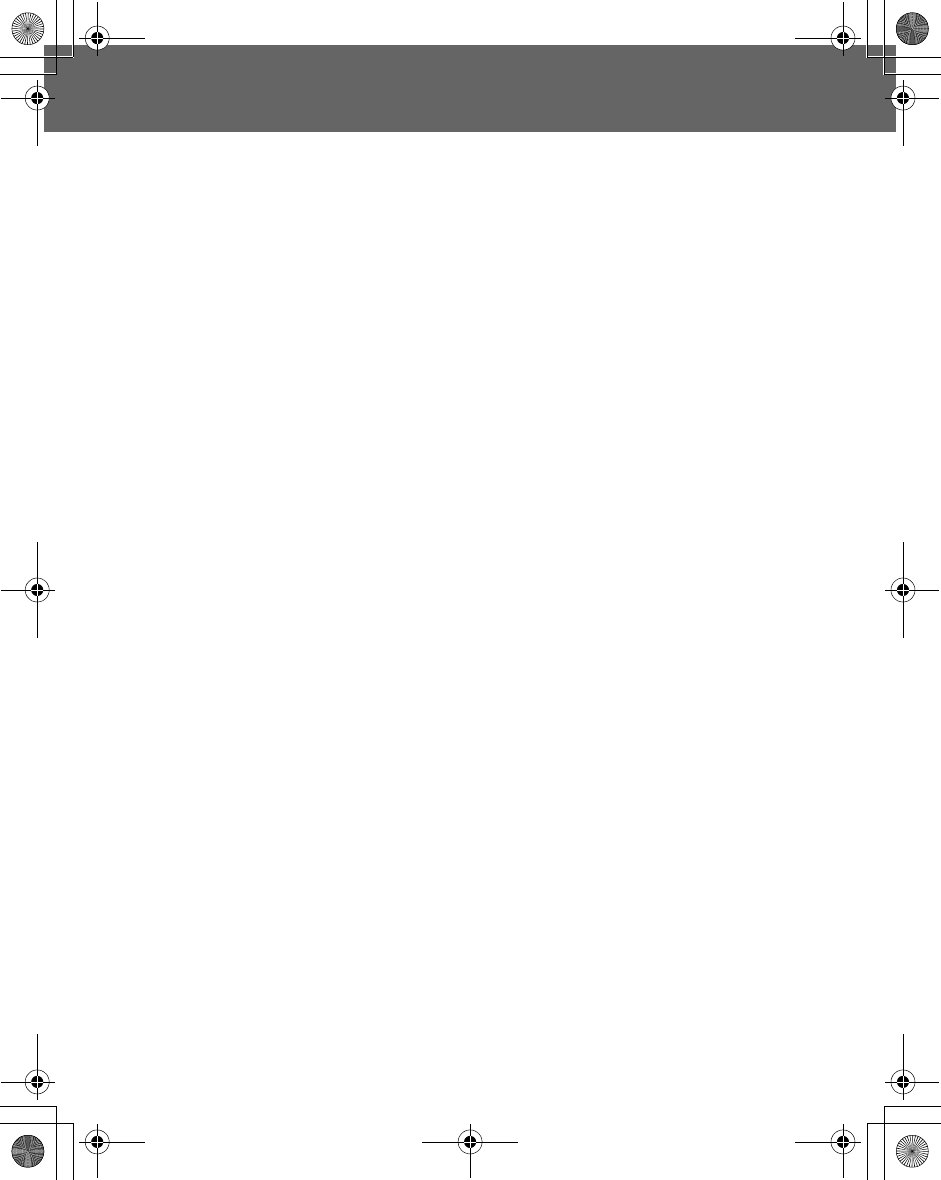
Contents i
Contents
Introduction ........................1
Safety Considerations................ 1
Care and Maintenance .......5
Getting Started ...................6
Your phone................................. 6
Key functions.............................. 7
Displays...................................... 9
Fitting and removing the battery
.. 11
Fitting and removing the SIM ... 12
Charging the battery................. 12
Battery level indicator............... 13
Low battery power warning ...... 13
Symbols used in this manual ... 13
Basic Operations..............14
Switching the phone on/off....... 14
Making a call ............................ 14
Answering a call....................... 16
In-call operations...................... 17
Incoming call while on a call..... 19
DTMF ....................................... 21
Text entry ................................. 22
Menu Display ........................... 24
Exploring the Menus........25
My Phone Menu................26
My Media.................................. 27
Sounds..................................... 30
Display ..................................... 32
Language ................................. 35
Alerts........................................ 35
Profiles ..................................... 36
Auto answer ............................. 40
Any key answer........................ 40
Auto key lock............................ 40
Shortcuts .................................. 41
Defaults.................................... 41
Contacts Menu..................42
Browsing the Contacts list ........ 43
Creating a Contacts list ............ 46
Groups...................................... 49
SDN.......................................... 49
Information number .................. 50
Memory status.......................... 50
My Numbers............................. 51
Hotkey dial................................ 52
My Contacts ............................. 52
Games Menu.....................53
Puddleland ............................... 53
Quadball................................... 54
Exode ....................................... 54
Browser Menu...................55
Server settings ......................... 56
Starting the Browser................. 57
Bookmarks ............................... 58
Push setting.............................. 59
Connectivity.............................. 60
Camera Menu....................61
Your camera............................. 62
Taking a picture........................ 63
Camera settings ....................... 66
Recording a video clip.............. 70
Messages Menu................73
MMS settings............................ 74
Creating an MMS message...... 76
Sending an MMS message ...... 78
Receiving an MMS message.... 78
Viewing an MMS message
in the Outbox.......................... 80
SMS settings ............................ 81
Creating an SMS message ...... 82
Receiving an SMS message .... 83
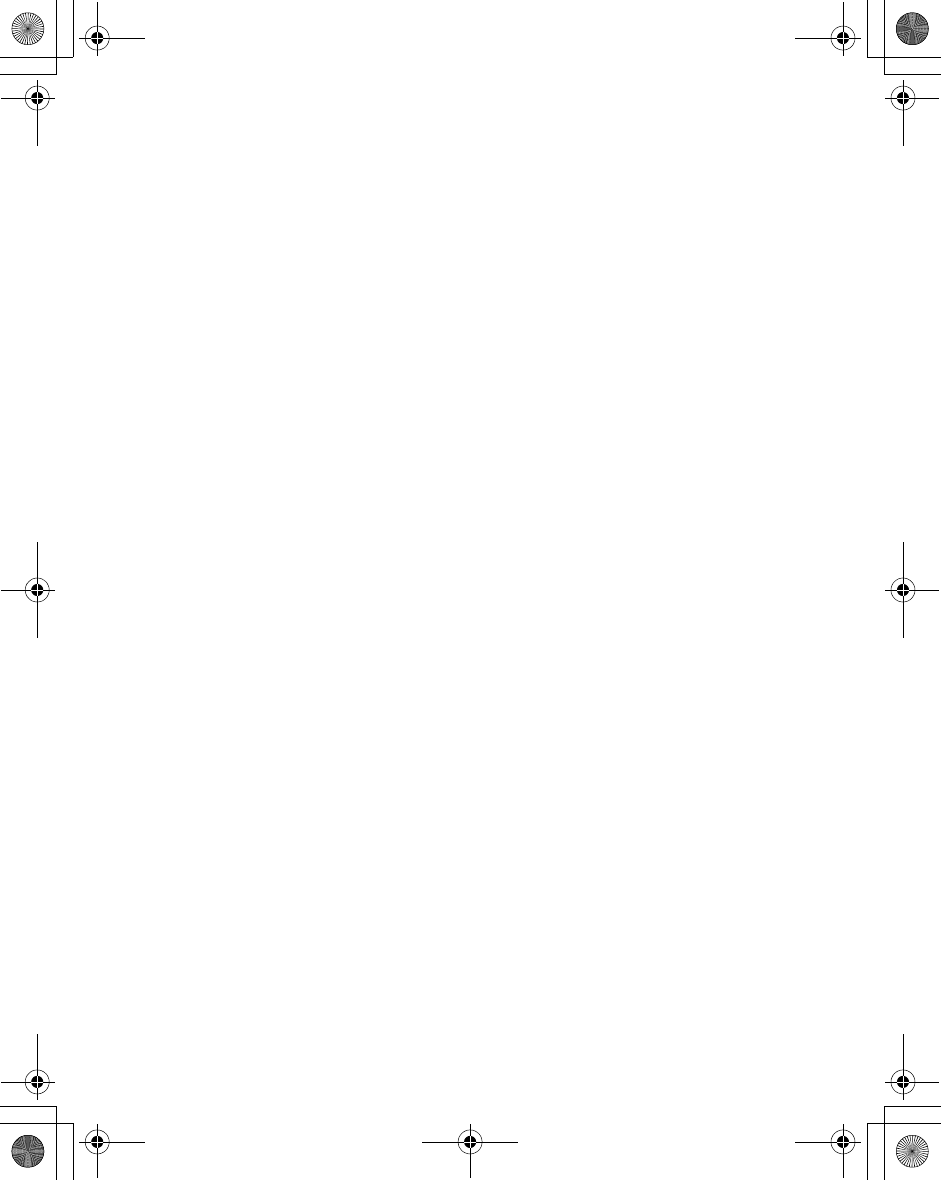
ii Contents
Viewing an SMS message
in the Outbox.......................... 84
User Messages ........................ 84
Memory status.......................... 85
Connectivity.............................. 85
Cell Broadcast.......................... 85
Phone Menu ..................... 88
Call Service .............................. 89
Call Diverts............................... 93
Security .................................... 94
Network .................................... 99
Records Menu................ 100
Last dialled/Answered/
Unanswered number............ 100
Deleting the records ............... 101
Applications Menu......... 102
Games.................................... 103
Calendar................................. 103
Scheduler ............................... 106
Notes...................................... 108
Clock ...................................... 108
Calculator ............................... 111
Currency................................. 112
Melody composer................... 113
Phone menu........................... 114
Troubleshooting ............ 115
Important Error
Messages...................... 117
Glossary of Terms......... 119
Specifications ................ 121
Index ............................... 123
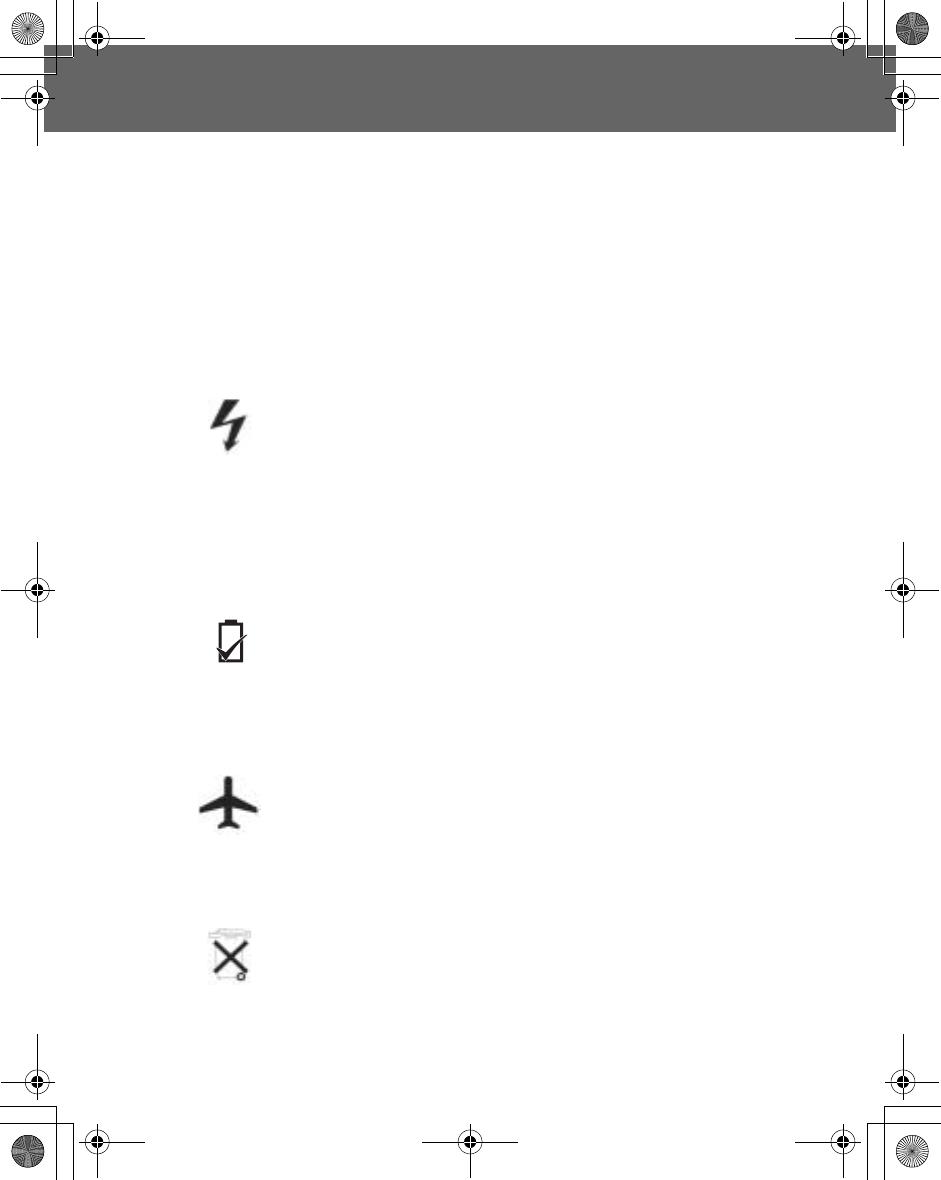
Introduction 1
Introduction
Thank you for purchasing this Panasonic digital cellular phone. This phone is designed
to operate on GSM networks – GSM900, GSM1800 and GSM1900. It also supports
GPRS for packet data connections.
Please ensure the battery is fully charged before use.
Safety Considerations
The following information should be read and understood as it provides details, which
will enable you to operate your phone in a manner which is both safe to you and your
environment, and conforms to legal requirements regarding the use of cellular phones.
This equipment should only be charged with approved charging
equipment to ensure optimum performance and avoid damage to
your phone. Other usage will invalidate any approval given to this
apparatus and may be dangerous. Ensure the voltage rating of
the Travel Charger is compatible with the area of use when
travelling abroad.
A Travel Charger EB-CAG70xx* is supplied with the Main Kit.
NOTE*: xx identifies the charger region, e.g. CN, EU, UK, AU, US.
Use of another battery pack than that recommended by the
manufacturer may result in a safety hazard.
Switch off your cellular phone when in an aircraft. The use of
cellular phones in an aircraft may be dangerous to the operation
of the aircraft, disrupt the cellular network and may be illegal.
Failure to observe this instruction may lead to the suspension or denial
of cellular phone services to the offender, or legal action or both.
Do not incinerate or dispose of the battery as ordinary rubbish.
The battery must be disposed of in accordance with local
regulations and may be recycled.
Power
Battery
Aircraft
Disposing of
the Battery
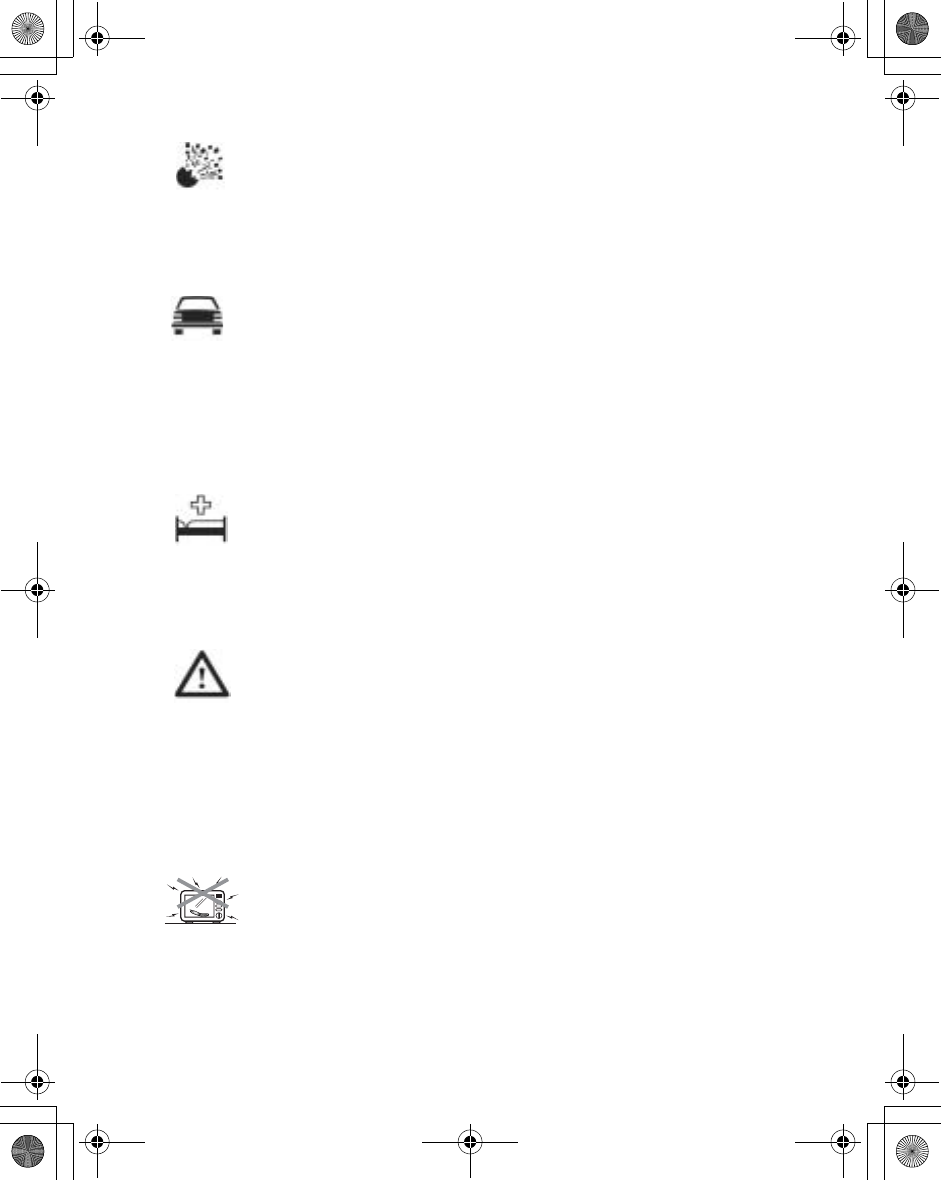
2 Introduction
It is advised not to use the equipment at a refuelling point.
Users are reminded to observe restrictions on the use of radio
equipment in fuel depots, chemical plants or where blasting
operations are in progress. Never expose the battery to extreme
temperatures (in excess of 60°C).
It is imperative that the driver exercises proper control of the
vehicle at all times. Do not hold a phone while you are driving; find
a safe place to stop first. Do not speak into a handsfree
microphone if it will take your mind off the road. Always acquaint
yourself thoroughly with restrictions concerning the use of cellular
phones within the area where you are driving and observe them
at all times.
Care must be taken when using the phone in close proximity to
personal medical devices, such as pacemakers and hearing aids.
For most efficient use, hold the phone as you would any normal
phone. To avoid deterioration of signal quality or antenna
performance, do not touch or “cup” the antenna area while the
phone is switched on. Do not leave the camera facing direct
sunlight to avoid impairing camera performance. Unauthorised
modifications or attachments may damage the phone and violate
applicable regulations. The use of an unapproved modification or
attachment may result in the invalidation of your guarantee – this
does not affect your statutory rights.
When your handset, the accompanying battery or charging
accessories are wet, do not put those in any type of heating
equipment, such as a microwave oven, a high pressure container,
or a drier or similar. It may cause the battery, handset and/or
charging equipment to leak, heat up, expand, explode and/or
catch fire. Moreover, the product or accessories may emit smoke
and their electrical circuits may become damaged and cause the
Do Not Use
Driving
Electronic
Devices
Efficient Use
Heating
Equipment
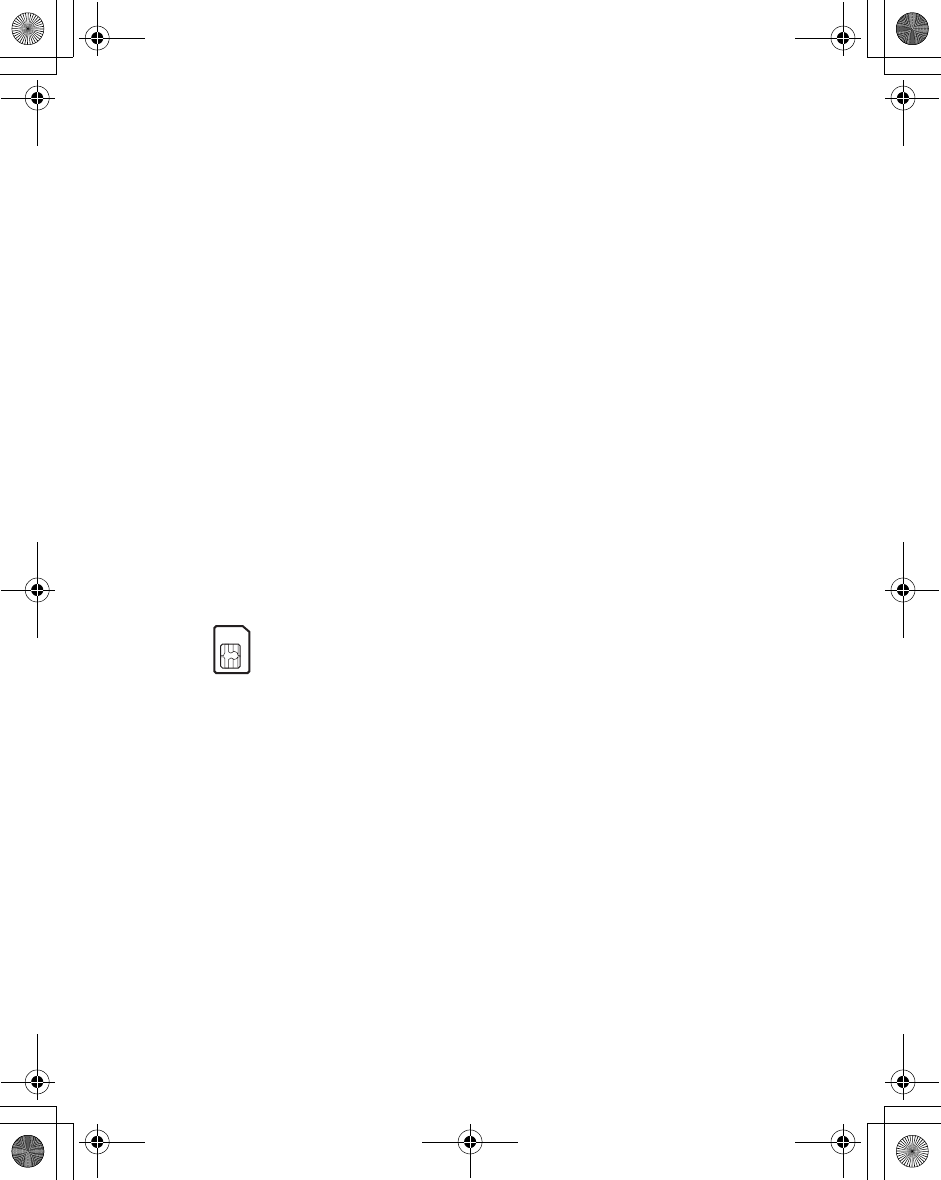
Introduction 3
products to malfunction. Panasonic is not responsible for any and
all damages, whether direct or indirect, howsoever caused by any
misuse.
The colour liquid crystal display (LCD) uses high-precision
production technology, and in certain circumstances pixels may
appear brighter or darker. This is due to characteristics of the LCD
and is not a manufacturing defect.
This equipment should only be used with Panasonic approved
accessories to ensure optimum performance and avoid damage
to your phone. Panasonic is not responsible for damage caused
by using non-Panasonic approved accessories.
This phone must be used in compliance with any applicable
international or national law or any special restrictions governing
its use in specified applications and environments. This includes
but is not limited to use in hospitals, aircraft, whilst driving and any
other restricted uses.
It is recommended that you create a copy or backup, as
appropriate, of any important information and data which you
store in your phone’s memory. In order to avoid accidental loss of
data, please follow all instructions relating to the care and
maintenance of your phone and its battery. Panasonic accepts no
liability for any and all losses howsoever arising from any loss of
data, including but not limited to direct and indirect losses (to
include, but not limited to consequential loss, anticipated savings,
loss of revenue).
Your phone has the capability of storing and communicating
personal information. It is recommended that you take care to
ensure that any personal or financial information is stored
separately from your phone. You should use security features,
such as the SIM lock to protect information held in your phone.
Panasonic accepts no liability for any and all losses howsoever
arising from any loss of data, including but not limited to direct and
indirect losses (to include, but not limited to consequential loss,
anticipated savings, loss of revenue).
Backup Copies
and Security
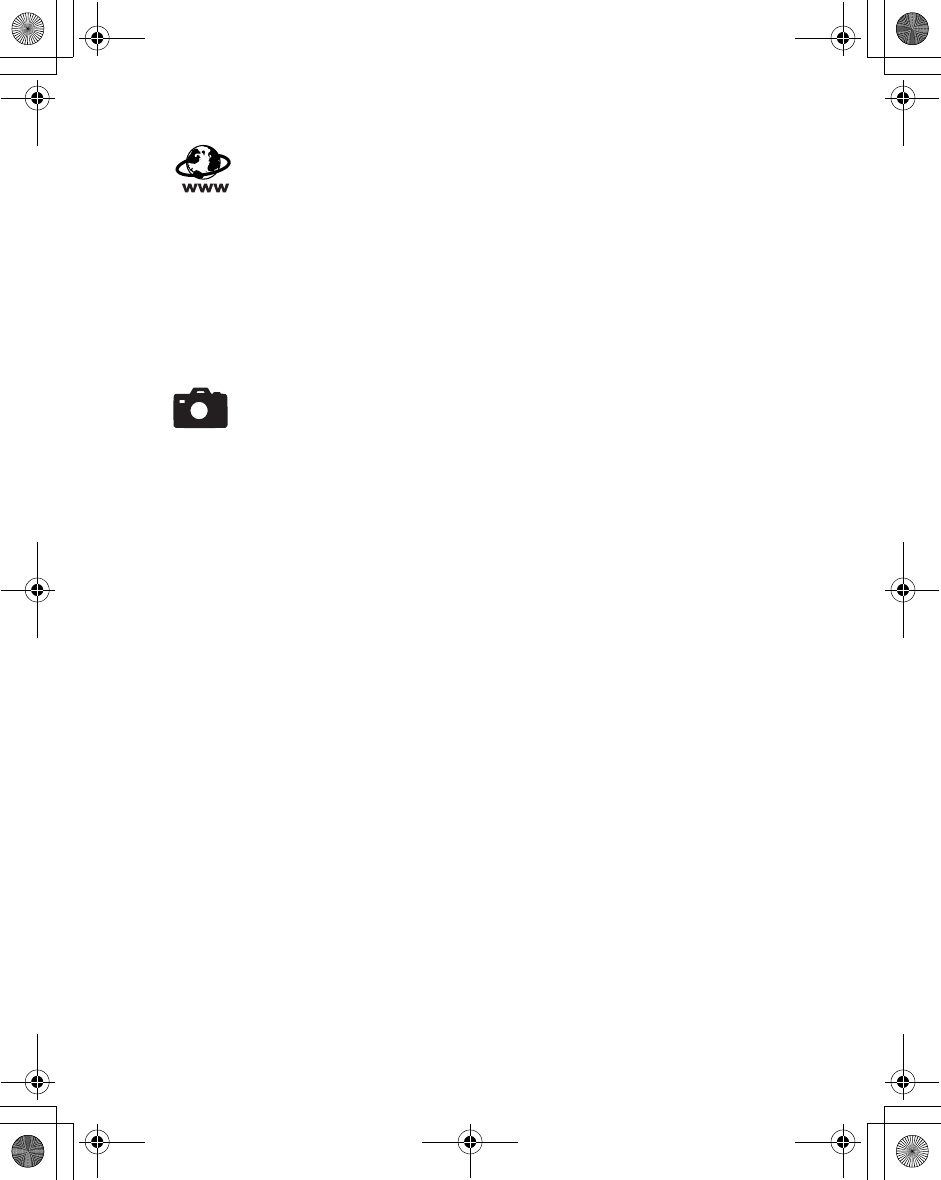
4 Introduction
Your phone has the capability of downloading and storing
information and data from external sources. It is your
responsibility to ensure that in doing this you are not infringing any
copyright laws or other applicable legislation. Panasonic accepts
no liability for any and all losses howsoever arising from any loss
of data or any such infringement of copyright or intellectual
property rights, including but not limited to direct and indirect
losses (to include, but not limited to consequential loss,
anticipated savings, loss or revenues).
You are advised to take appropriate care over the use of the
internal camera. It is your responsibility to ensure that you have
permission to take photographs of people and objects and that
you do not infringe any personal or third party rights when using
the camera. You must comply with any applicable international or
national law or other special restrictions governing camera use in
specific applications and environments. This includes not using
the camera in places where the use of photographic and video
equipment may be prohibited. Panasonic accepts no liability for
any and all losses howsoever arising from any infringement of
copyright or intellectual property rights, including but not limited to
direct and indirect losses.
The display layouts and screenshots within this document are for
illustrative purposes and may differ from the actual displays on
your phone. Panasonic reserves the right to change the
information in this document without prior notice.
This Panasonic mobile phone is designed, manufactured and
tested to ensure that it complies with the specifications covering
RF exposure guidelines applicable at the time of manufacture, in
accordance with EU, USA FCC, and Australian ACA regulations.
Please refer to our website for latest information/standards and
compliance in your country/region of use.
http://www.panasonicmobile.com
Downloading
Camera
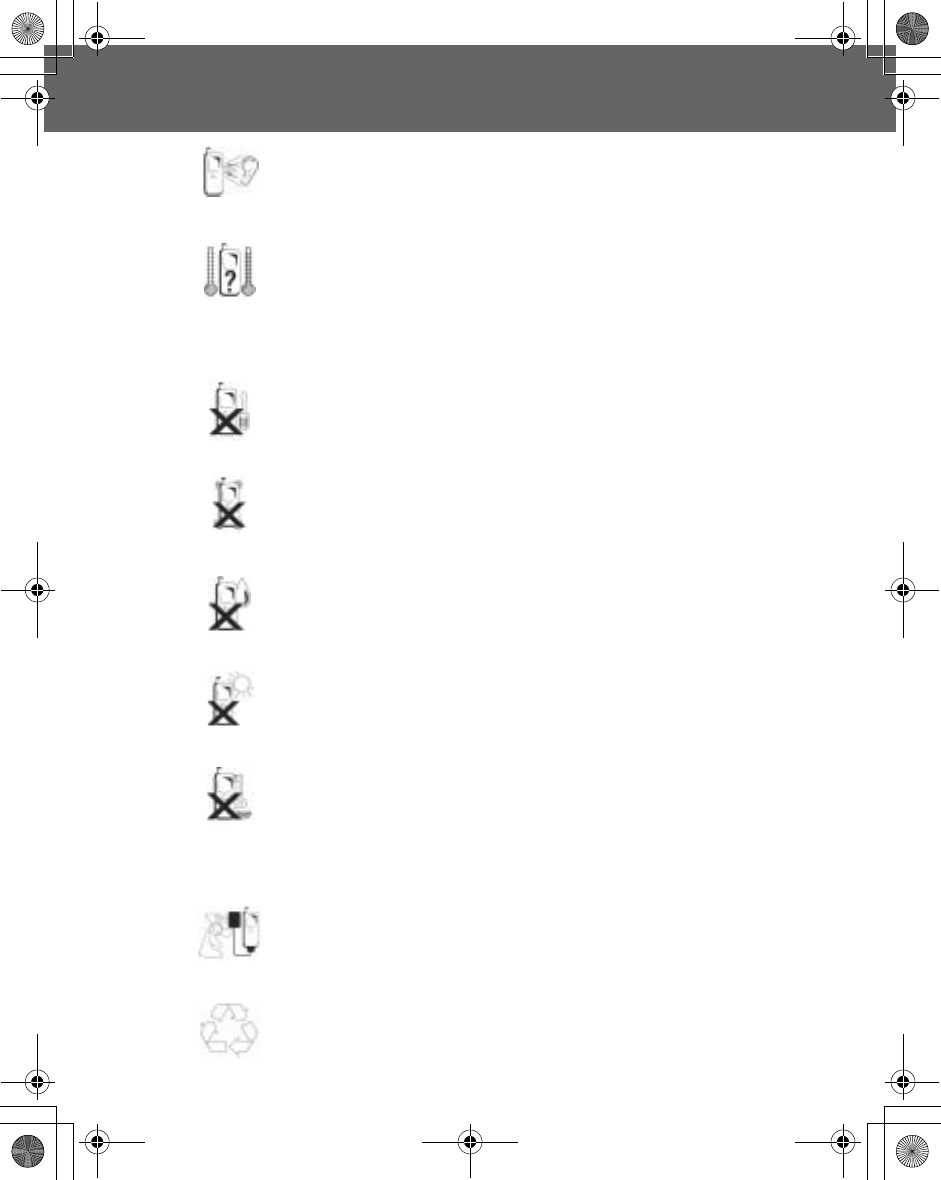
Care and Maintenance 5
Care and Maintenance
Pressing any of the keys may produce a loud tone. Avoid holding
the phone close to the ear while pressing the keys.
Extreme temperatures may have a temporary effect on the
operation of your phone. This is normal and does not indicate a
fault.
The display quality may deteriorate if the phone is used in
environments over 40°C for a long time.
Do not modify or disassemble the equipment. There are no user
serviceable parts inside.
Do not subject the equipment to excessive vibration or shocks.
Do not drop the battery.
Avoid contact with liquids. If the equipment becomes wet,
immediately remove the battery and contact your dealer.
Do not leave the equipment in direct sunlight or a humid, dusty or
hot area.
Never throw a battery into a fire. It may explode.
Keep metallic items that may accidentally touch the terminals
away from the equipment/battery.
Batteries can cause property damage, injury, or burns if terminals
are touched with a conductive material (i.e. metal jewellery, keys,
etc.).
Always charge the battery in a well ventilated area, not in direct
sunlight, between +5°C and +35°C. It is not possible to recharge
the battery if it is outside this temperature range.
When disposing of any packing materials or old equipment, check
with your local authorities for information on recycling.
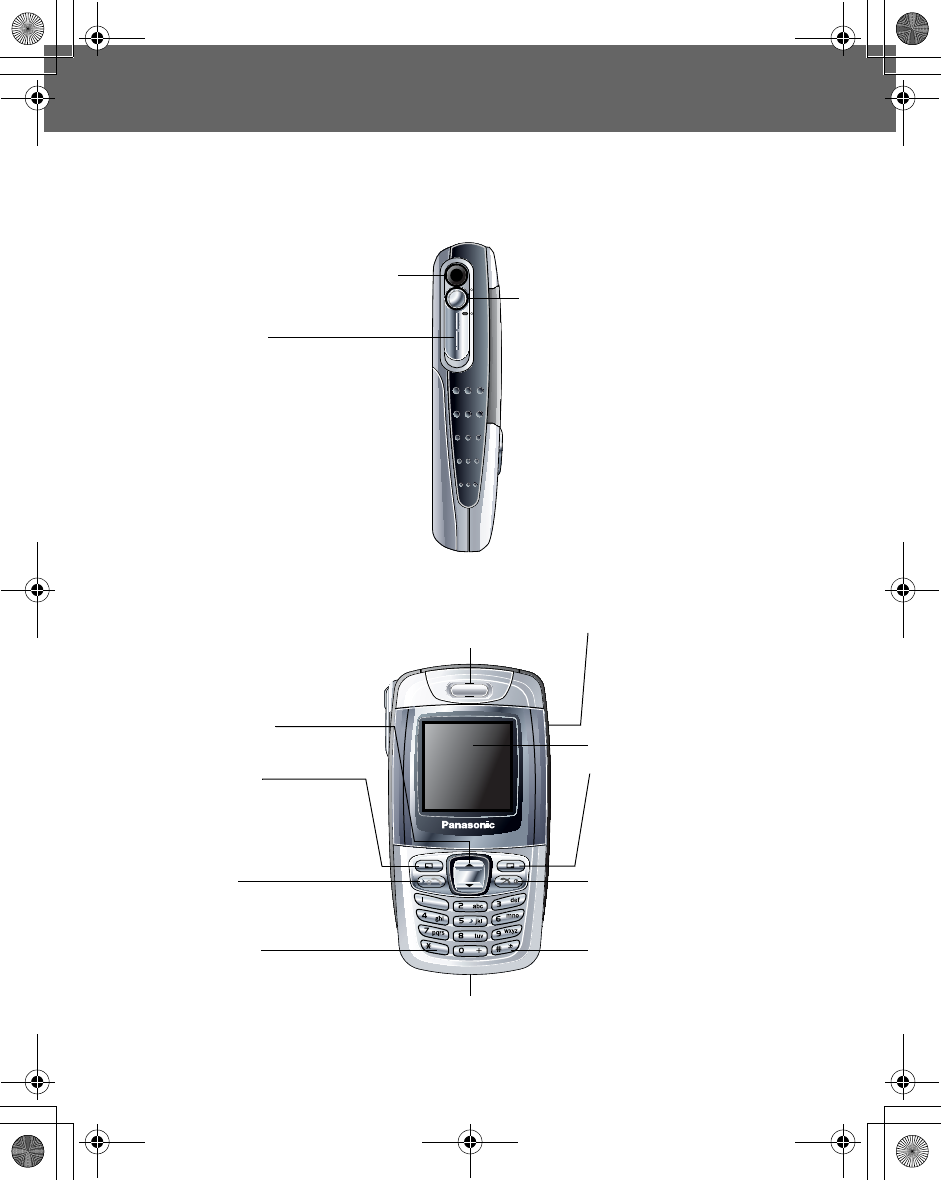
6 Getting Started
Getting Started
Your phone
(Side view)
(Front view)
Camera Lens
Lens Cover:
Slide halfway down to activate
the camera.
Slide the cover all the way down
to pop open the display.
Earpiece
Display
Shutter Key:
Take a picture/record a
video clip.
Switch Camera Preview
mode on.
Navigation Key:
Scroll/move through menus.
Right Soft Key:
Cancel/Exit.
Perform functions indicated
in the lower right-hand
corner of the display.
Power/End Key:
Press and hold to switch
the phone on/off.
Silent Mode Key:
Press and hold to switch
the Silent Mode on/off.
Charging
Connector
Asterisk Key:
Press and hold to activate
the Browser.
Send Key:
Answer/make a call.
Left Soft Key:
Perform functions indicated
in the lower left-hand corner
of the display.
Self-portrait Mirror
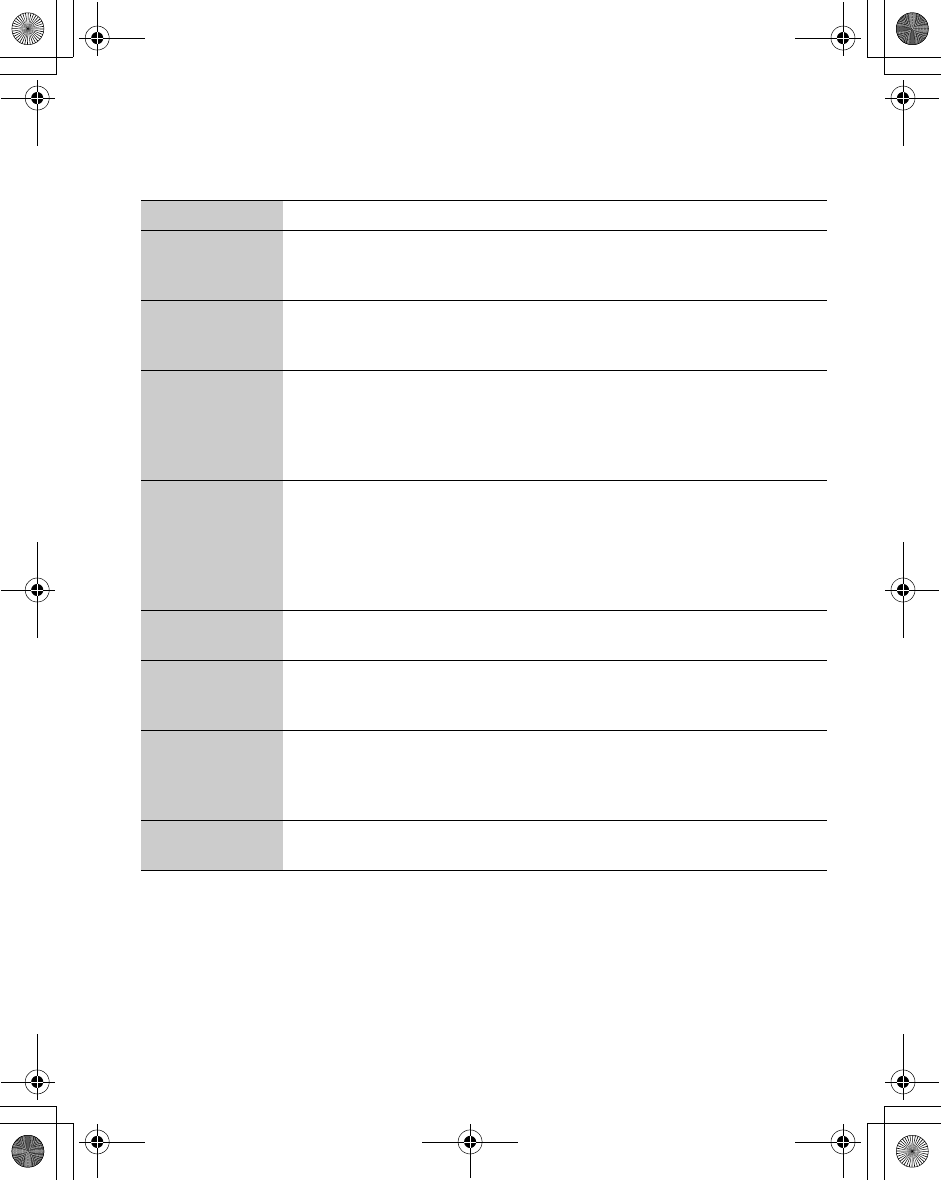
Getting Started 7
Key functions
Key Function
4Navigation Key: Scroll or move through menus, text and phone numbers.
In idle mode, press to activate the Shortcuts menus or press and hold 1 to
turn the Auto Key lock on.
ALeft Soft Key: Perform the functions indicated by text shown in the lower
left-hand corner of the display. In idle mode, press to activate the Menu
display, or press and hold to activate the Messages menu.
@
Right Soft Key: Perform the functions indicated by text shown in the lower
right-hand corner of the display. Mainly used to cancel and return to the
previous menu level. In text entry mode, press to delete text. In idle mode,
press to access the Contacts list, or press and hold to activate the Profiles
menu.
# ~ ,
Numeric Keys: Enter numbers. Press and hold one of the keys from %
to , for Hotkey dialling, or $ for voice message setting. In text entry
mode, enter text, numbers and characters. Press and hold # to enter a
“+” (international access code) or “P” (extension number code). To dial an
extension number, dial the phone number first, press and hold # to add
a “P”, then enter the extension number.
CSend Key: Make a call or answer a call. In idle mode, press to check the last
dialled list. In text entry mode, press to switch between input methods.
DPower/End Key: End/reject a call. During key operations, press to return to
the previous display or press and hold to return to idle mode. In idle mode,
press and hold to switch the phone on/off.
!Silent Mode Key: In idle mode, press to enter “#”, or press and hold to
switch the Silent Mode (Vibration on/Ring off) on/off. In text entry mode,
press to switch T9 smart English input mode on/off, or press and hold to
enter characters.
"Asterisk Key: In idle mode, press to enter “ ”, or press and hold to activate
the Browser.
"
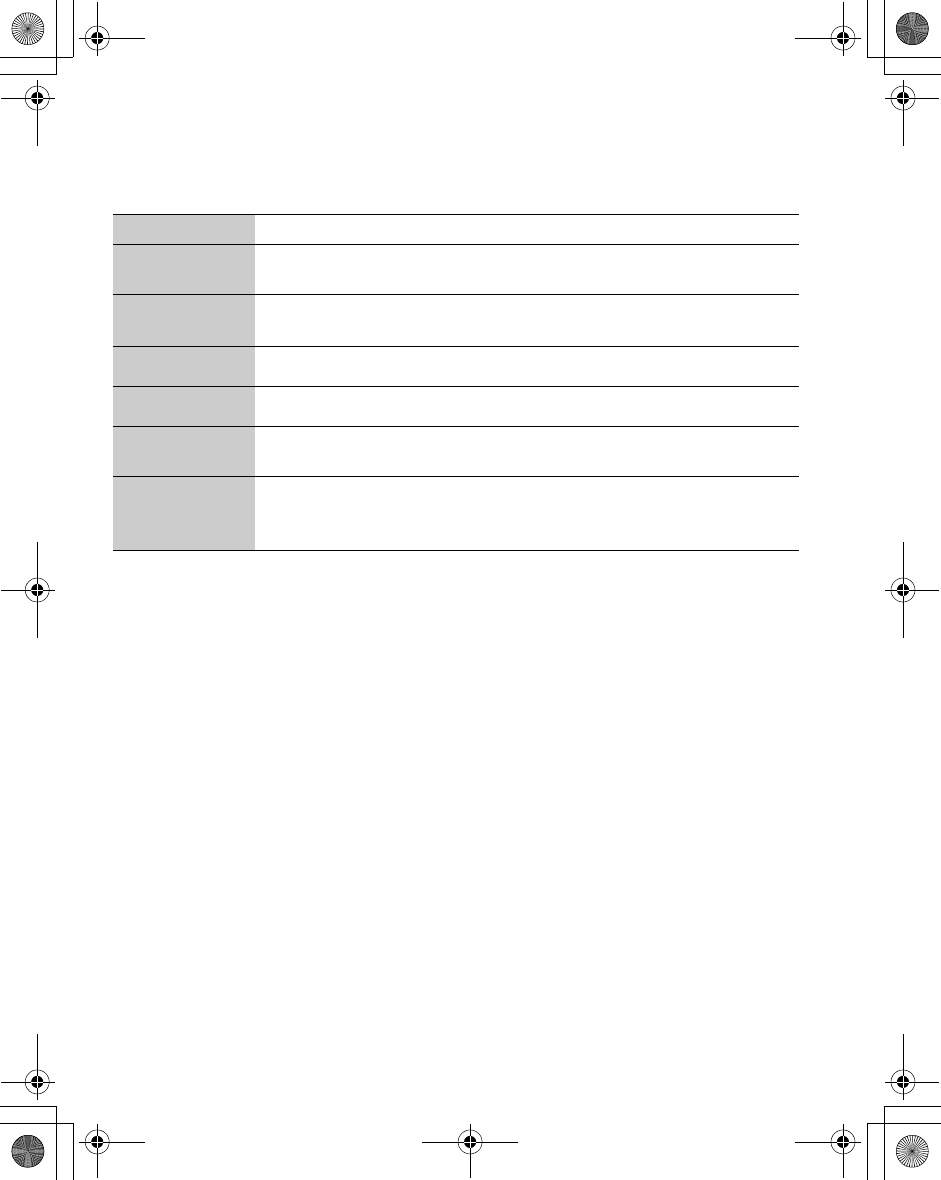
8 Getting Started
During a call
Minimal menu options are available during a call by pressing the following keys.
In Camera Preview mode
Shutter Key: Press to take a picture or record a video clip.
Key Function
AActivate Hands free/Hand held, Conference call, Call transfer, End, Split,
Contacts list, Messages menu, Call status.
@Put the call on hold or resume while connected to a calling party.
Swap among calls while connected to two or more calling parties.
1Increase the volume.
5Decrease the volume.
CDisplay the last dialled records list. Answer another call. If a phone number
is entered, hold the active call and call the number.
#~,
!" Send DTMF. Press and hold ! to switch the Hands free speaker on/off.
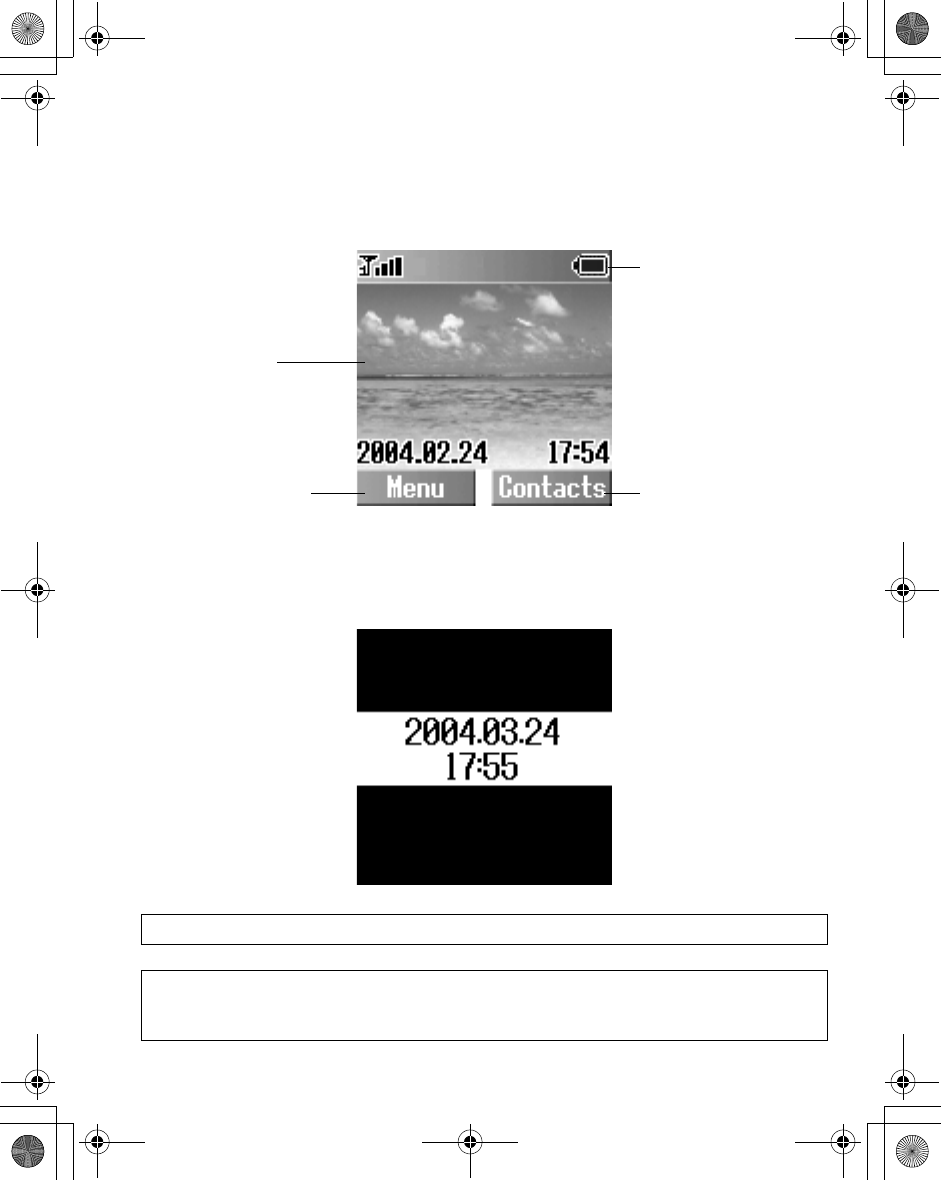
Getting Started 9
Displays
Idle display
Idle clock
The clock appears on the display one minute after you press the last key.
NOTE: All screen images in this manual are simulated.
NOTE: Some services described in this manual are network dependent or may only be available
on a subscription basis. Some functions are SIM dependent. For more information, contact your
service provider.
Status icons
Right Soft Key
Selection Area
Left Soft Key
Selection Area
Wallpaper
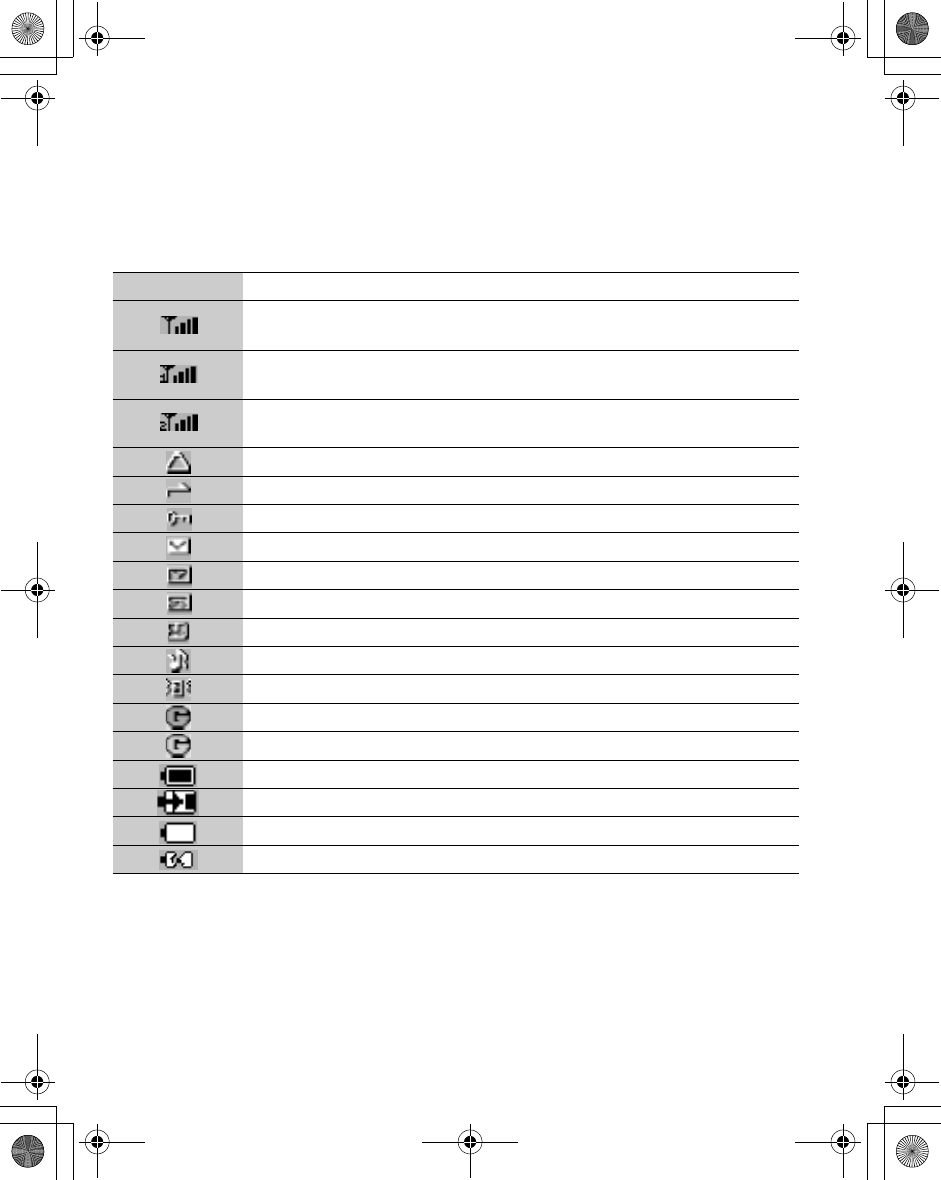
10 Getting Started
Status icons
The status icons are displayed or animated according to the currently activated
functions. The Antenna, Signal and Battery icons are displayed when the handset is
switched on and connected to a network. If there is no network connection, the Signal
icon will not be displayed.
Icon Meaning
Indicate the received signal strength – No CPHS.
Indicate the received signal strength and Line 1 is enabled. The SIM supports
CPHS.
Indicate the received signal strength and Line 2 is enabled. The SIM supports
CPHS.
Registered to a non-home network – roaming.
Call Diverts is on.
Auto key lock is enabled.
Message area is full.
Unread message is stored.
Voice mail indicator (voice mail has been received) – No CPHS
Alarm is set.
All tones or ring volume is off.
Vibration alert is on.
GPRS is active.
GPRS service is available.
Battery charged.
Battery is charging.
Low battery
Abnormal charging
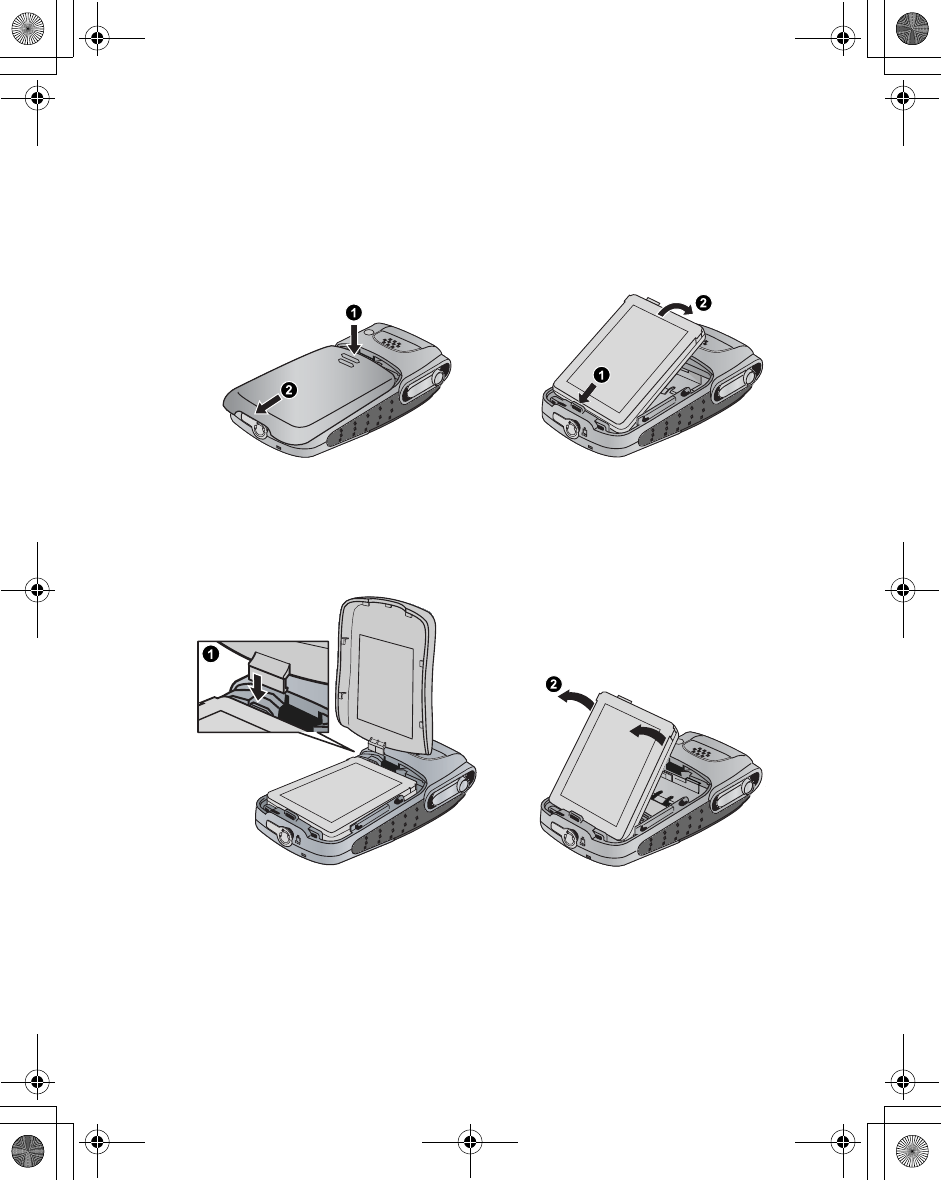
Getting Started 11
Fitting and removing the battery
Before removing the battery, ensure that the phone is switched off and the charger is
disconnected from the phone.
Remove the battery compartment cover.
Insert the battery, ensuring the 3 gold contacts align with the 3 gold pins in the phone.
Fitting the battery
Removing the battery
Push and hold the release latch ò towards the top of the phone using the cover clip,
then lift the battery out ù.
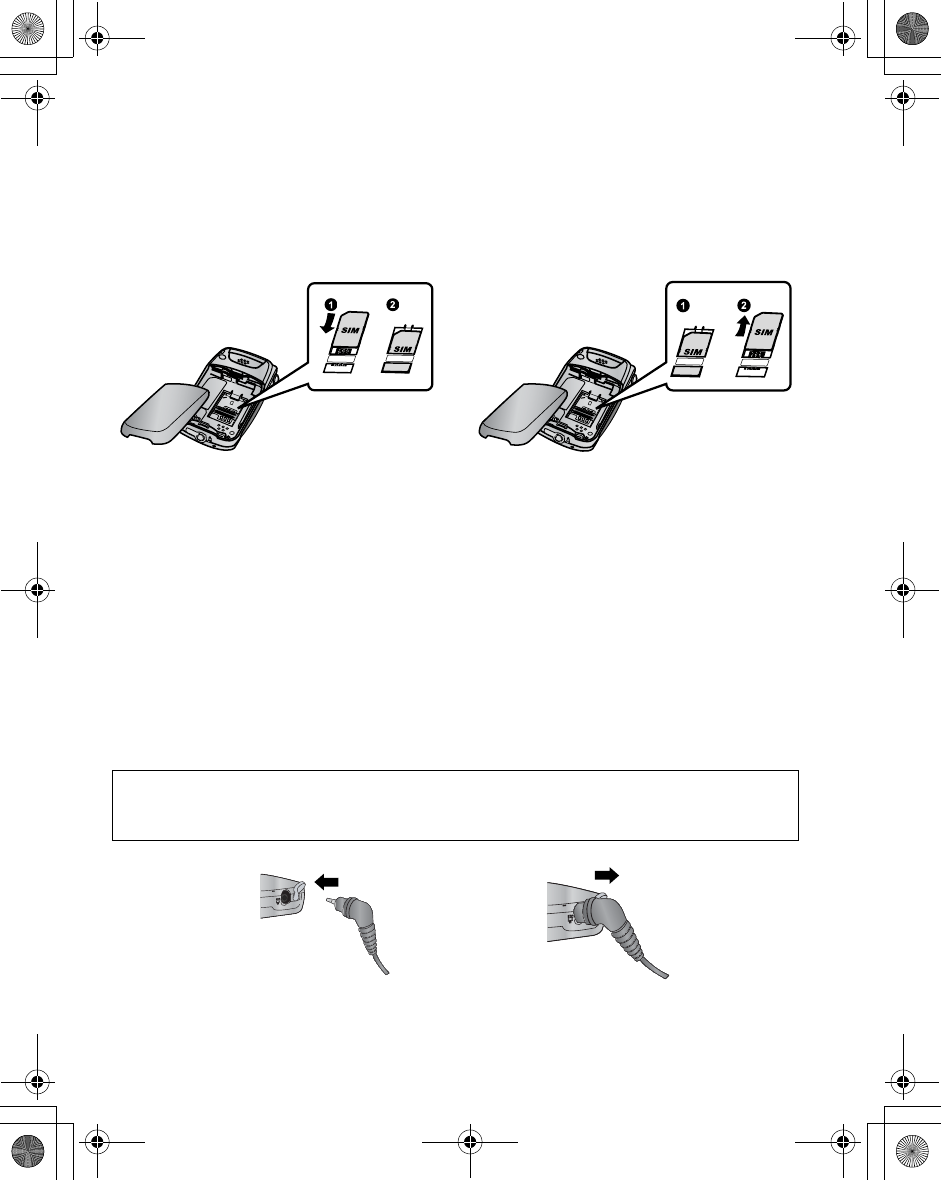
12 Getting Started
Fitting and removing the SIM
The SIM is inserted under the battery.
Charging the battery
Connecting and disconnecting the Travel Charger
The battery must be fitted in the phone before the charger is connected. Insert the
Charging Connector into the socket at the base of the phone before connecting the
charger to the mains outlet. Once connected, the Battery level indicator will start
scrolling (see "Battery level indicator" on page 13). It is recommended to charge the
battery for a minimum of 4 hours before first use.
When charging is complete, disconnect the charger from the outlet before removing the
plug from the phone.
NOTE: DO NOT force the connector as this may damage the phone and/or the charger. If the
battery has been deeply discharged, it may take several minutes before the Battery level
indicator is displayed.
Fitting the SIM Removing the SIM
Ensure the gold contacts are facing downwards
before sliding the SIM into the SIM holder. Whilst holding the tab down, slide the SIM out.
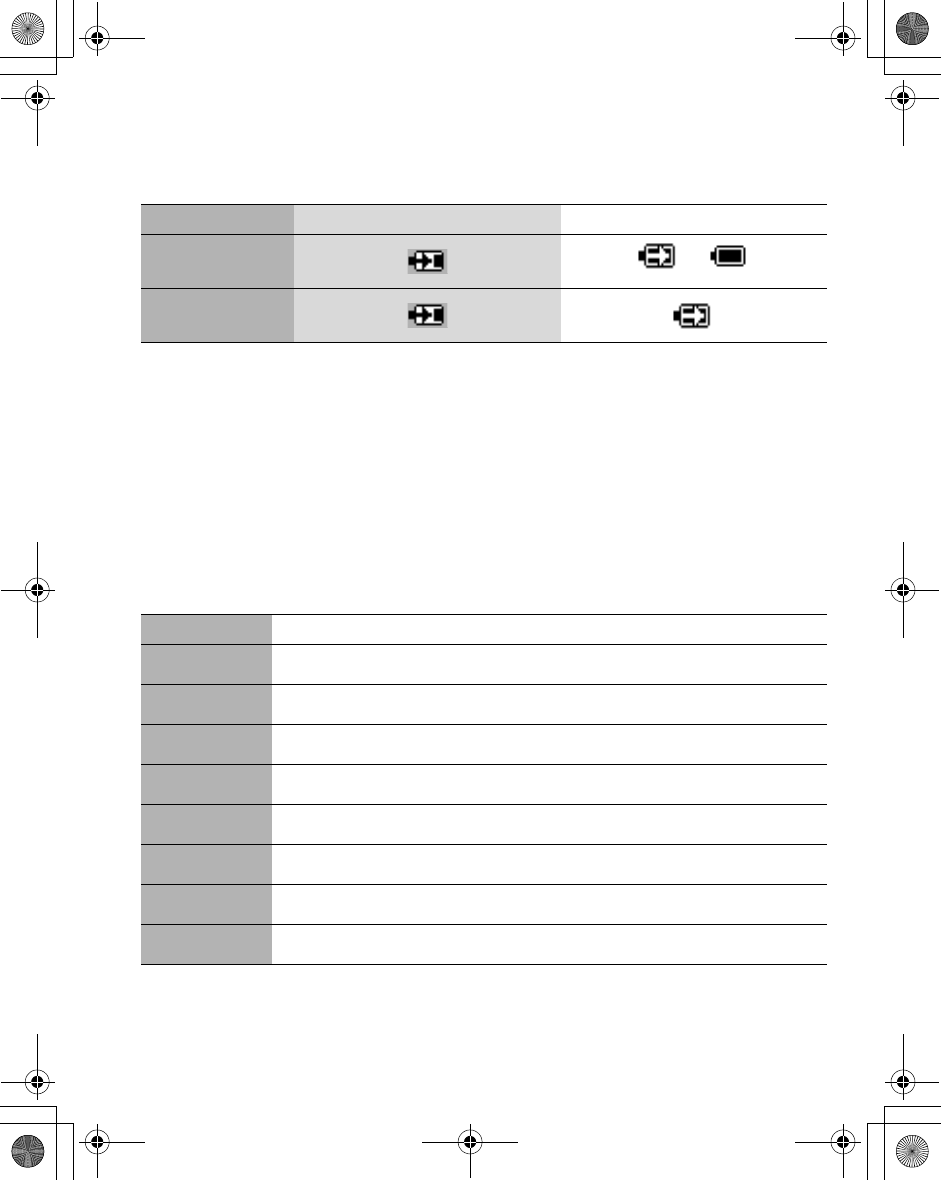
Getting Started 13
Battery level indicator
Low battery power warning
When the battery power is low, a “Battery is low” message will be displayed. If this
occurs during conversation, finish your call immediately. The power will automatically
switch off after the warning tone. Fully recharge the battery. See "Charging the battery"
on page 12. (Calls can be made and received while the phone is charging.)
Symbols used in this manual
Phone Status While charging Charging complete
Phone on >
Phone off
Symbols Meaning
154 Press Navigation Key in the direction indicated by the arrow.
APress Left Soft Key.
@Press Right Soft Key.
#~,Press Numeric Keys.
CPress Send Key.
DPress Power/End Key.
"Press Asterisk Key.
!Press Silent Mode Key.
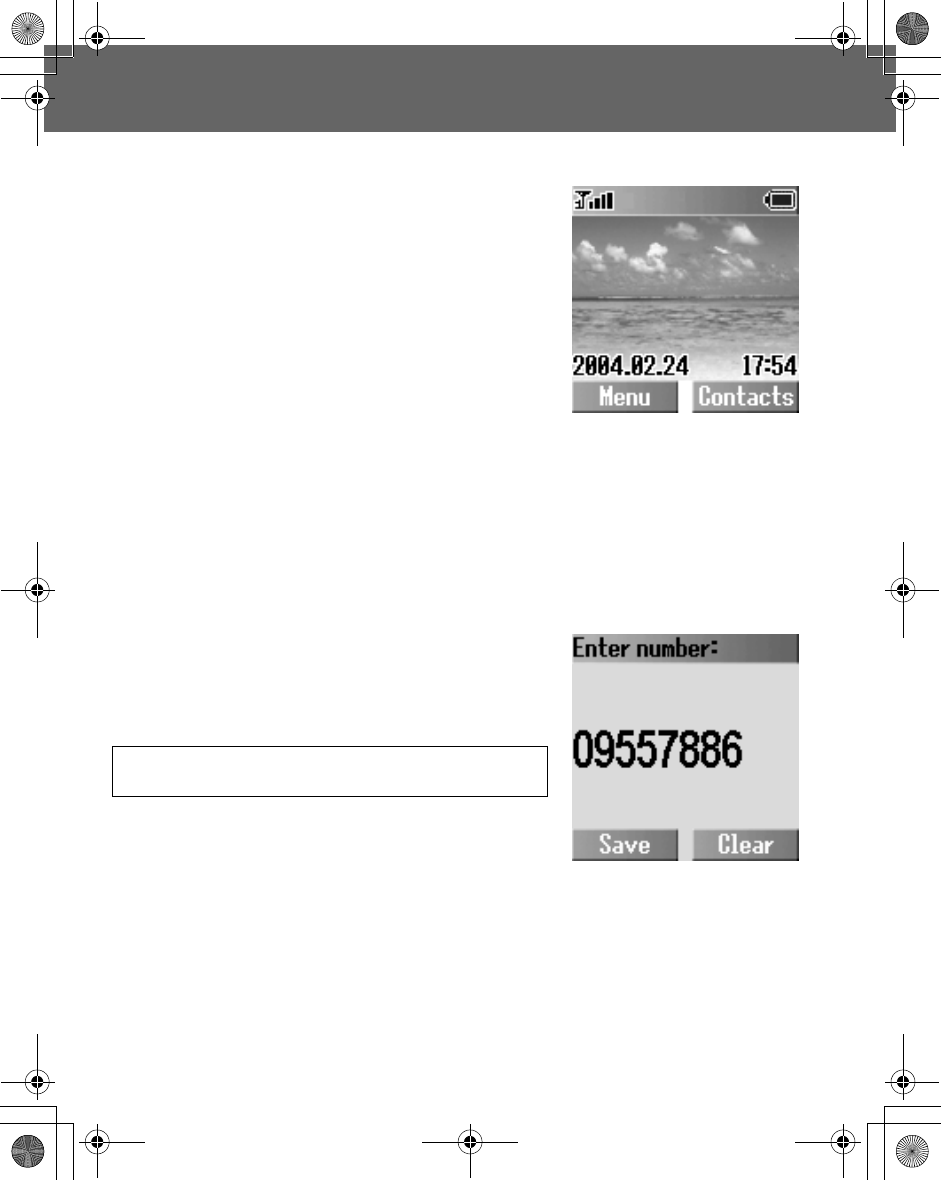
14 Basic Operations
Basic Operations
Switching the phone on/off
1. Press and hold D for 2 to 3 seconds
2. The phone starts in idle mode
3. Press and hold D again to switch the power off
Making a call
Ensure that the signal strength meter shows network coverage is available in the current
area.
ãTo make a call, start in idle mode.
Standard dialling
1. Enter the area code and phone number C
ãThe dialled number is displayed.
2. When the other party answers, talk into the
microphone
Contacts dialling
1. @(Contacts)
2. 4required phone number C
Earpiece volume: During a call, press 4to adjust the
earpiece volume.
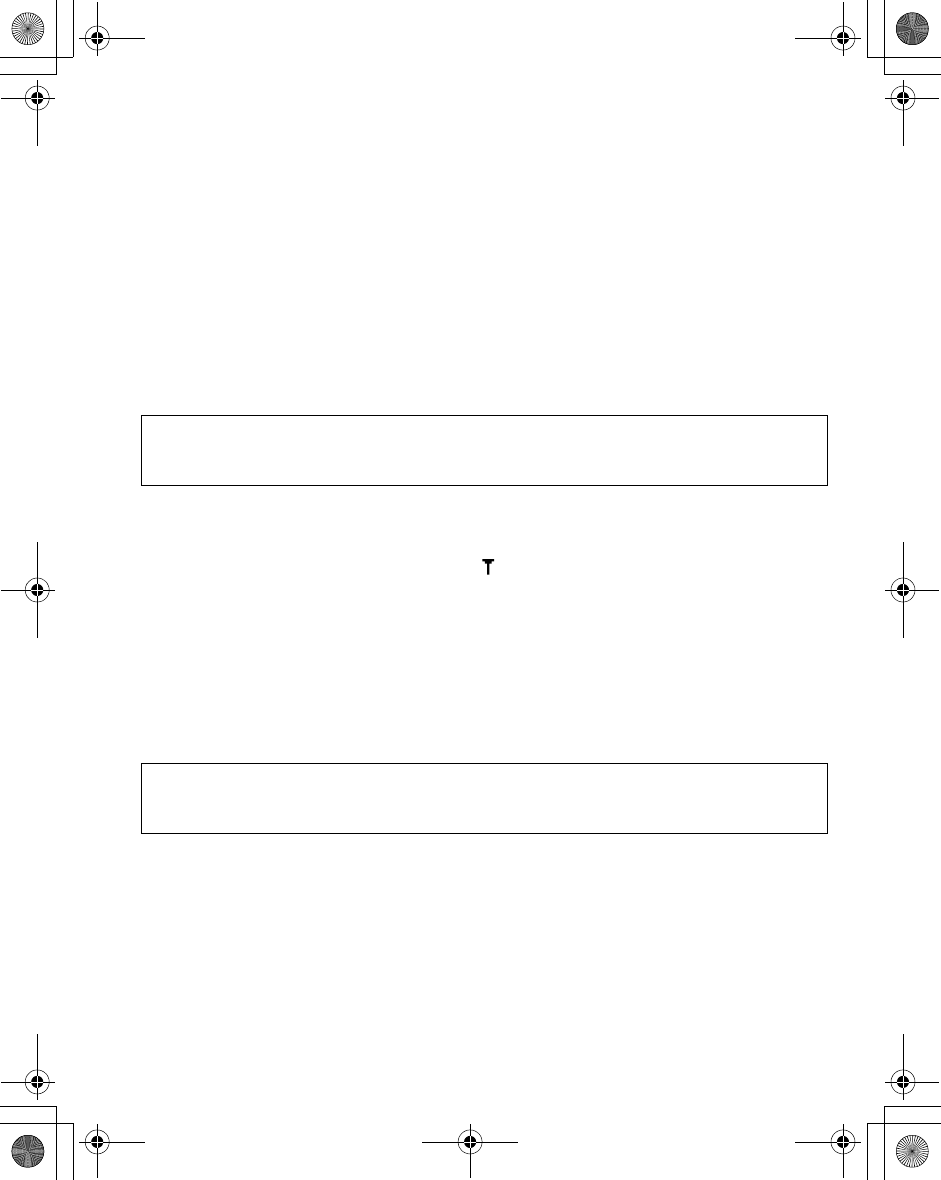
Basic Operations 15
Last number dialling
1. C
2. 4required phone number C
International dialling
The international access code (+) and the destination country/region code should be
entered, followed by the area code and phone number.
1. Press and hold #until “+” is displayed, then enter the country/region code
2. Enter the area code and phone number C
Emergency call
To make an emergency call, the antenna ( ) must be present.
When SIM is inserted:
Enter the emergency number 112 C
When SIM is not inserted:
Enter the emergency number 112 C
OR
@(SOS) > “Emergency call”A(Yes)
Ending a call
To hang up,D
ãThe duration of the call will be displayed.
ãIf Max cost is on, the remaining units will be displayed.
For setting "Max cost", please refer to page 92.
NOTE: Many countries/regions include an initial “0” in the area code. This should, in most cases,
be omitted when dialling international numbers. If you have difficulties making international calls,
contact your service provider.
NOTE: Most countries support the international emergency number 112. If you find the number
does not work on your phone, please call your service provider. Making emergency calls without
a SIM is country or network operator dependent.
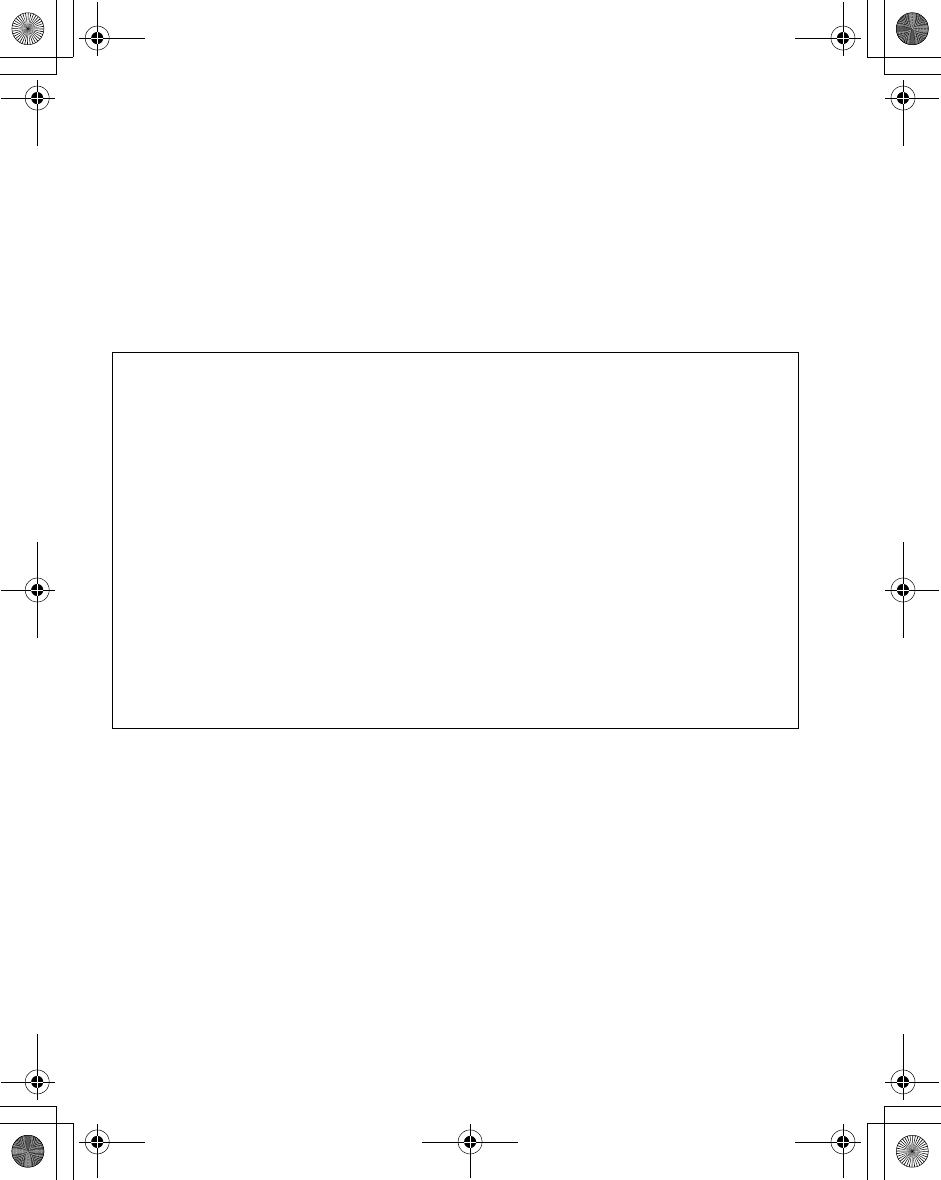
16 Basic Operations
Answering a call
C
OR
If “Any key answer” is on,
In idle mode
press any key except D
(See “Any key answer” on page 40.)
Rejecting an incoming call:
Press D
Ring volume:
From My Phone
1. 4Sounds > Volume A(Select)
2. 4 required Ringtone A(Select)
3. 4 Adjust the volume level A(OK)
One click mute on incoming call:
To set the ringtone and the vibration off,
@(Mute)
• To answer the call when Mute is enabled, A(Reply)
• To reject the call when Mute is enabled, @(Reject)
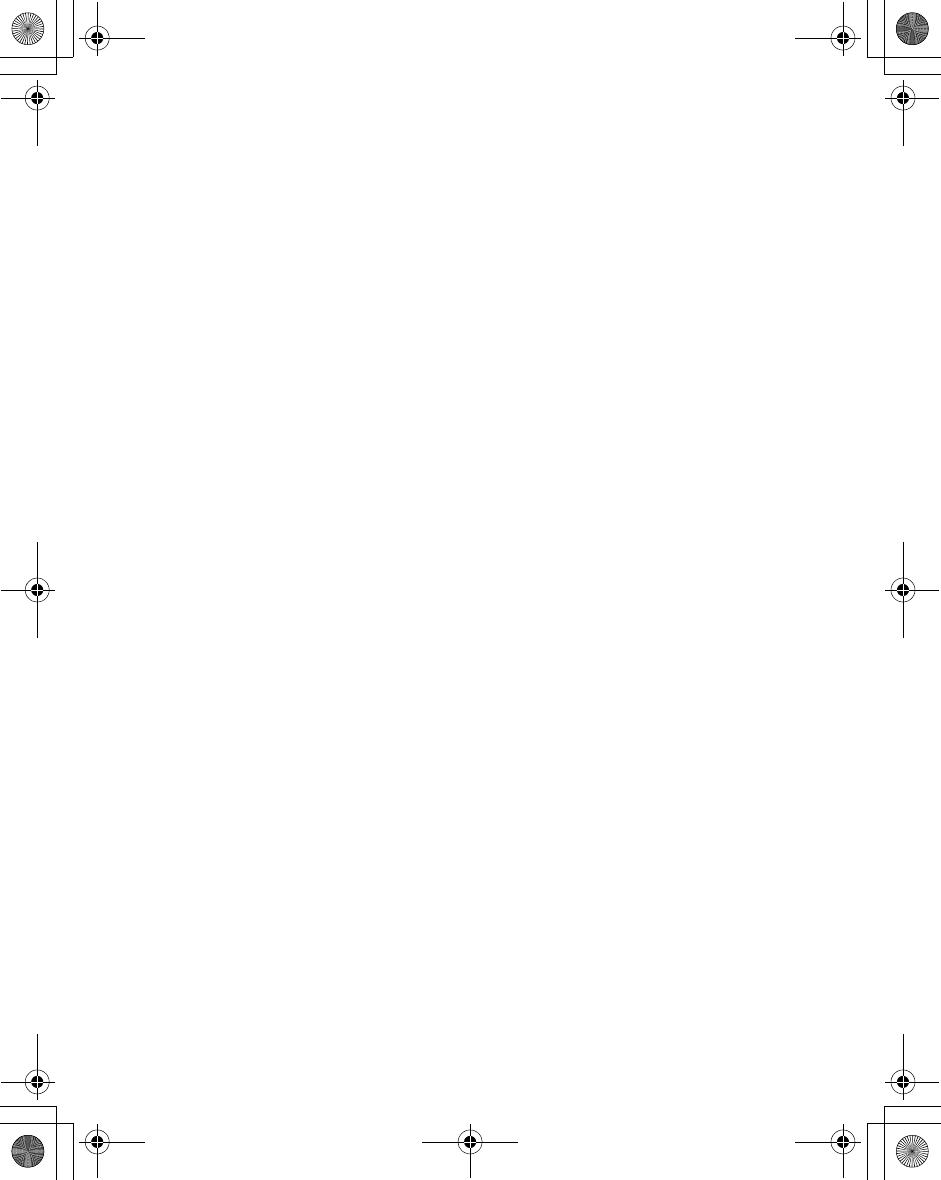
Basic Operations 17
In-call operations
During a call, the following options are available by pressing A(Menu) or @(Hold):
Hands free/Hand held
You can switch the phone between hands free and hand held.
During a call:
1. A(Menu)
2. 4 Hands free or Hand held A(Select)
Contacts list
You can access the Contacts list that is stored in the SIM or in your phone.
During a call:
1. A(Menu)
2. 4Contacts list A(Select)
Messages
You can create, check, or send a message while on a call.
Please refer to "Creating an MMS message" on page 76 or "Creating an SMS message"
on page 82.
During a call:
1. A(Menu)
2. 4 Messages A(Select)
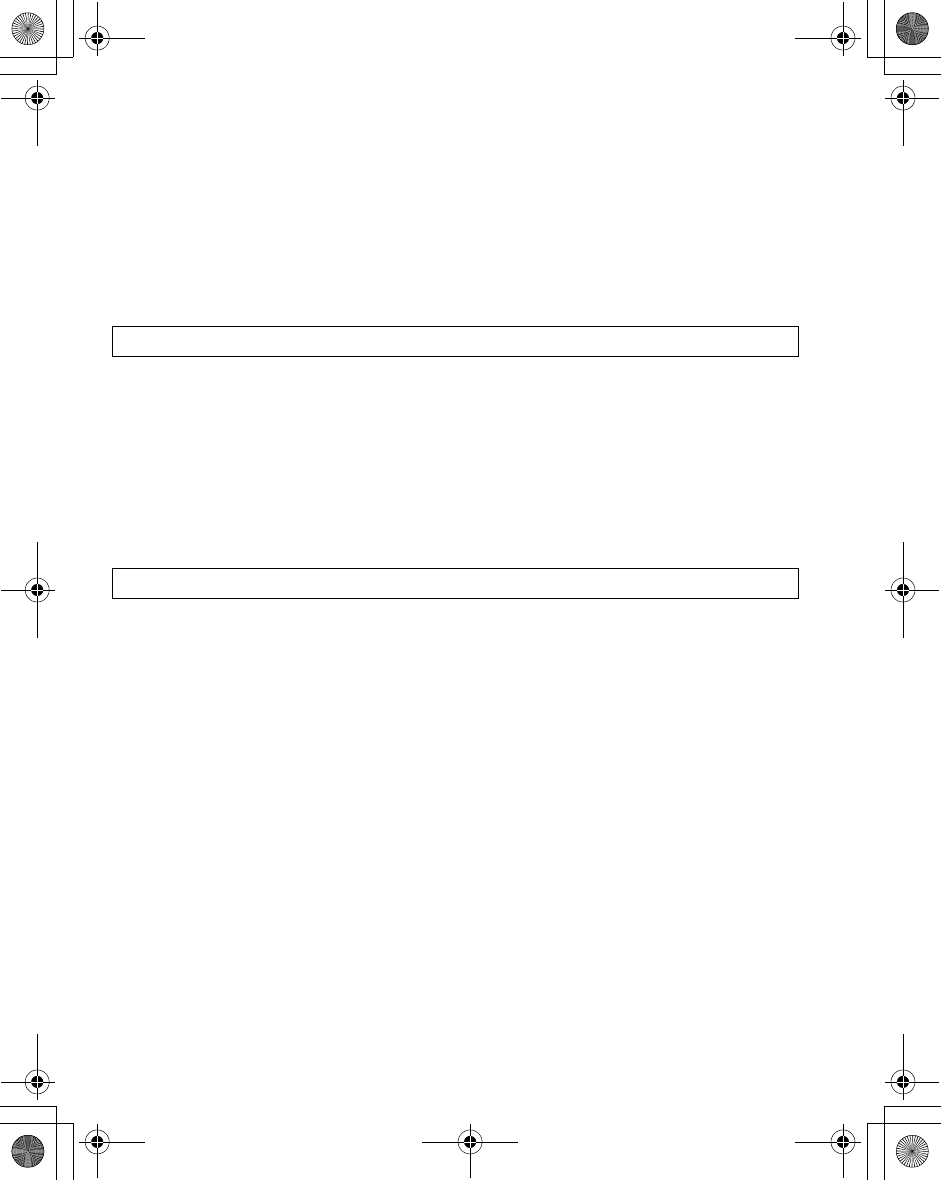
18 Basic Operations
Hold
You can put a call on hold.
During a call:
@(Hold)
To resume:
A(Back)
Making a second call
During a call:
1. Enter the second phone number or select a phone number from the Contacts list
(see "Contacts list" on page 17).
2. C
The first call is put on hold.
NOTE: Hold is network dependent.
NOTE: Making a second call is network dependent.
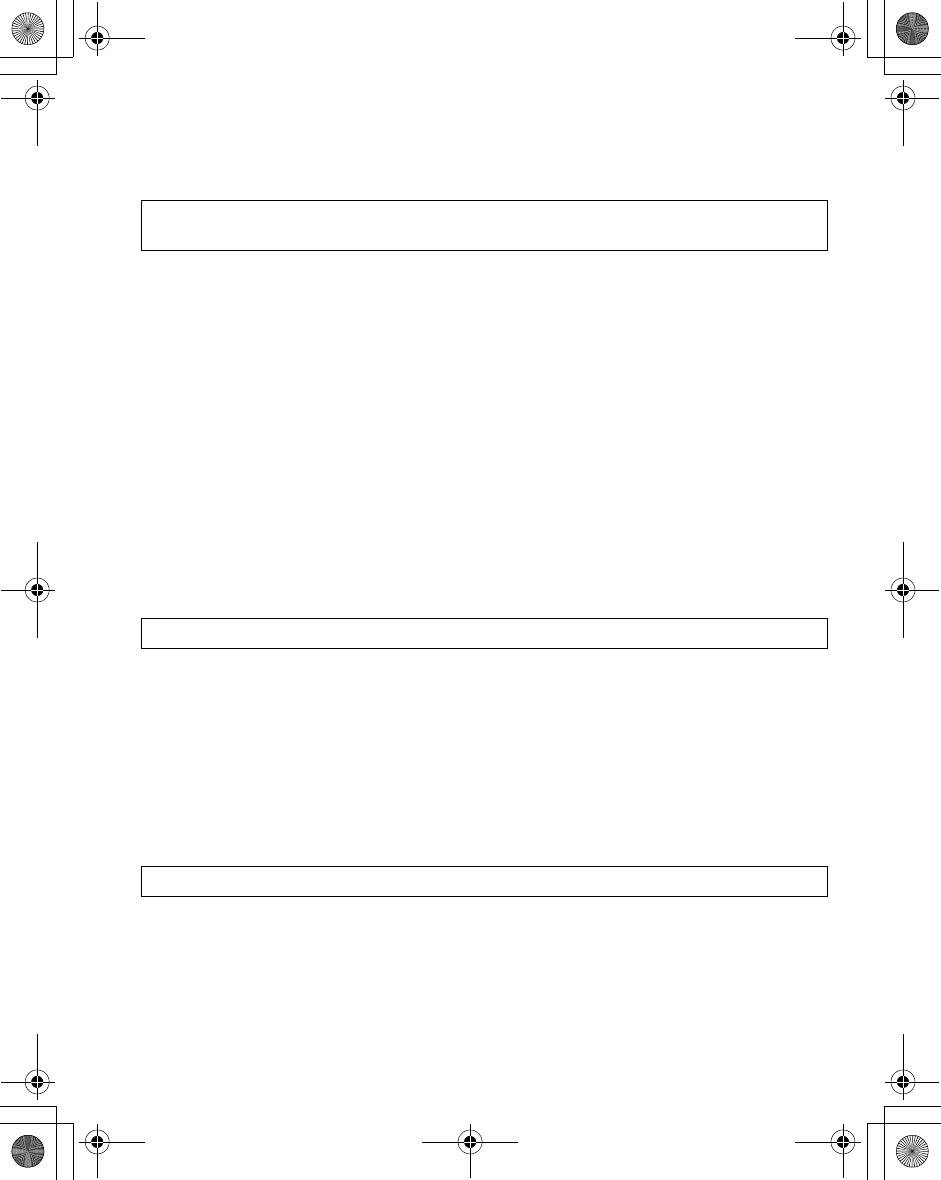
Basic Operations 19
Incoming call while on a call
During a call, you may receive another call.
1. To answer another call, C (The first call is placed on hold.)
To disconnect another call, A(Reject)
2. During a conversation with a second caller, the following options are available by
pressing A(Menu) or @(Swap):
Conference
To create a conference call, you must be connected to more than one call.
In a conference call, you can talk with up to 5 parties.
During a call:
1. A(Menu)
2. 4 Conference A(Select)
Call transfer
Call transfer connects your calling party to the other party on hold, then disconnects
your line, leaving the two callers in the conversation.
During a call:
1. A(Menu)
2. 4 Call Transfer A(Select)
NOTE: Call waiting must be on – see “Call waiting” on page 89.
Call waiting is network dependent.
NOTE: Conference is network dependent.
NOTE: Call transfer is network dependent.
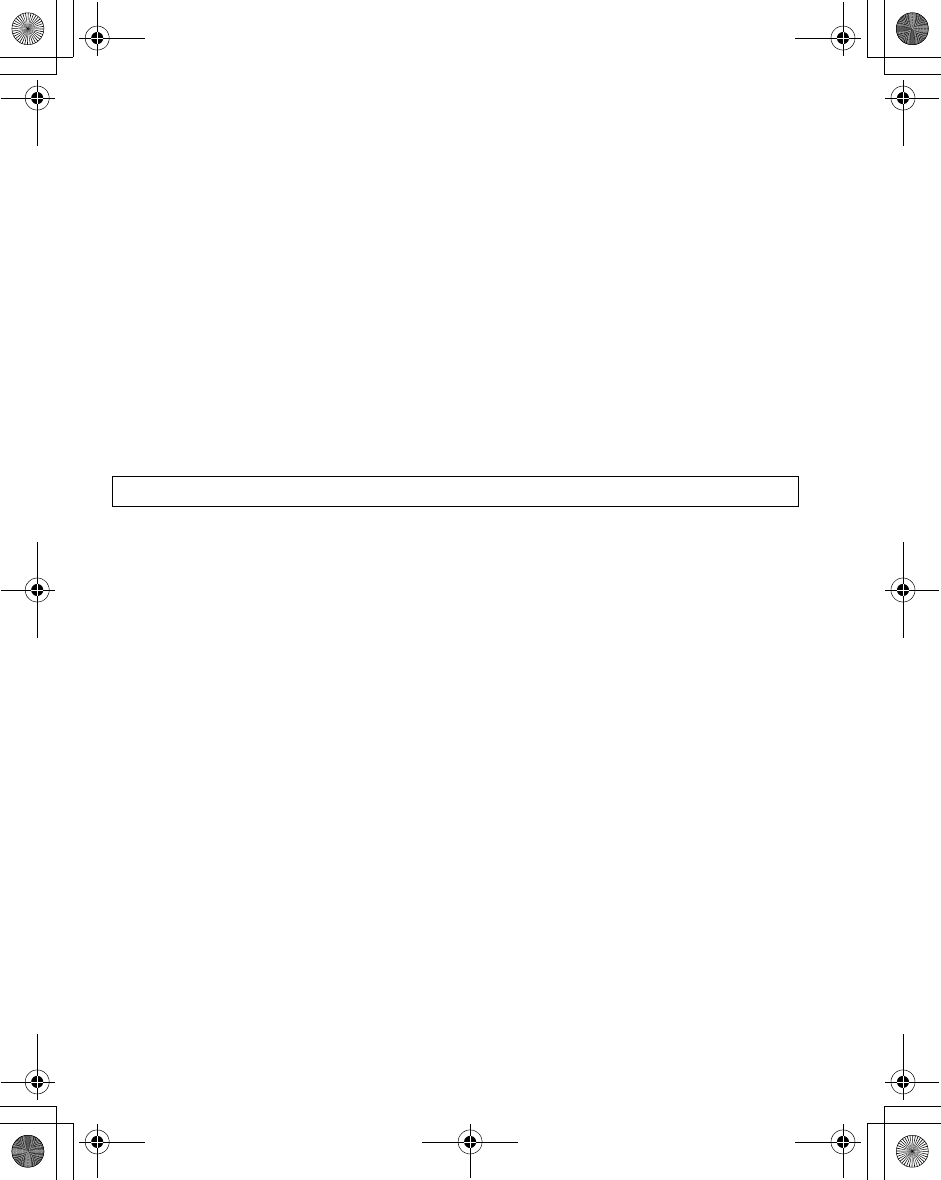
20 Basic Operations
End
You can select one of the calls to disconnect while in a conference call.
During a call:
1. A(Menu)
2. 4End A(Select)
Split
You can separate an individual from the active conference call.
During a call:
1. A(Menu)
2. 4Split A(Select)
Call status
Call status allows you to disconnect the line or put a call on hold with the active party.
You can also activate a call that is put on hold.
During a call:
1. A(Menu)
2. 4 Call status A(Select)
3. 4required active call A(Select)
4. A(End) to disconnect the line
OR@(Hold) to put the call on hold
• To resume, A(Back).
• You can activate the required inactive call by pressing A(Join) in step 3.
Swap
When you are connected to two calls, you can switch between the active call and the
held call.
During a call:
@(Swap) to switch to the other call on hold
NOTE: Split is network dependent.
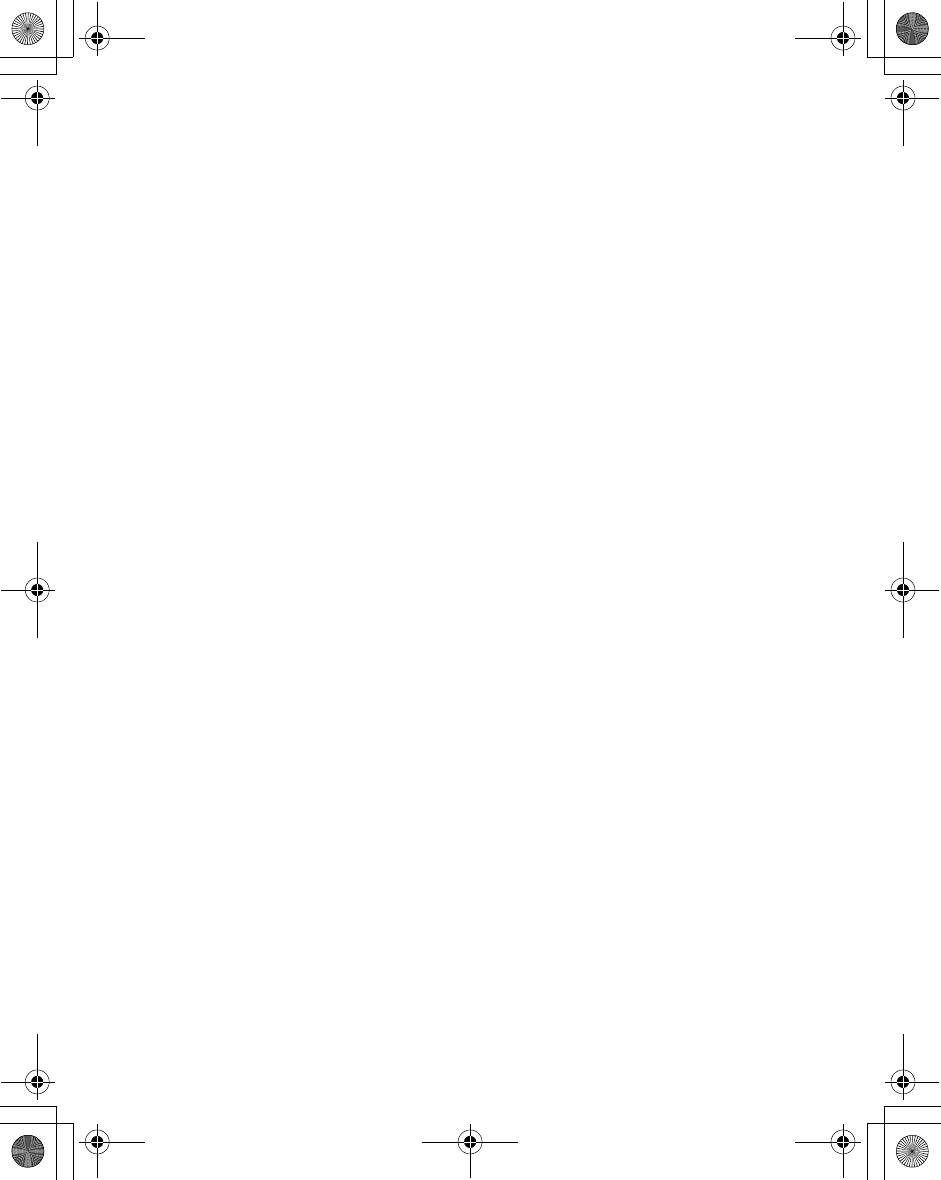
Basic Operations 21
DTMF
DTMF can be sent during a conversation. These are often used to access voice mail,
paging and computerised home banking. For example, you may need to enter a number
to remotely access voice mail messages. A phone number may be stored in the
Contacts together with a DTMF sequence, allowing the number to be dialled upon recall
and the DTMF sequence to be sent automatically.
To send DTMF during a call:
Enter digits (# ~ ,,! or ").
Pause dial
Using pauses allows you to send DTMF automatically.
1. Enter the phone number
2. Press and hold # until a “P” is displayed at the end of the phone number entered
3. Enter the DTMF digits after the pause, e.g. enter the number to access voice mail
messages
4. C
ãWhen the call is connected, the DTMF sequence will be sent after 3 seconds.
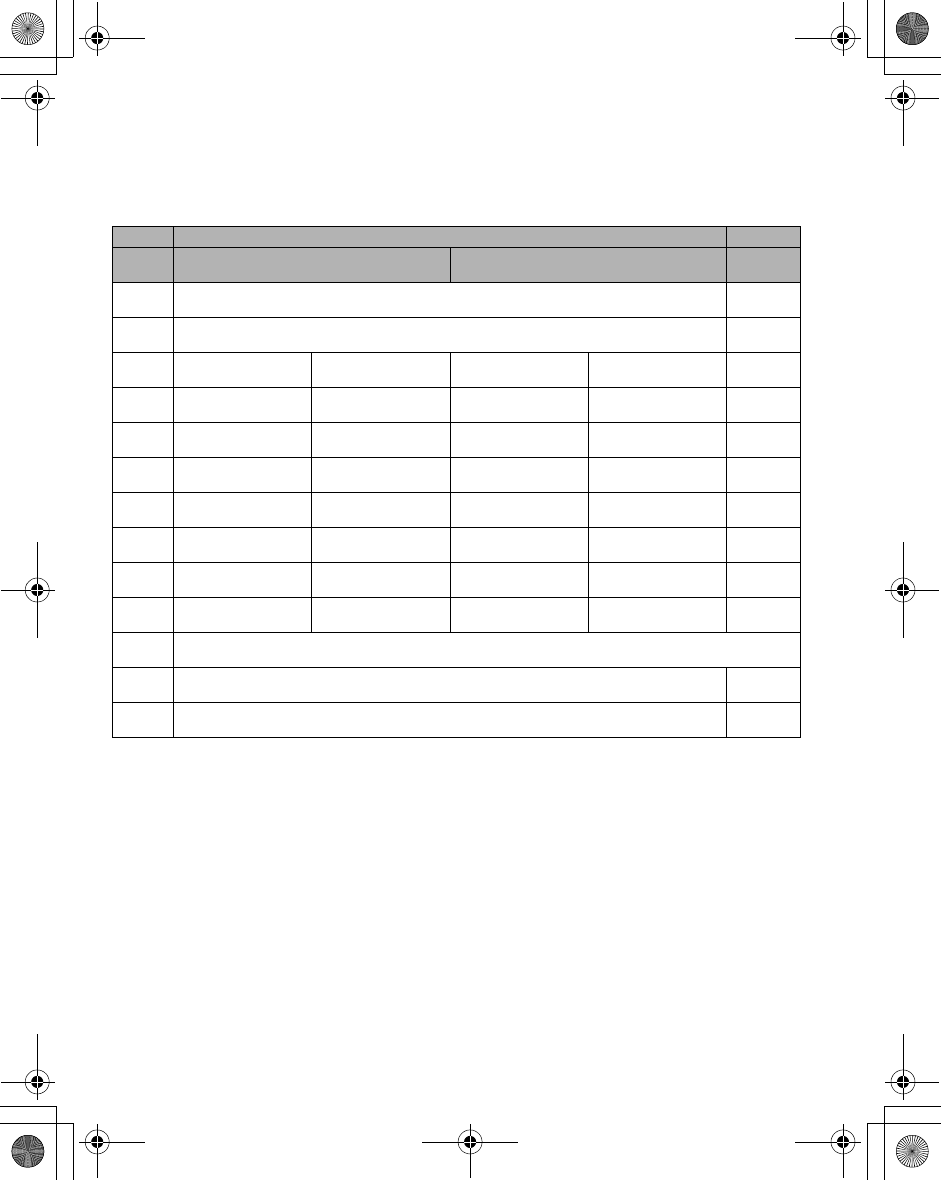
22 Basic Operations
Text entry
You can use alphanumeric characters to enter text:
NOTE: Displayed characters in the T9 mode vary depending on the selected input language.
Use ! to toggle T9 on/off.
In T9 mode, press A repeatedly until the correct word is displayed. When "-" is
reached, press @ to spell the word you require.
Key Text mode Numeric
T9®(T9abc, T9Abc, T9ABC)
(Input language: English) Multi tap
(Input mode indicator: abc, Abc or ABC) (0~9)
#Space 0. , ?! + - = : ¿ ¡ ” ’ ; _ 0
$1 / ( ) < > [ ] { } % ~ _& 1
%A B C 2 - (a b c 2 -) A B C 2 Ä (a b c 2 ä à ç) 2
&D E F 3 - (d e f 3 -) D E F 3 É (d e f 3 é è) 3
'G H I 4 - (g h i 4 -) G H I 4 (g h i 4 ì) 4
(J K L 5 - (j k l 5 -) J K L 5 (j k l 5) 5
)M N O 6 - (m n o 6 -) M N O 6 Ö Ñ (m n o 6 ö ñ ò) 6
*P Q R S 7 - (p q r s 7 -) P Q R S 7 (p q r s 7 ß) 7
+T UV 8 - (t u v 8 -) T U V 8 Ü (t u v 8 ü ù) 8
,W X Y Z 9 - (w x y z 9 -) W X Y Z 9 Æ Ø Å (w x y z 9 æ ø å) 9
CShift mode
"*ī∆ Θ Λ ȄȆȈĭȌȍ *
! (Hold) Space # £ $ ¥ ¤ @ \ § ^I(new paragraph) #
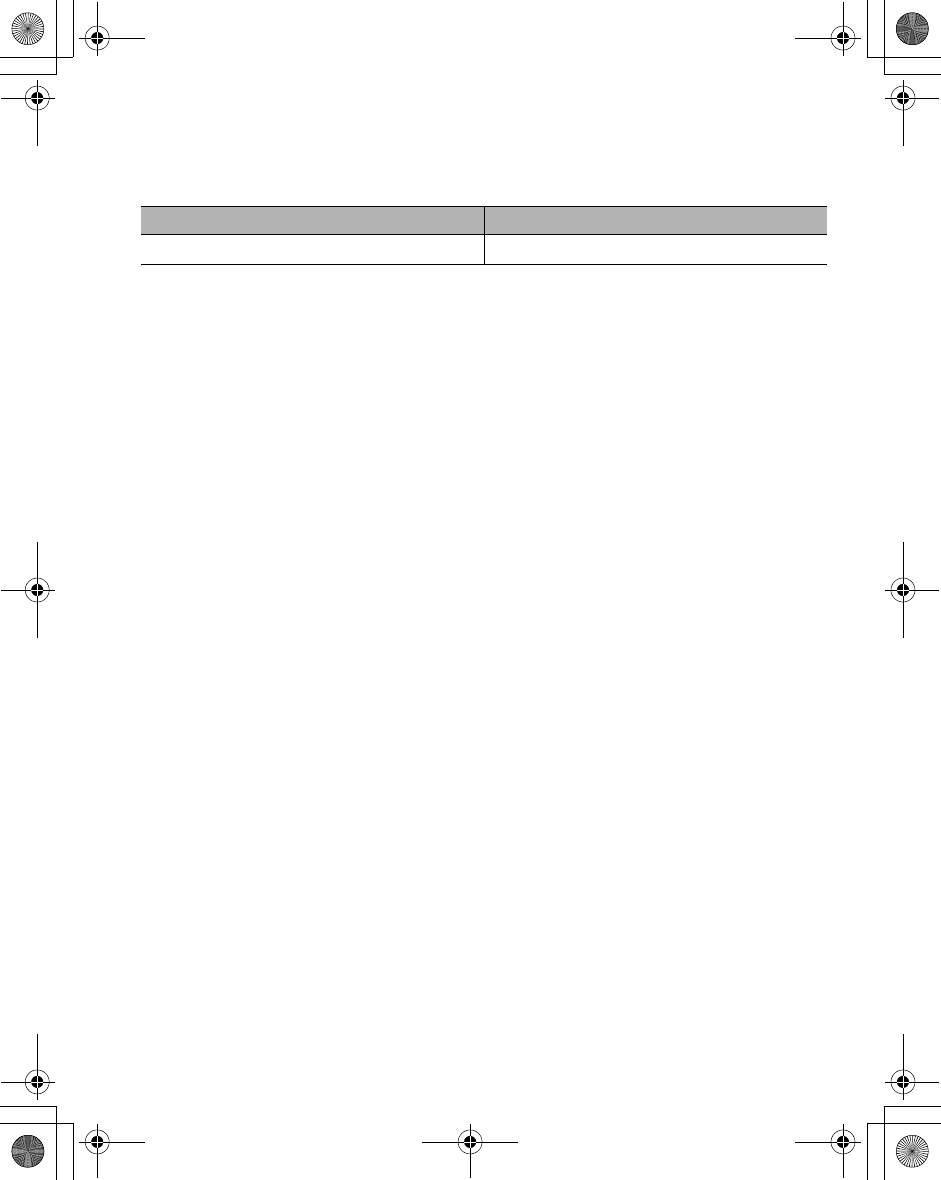
Basic Operations 23
Shift mode change
In text entry mode, you can change mode by pressing and holding C.
Text entry mode change
In text entry mode, to switch T9 mode on/off, press !.
Auto capital change
Auto capital affects Abc and T9Abc.
When the entry mode is changed to Abc or T9Abc, the first character is input as upper
case and subsequent letters as lower case.
When one of the following characters [. (Period) or ! or ? ] is input before a space, the
next character is input as upper case.
T9 Text Input:
Using this mode of text entry dramatically reduces the required number of key presses.
Press a key once for any letter you require on that key. The desired letter may not be
displayed. Continue pressing other keys until the end of a word is reached, then check
that the word has been typed correctly before continuing on to the next word. If the
combination of letters typed has produced a word which is not the one you require,
press A repeatedly until the correct word is displayed. Then continue to the next
word.
Example of Text entry in T9 Mode
To type a new message, follow these steps:
1. At the beginning of a new message, press and hold @(Clear) to delete previous
text, if necessary
2. Press C to change letter case, if necessary
3. Press %%(( . “Call” is displayed
Note that the displayed words change as you type. Always type to the end of the word
before editing.
T9 languages can be selected from T9 Input – see “T9 Input“ on page 35.
If the word you require is not in the internal dictionary, it should be entered using the
Multi tap mode.
Multi tap Tegic
abc Æ Abc Æ ABC Æ 123 T9abc Æ T9Abc Æ T9ABC Æ 123
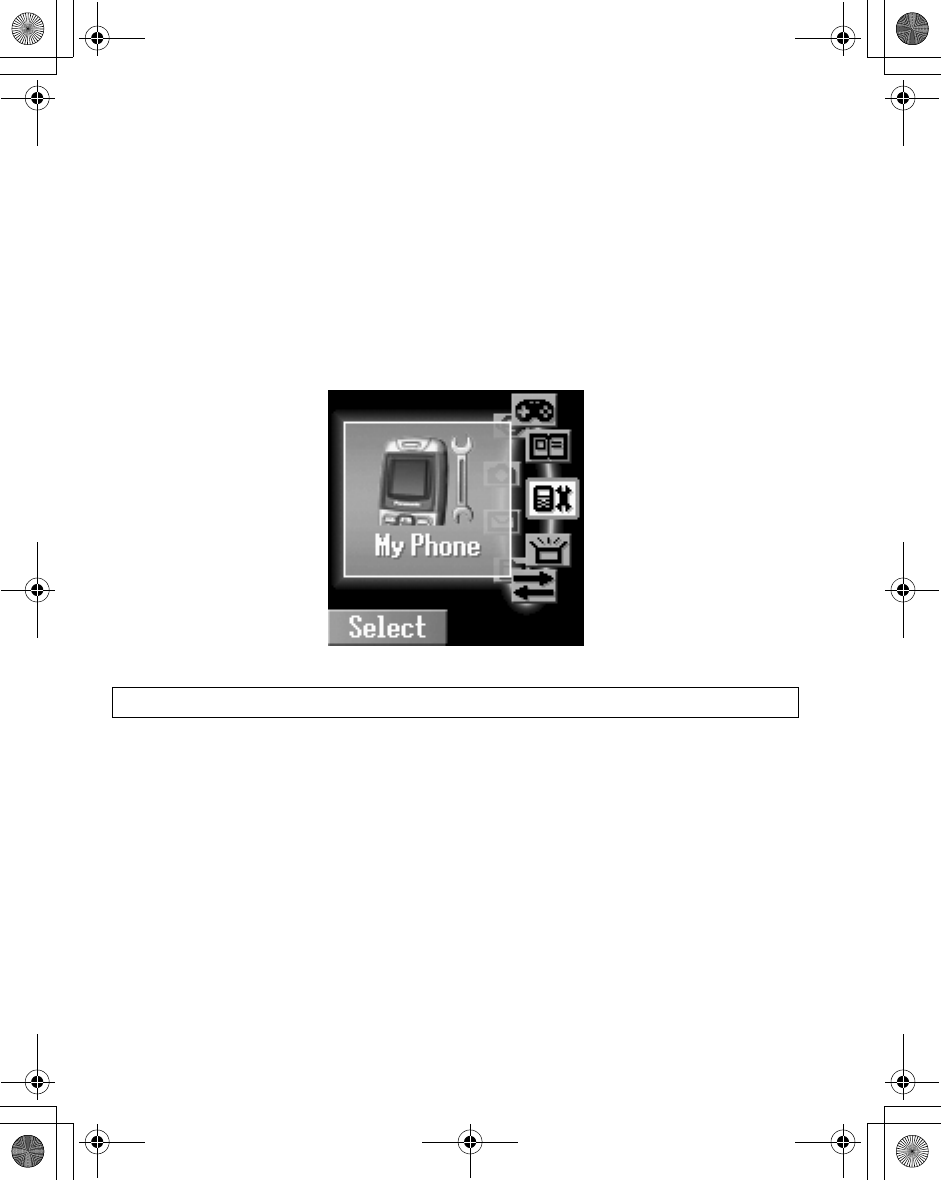
24 Basic Operations
Other text modes
Multi tap mode (abc, Abc or ABC):
Each time a key is pressed in quick succession, the next character available on that key
is displayed. Releasing the key or pressing another key enters the character displayed.
The cursor moves to the next position.
In T9 (Abc) or Multi tap (Abc) mode, the first entered letter in a sentence is in upper case.
Menu Display
The menu system allows you to access functions which do not have their own dedicated
buttons on the keypad.
In idle mode
1. A(Menu)
The main menu display has 9 menu options
(see “Exploring the Menus” on page 25)
2. 4 required menu A(Select)
To go back to the Menu display:
D or @ repeatedly until the Menu display returns.
NOTE: Menu display contents are dependent on your SIM.
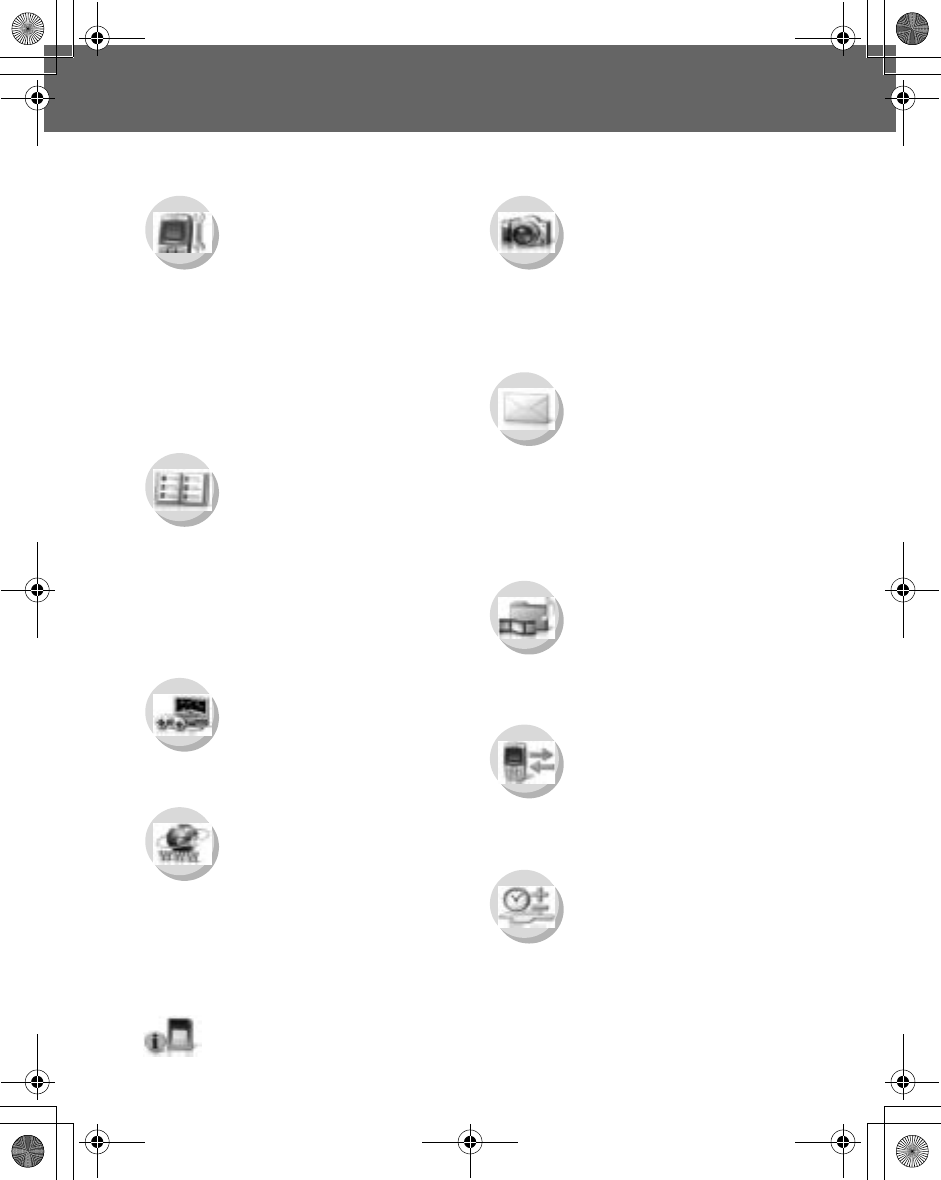
Exploring the Menus 25
Exploring the Menus
The 9 main menus are as follows:
My Phone
My Media................................ 27
Sounds................................... 30
Display ................................... 32
Language ............................... 35
Alerts...................................... 35
Profiles ................................... 36
Auto answer ........................... 40
Any key answer...................... 40
Auto key lock.......................... 40
Shortcuts ................................ 41
Defaults .................................. 41
Phone Menu (or STK)*
Call Service ............................ 89
Call Diverts .............................93
Security...................................94
Network ..................................99
*STK (SIM Tool Kit) is SIM dependent.
Browser
Start browser.......................... 57
Bookmarks ............................. 58
Settings .................................. 56
Push setting ........................... 59
Connectivity............................ 60
Contacts
Browse ................................... 43
Create .................................... 46
Groups ................................... 49
SDN........................................ 49
Information number ................ 50
Memory status........................ 50
My Numbers........................... 51
Hotkey dial ............................. 52
My Contacts ........................... 52
Camera
- (Camera)
Camera Preview mode...........63
Still Picture mode....................63
- (Video)
Video Preview mode...............70
Still Picture mode....................70
Records
Last dialled ...........................100
Answered..............................100
Unanswered .........................100
Delete records ...................... 101
Messages
Create...............................76, 82
Inbox................................. 78, 83
Outbox..............................80, 84
User Messages.......................84
Memory status........................85
Settings............................. 74, 81
Connectivity............................85
Cell Broadcast ........................ 85
Applications
Games..................................103
Calendar...............................103
Scheduler .............................106
Notes .................................... 108
Clock.....................................108
Calculator .............................111
Currency ...............................112
Melody composer .................113
(Phone Menu).......................114
Games
Puddleland ............................. 53
Quadball................................. 54
Exode ..................................... 54
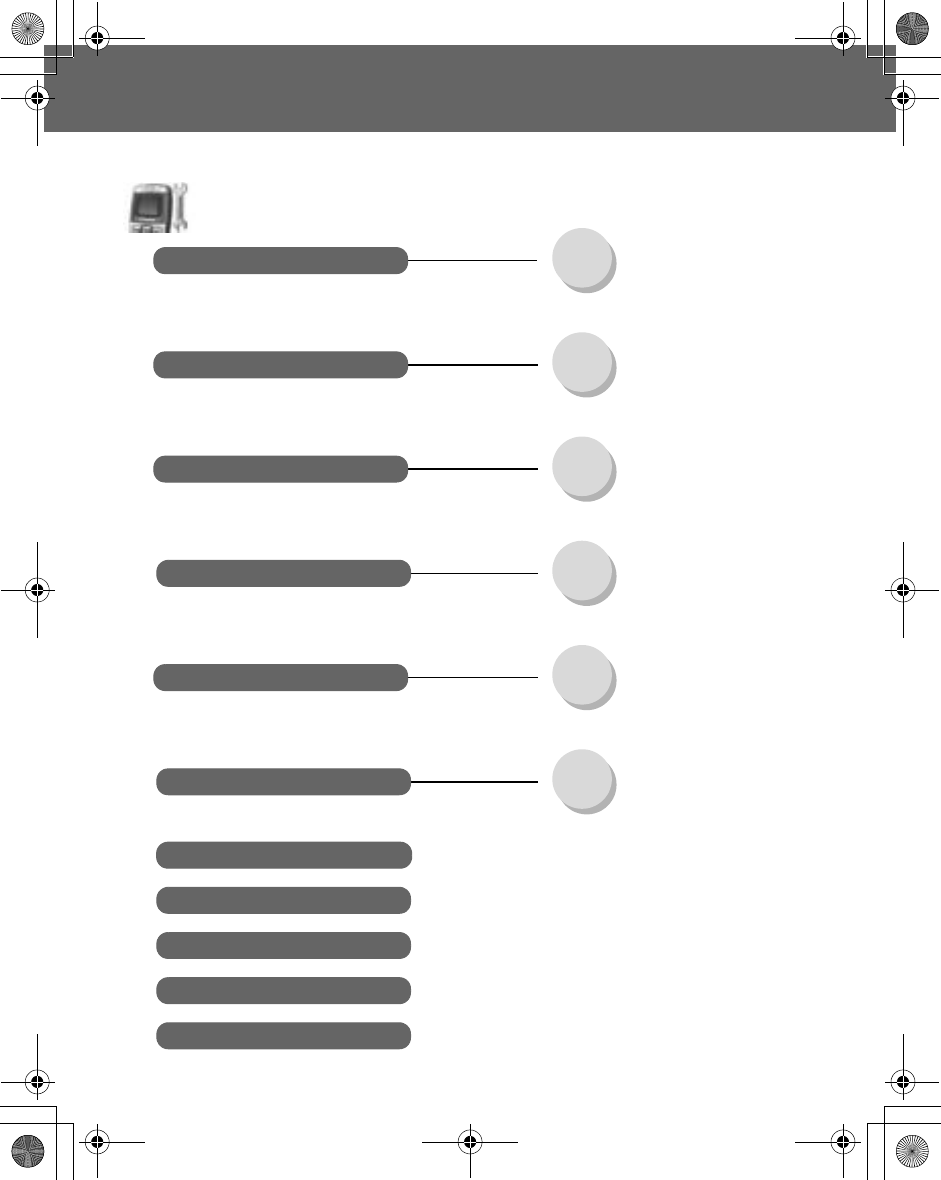
26 My Phone Menu
My Phone Menu
Auto answer
Shortcuts
Any key answer
My Phone
Defaults
Auto key lock
My Pictures................................27
My Videos..................................27
My Sounds ................................28
User 1~4....................................29
Memory status........................... 29
Volume ......................................30
Ringtones ..................................30
Key tone ....................................31
Warning tone.............................31
Shutter sound............................ 31
Wallpaper ..................................32
Greeting.....................................32
Animation ..................................33
Contrast.....................................33
Brightness .................................33
Colour themes ........................... 34
Display
Sounds
My Media
T9 Input ..................................... 35
Display Languages....................35
Language
Alerts
Ring only ................................... 35
None.......................................... 35
Ring & Vibrate ........................... 35
Vibrate only ............................... 35
Ring once ..................................35
Profiles
Normal.......................................36
Quiet..........................................36
Outdoors.................................... 36
Headset.....................................36
Meeting...................................... 36
Customer................................... 36
.......................................................................................40
.......................................................................................40
.......................................................................................40
.......................................................................................41
.......................................................................................41
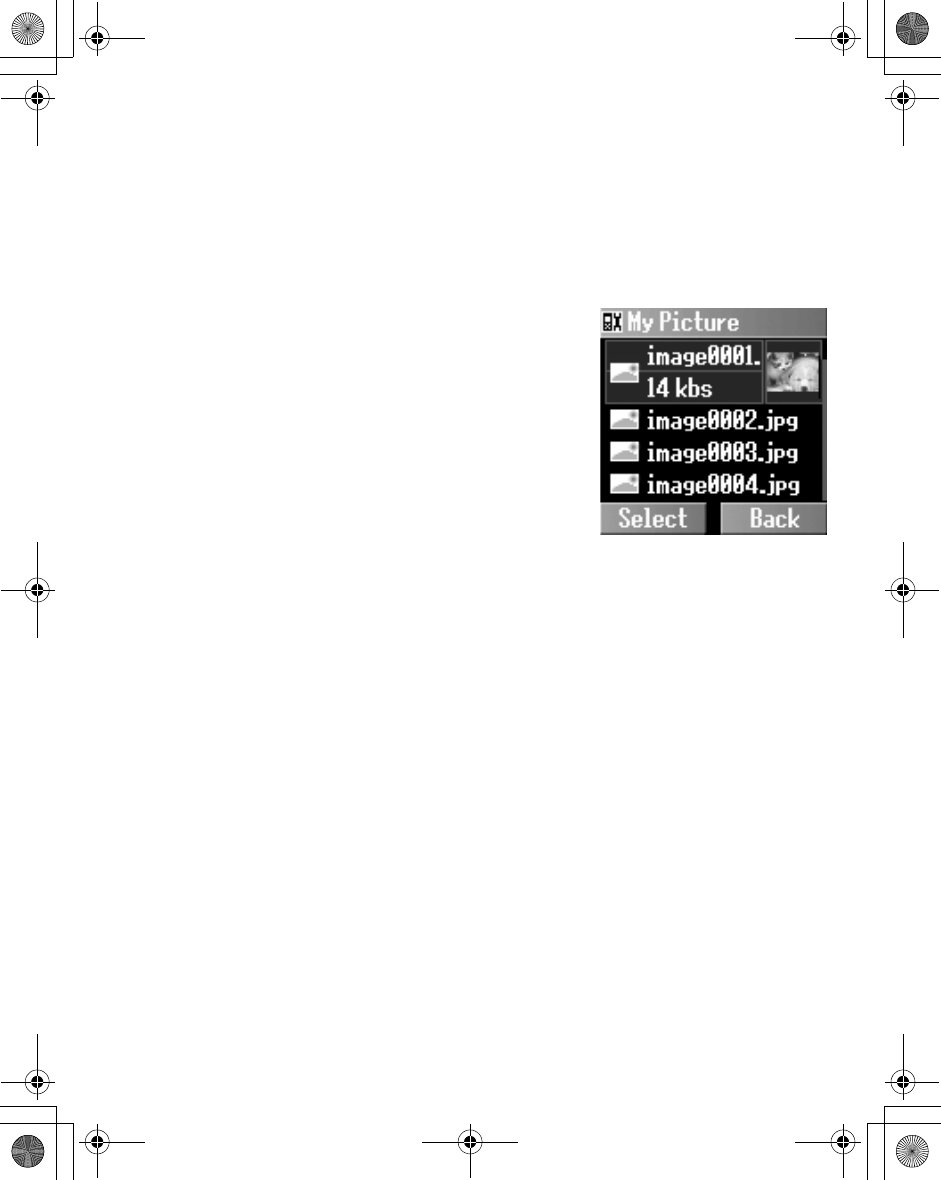
My Phone Menu 27
My Media
My Pictures
Pictures taken by the built-in camera or images downloaded from
the Internet are stored in the My Pictures folder.
From My Phone
1. 4My Media A(Select)
2. 4My Pictures A(Select)
3. 4 required picture
A(Select)
4. 4 required option
A(Select)
The following options are available
after selecting the picture:
-View
- Send via MMS
- Set as wallpaper
- Rename
- Copy
-Cut
-Paste
- Delete
- Delete all
My Videos
Video clips recorded by the built-in video recorder are stored in the
My Videos folder.
From My Phone
1. 4My Media A(Select)
2. 4My Videos A(Select)
3. 4 required video A(Select)
4. 4 required option A(Select)
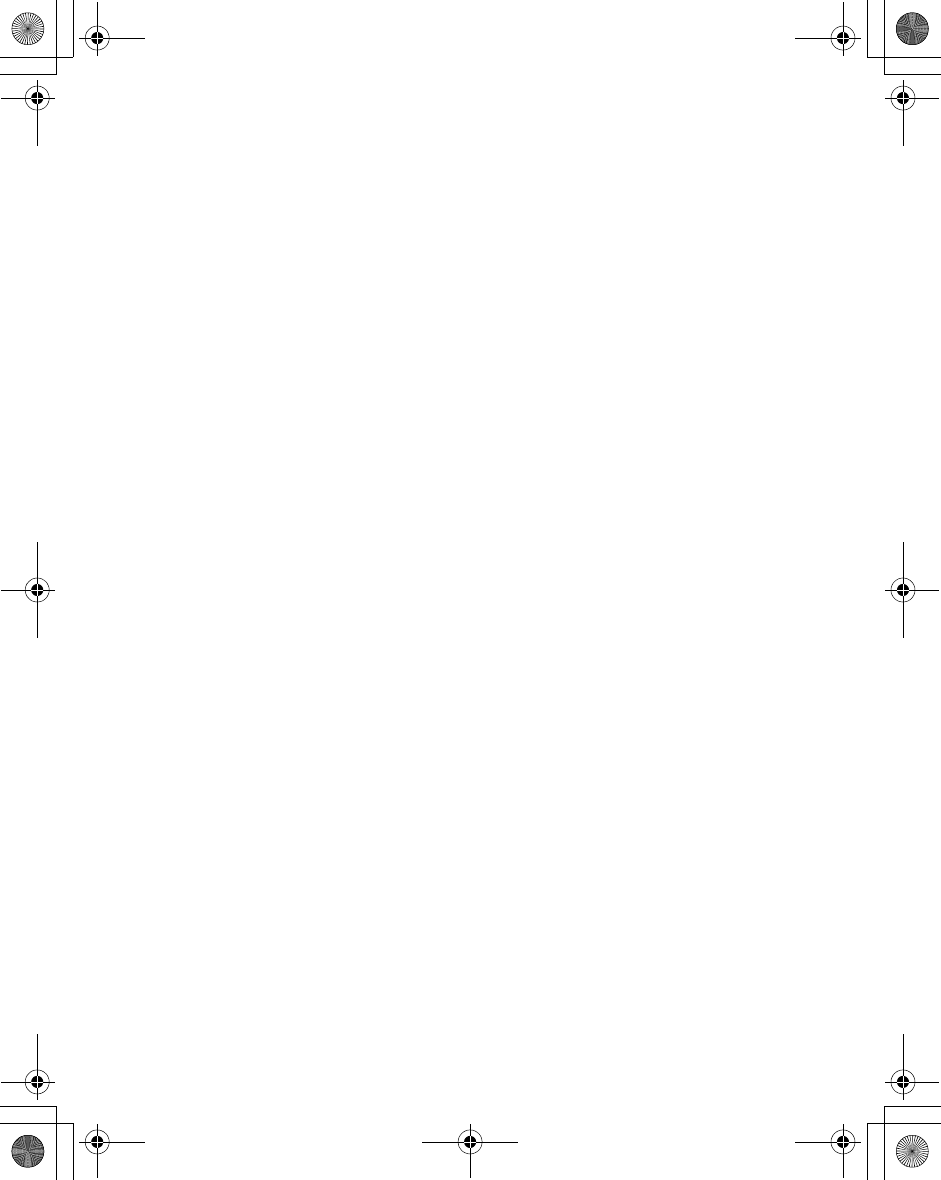
28 My Phone Menu
The following options are available after selecting the video clip:
-View
- Send via MMS
- Rename
-Copy
-Cut
- Paste
- Delete
- Delete all
My Sounds
Downloaded sounds are stored in the My Sounds folder.
From My Phone
1. 4My Media A(Select)
2. 4My Sounds A(Select)
3. 4 required sound A(Select)
4. 4 required option A(Select)
The following options are available after selecting the sound:
- Send via MMS
- Set as ringtone
- Rename
-Copy
-Cut
- Paste
- Delete
- Delete all
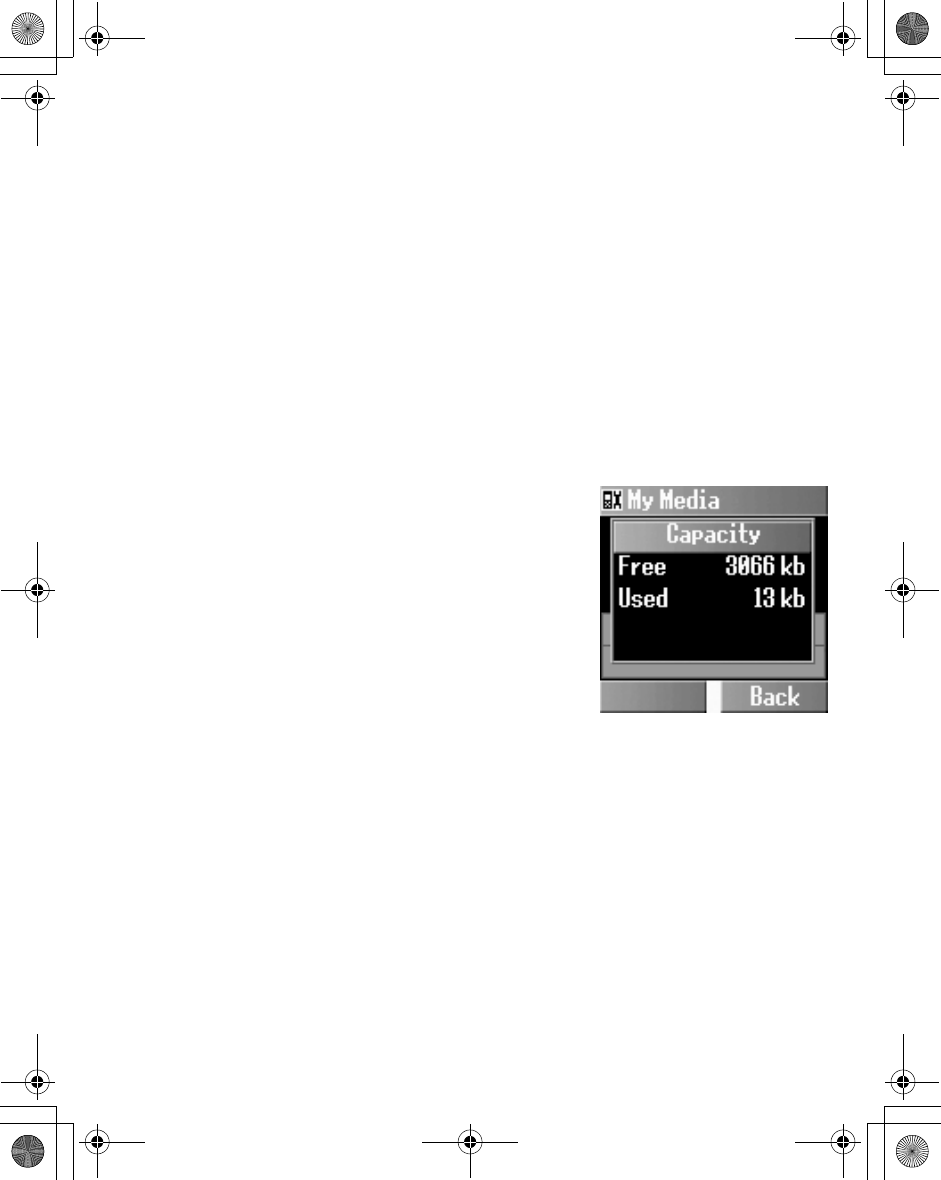
My Phone Menu 29
User 1~4
You can also store your pictures, videos and sounds in the user
defined folders:
From My Phone
1. 4My Media A(Select)
2. 4My Pictures,My Videos, or My Sounds A(Select)
3. 4 required file A(Select)
4. 4Copy A(Select)
5. User 1,User 2,User 3, or User 4 A(Select)
6. A(Select) Paste A(Select)
Memory status
From My Phone
1. 4My Media A(Select)
2. 4Memory status
A(Select)
ãThe available memory space, and
used memory space are displayed.
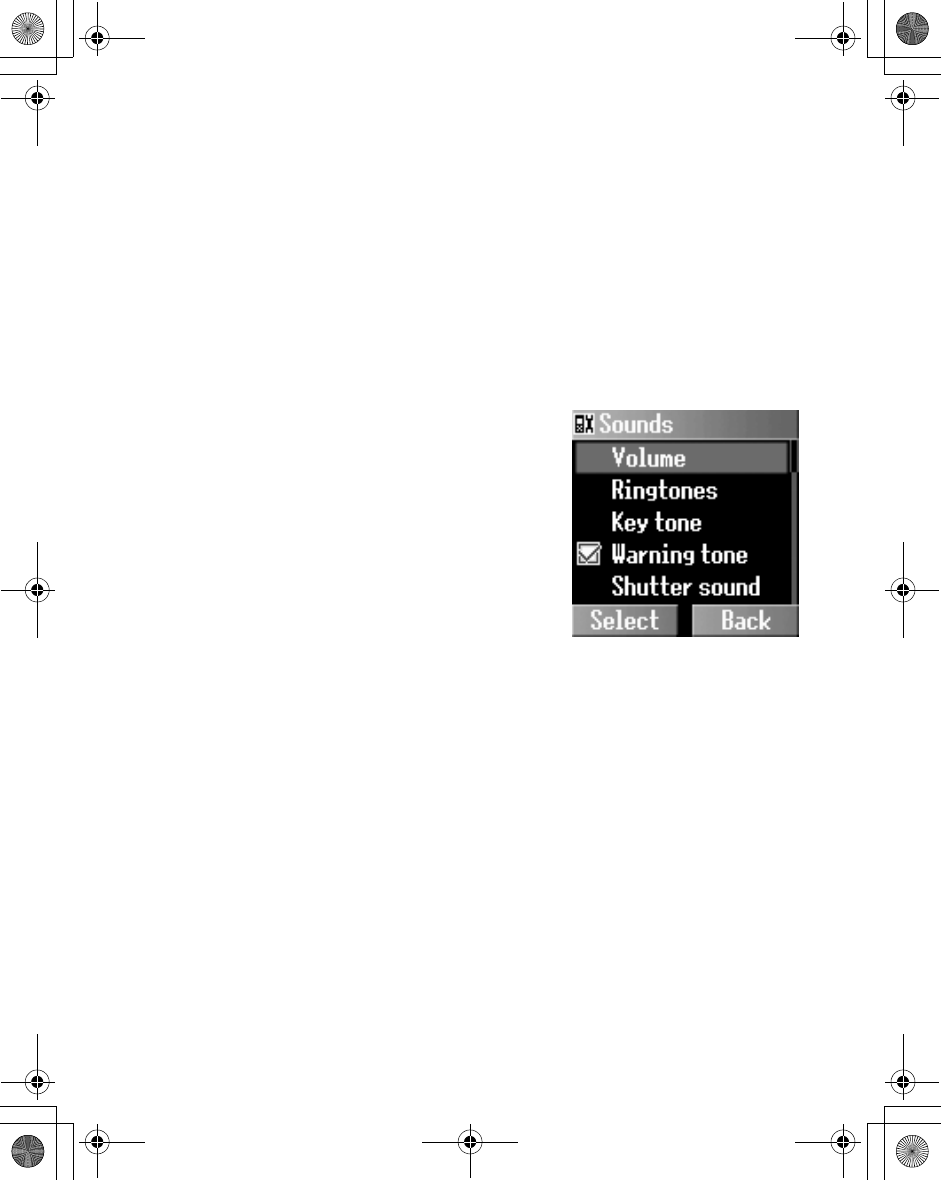
30 My Phone Menu
Sounds
Volume
You can change the volume of the following events:
- Other call
- Contacts call
-Alarm
- Messages
- Cell Broadcast
- Group 1~10
From My Phone
1. 4Sounds A(Select)
2. 4Volume A(Select)
3. 4 required events
A(Select)
4. 4 Adjust the volume level
A(OK)
Ringtones
You can change the ringtones of the following events:
- Other call
- Contacts call
-Alarm
- Messages
- Cell Broadcast
- Group 1~10
From My Phone
1. 4Sounds A(Select)
2. 4Ringtones A(Select)
3. 4 required event A(Select)
4. 4Embedded melody,Downloaded melody or
Composed melody A(Select)
5. 4 required ringtone A(Select)
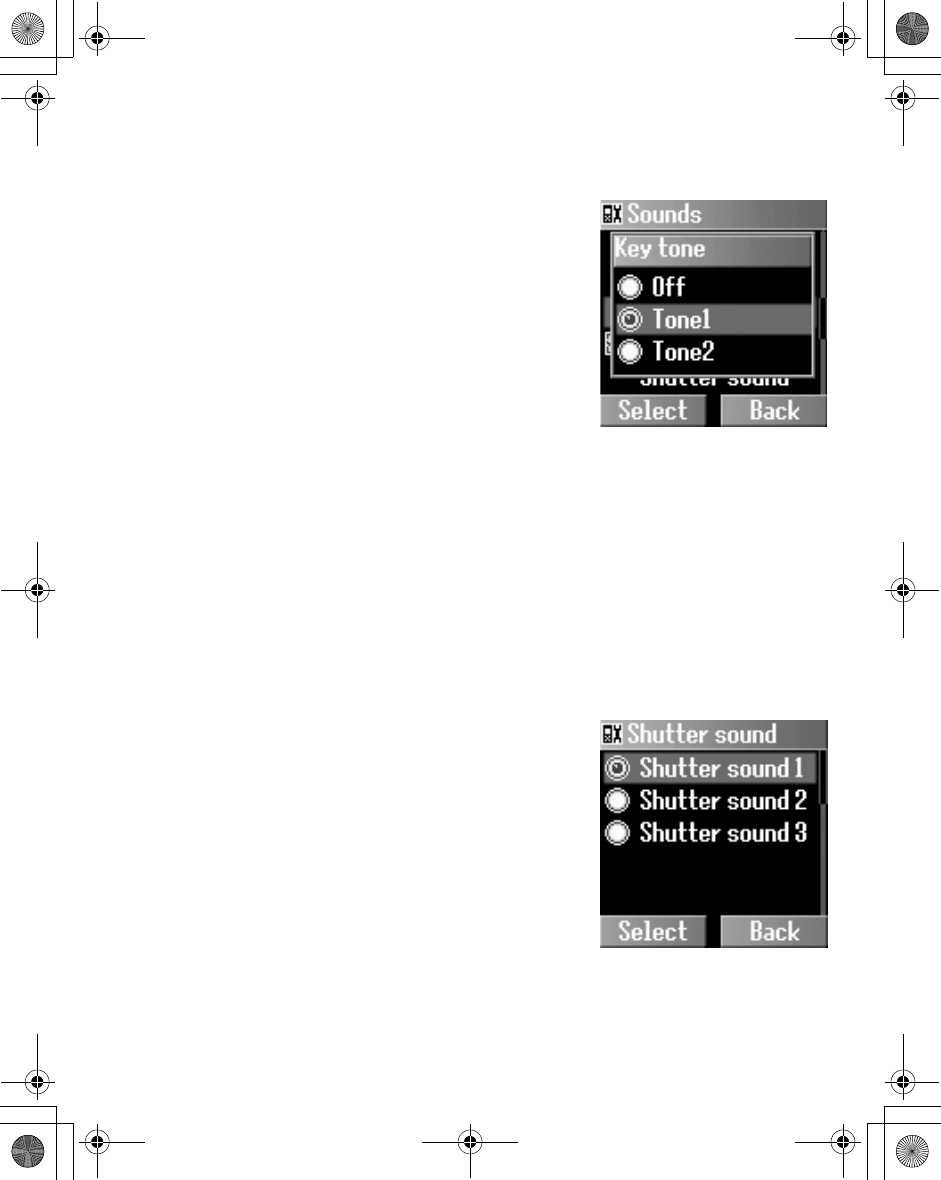
My Phone Menu 31
Key tone
The key tone is the sound you hear when you press a key.
From My Phone
1. 4Sounds A(Select)
2. 4Key tone A(Select)
3. 4Off, Tone 1, Tone 2 or
Tone 3 A(Select)
Warning tone
The warning tone informs you of low battery.
From My Phone
1. 4Sounds A(Select)
2. 4Warning tone A(Select) > On/Off
Shutter sound
The phone makes a shutter sound when you take a picture.
From My Phone
1. 4Sounds A(Select)
2. 4Shutter sound
A(Select)
3. 4Shutter sound 1, 2, or 3
A(Select)
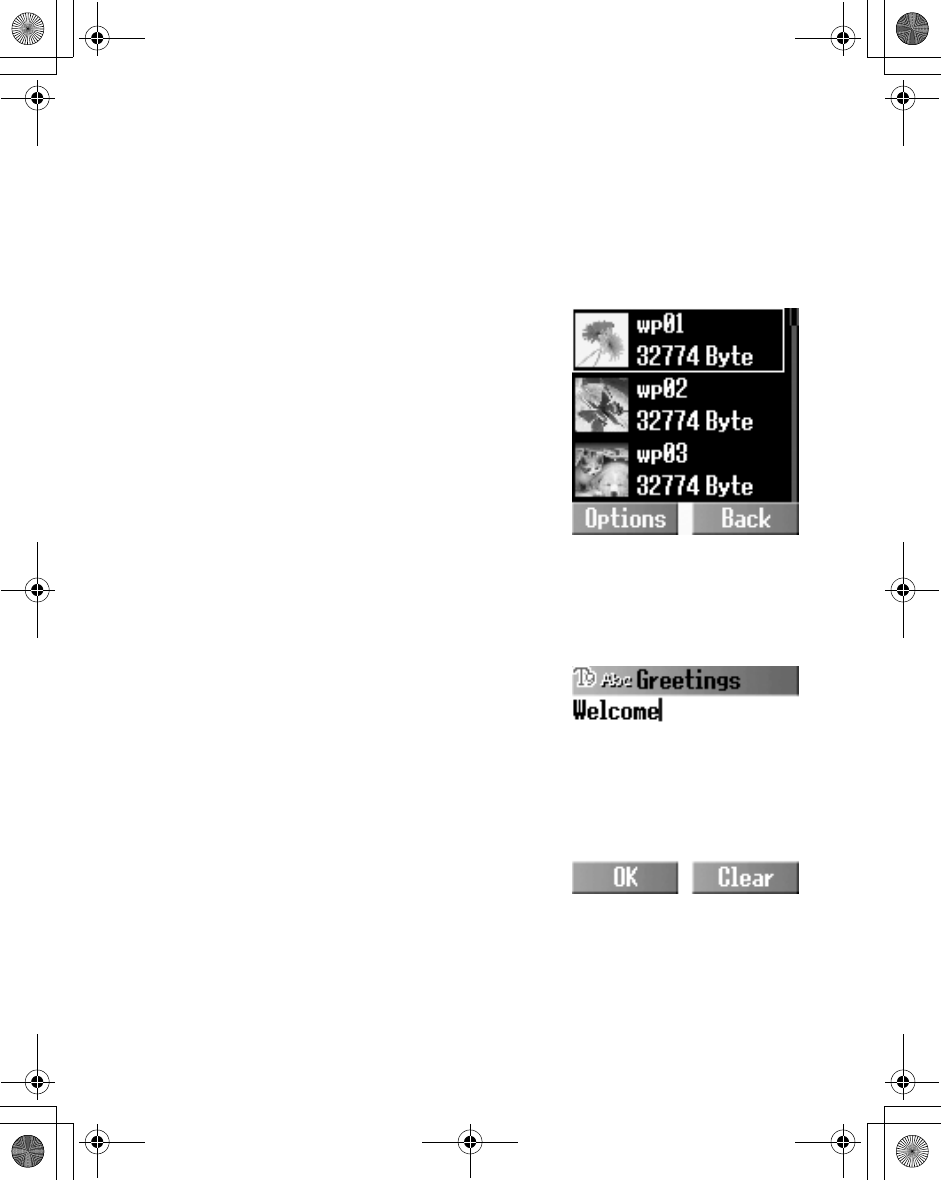
32 My Phone Menu
Display
Wallpaper
You can change the wallpaper on the idle display. Idle mode can
also change to the clock.
From My Phone
1. 4Display A(Select)
2. 4Wallpaper A(Select)
3. 4Default image,Download
image or Off A(Select)
4. 4 required wallpaper
A(Options)
5. 4Select A(Select)
Greeting
You can create a greeting message that is displayed each time
the phone is switched on.
From My Phone
1. 4Display A(Select)
2. 4Greeting @(Edit)
3. Enter the greeting A(OK)
4. A(On/Off)
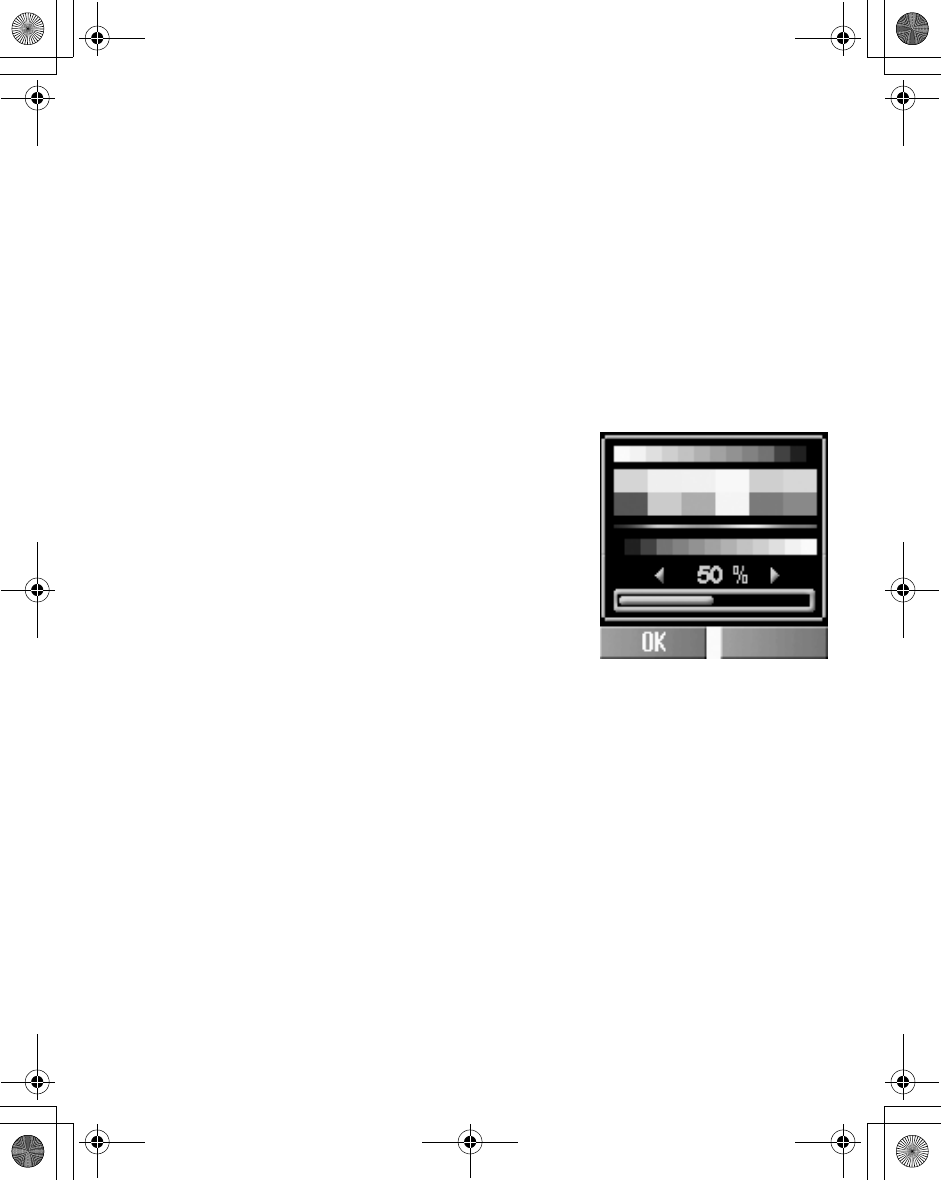
My Phone Menu 33
Animation
You can change the animation on the display when the phone is
switched on.
From My Phone
1. 4Display A(Select)
2. 4Animation A(Select)
3. 4Animation 1 or Animation 2 A(Select)
Contrast
You can adjust the contrast of the display.
From My Phone
1. 4Display A(Select)
2. 4Contrast A(Select)
3. 4 Adjust the contrast
A(OK)
Brightness
You can adjust the brightness of the display.
From My Phone
1. 4Display A(Select)
2. 4 Brightness A(Change)
3. 4 Maximum,High,Medium, or Low A(Select)
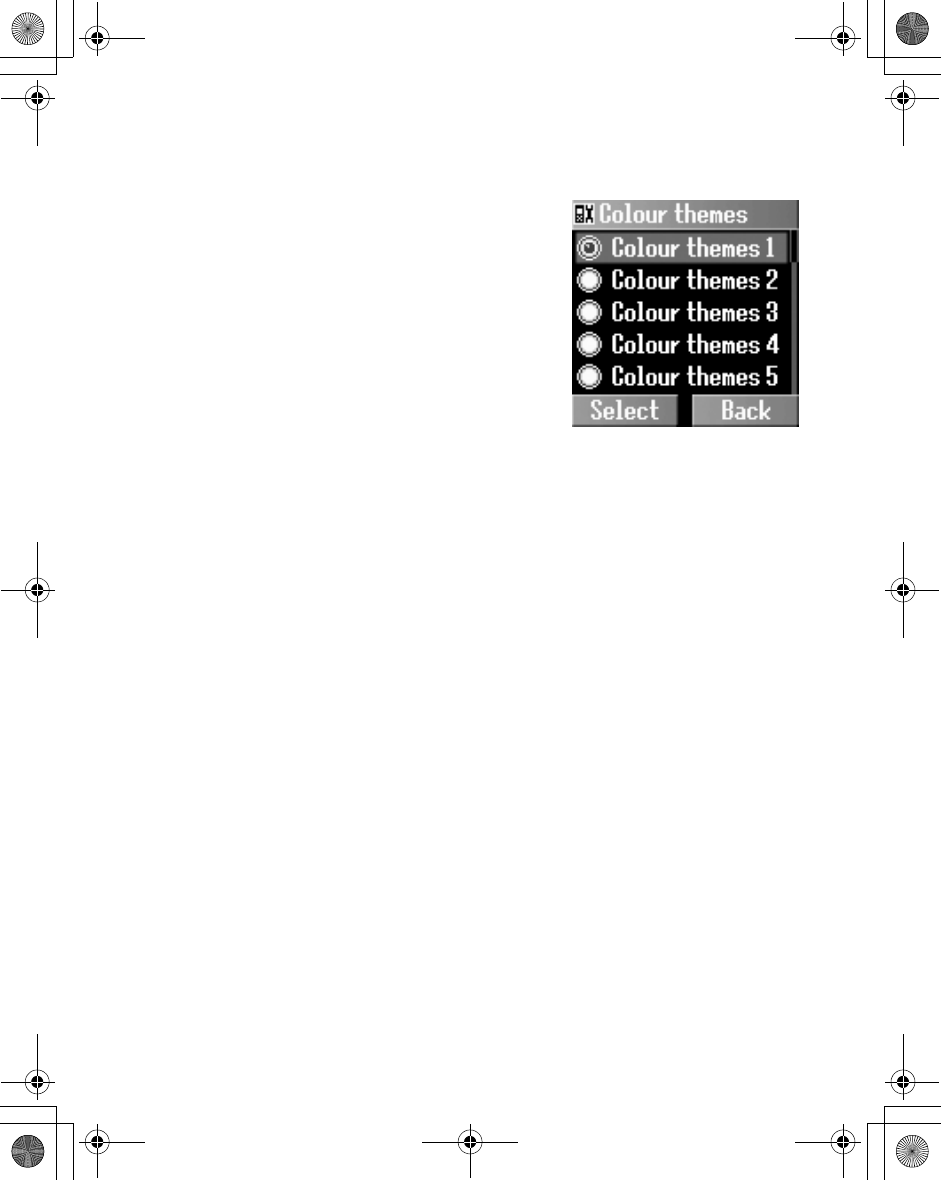
34 My Phone Menu
Colour themes
You can change the colour themes on the display.
From My Phone
1. 4Display A(Select)
2. 4 Colour themes
A(Change)
3. 4required colour theme
A(Select)
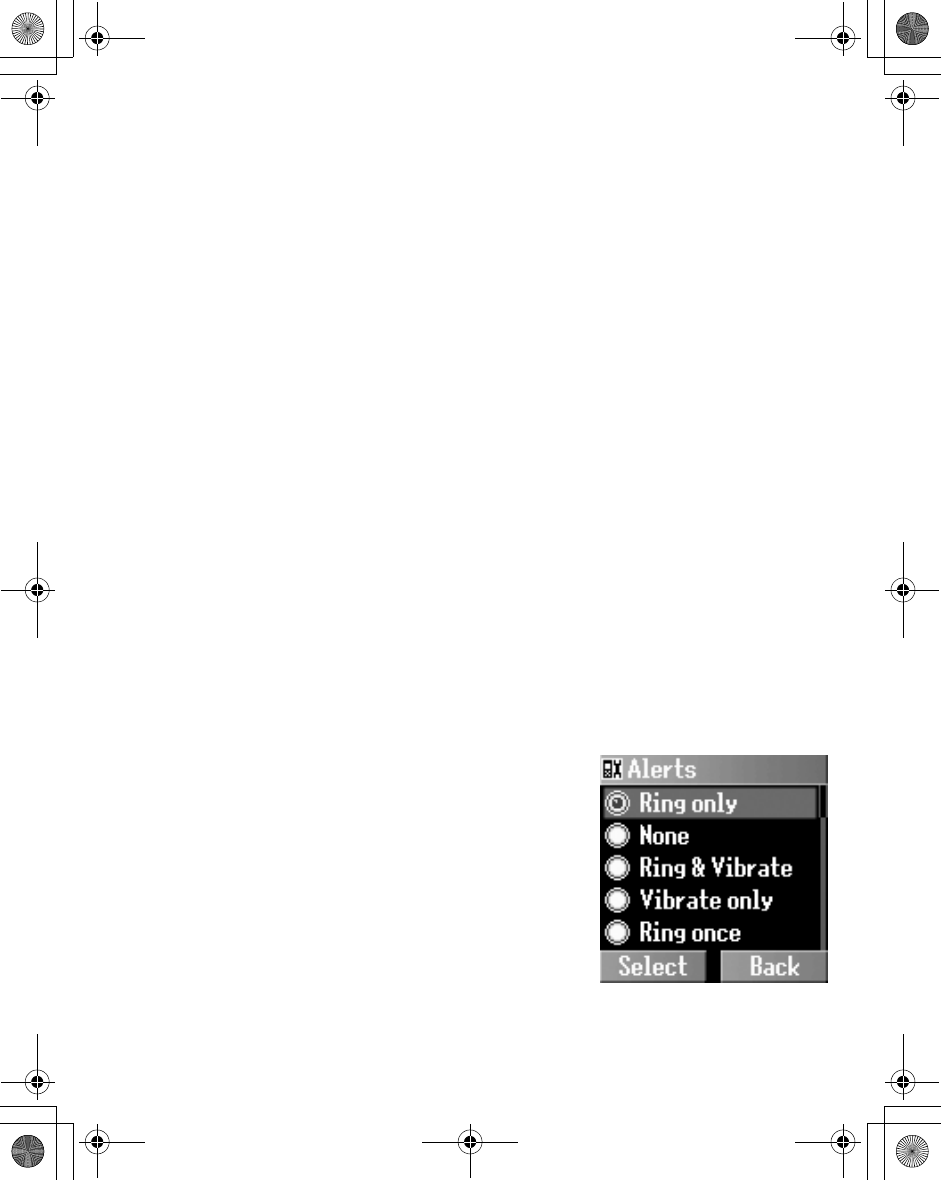
My Phone Menu 35
Language
T9Input
When you create text, this function dramatically reduces the
number of key presses.
From My Phone
1. 4 Language A(Select)
2. 4T9 Input A(Select)
3. 4 required input type A(Change) > On/Off
Display Languages
It is possible to change the display language on your phone.
From My Phone
1. 4Language A(Select)
2. 4Display Languages A(Select)
3. 4 required language A(Select)
Alerts
You can set your phone to ring and/or vibrate when you receive a
call or message.
From My Phone
1. 4Alerts A(Select)
2. 4 required alert A(Select)
The following options are available
when a call or message is received:
- Ring only
- None
- Ring & Vibrate
- Vibrate only
-Ring once
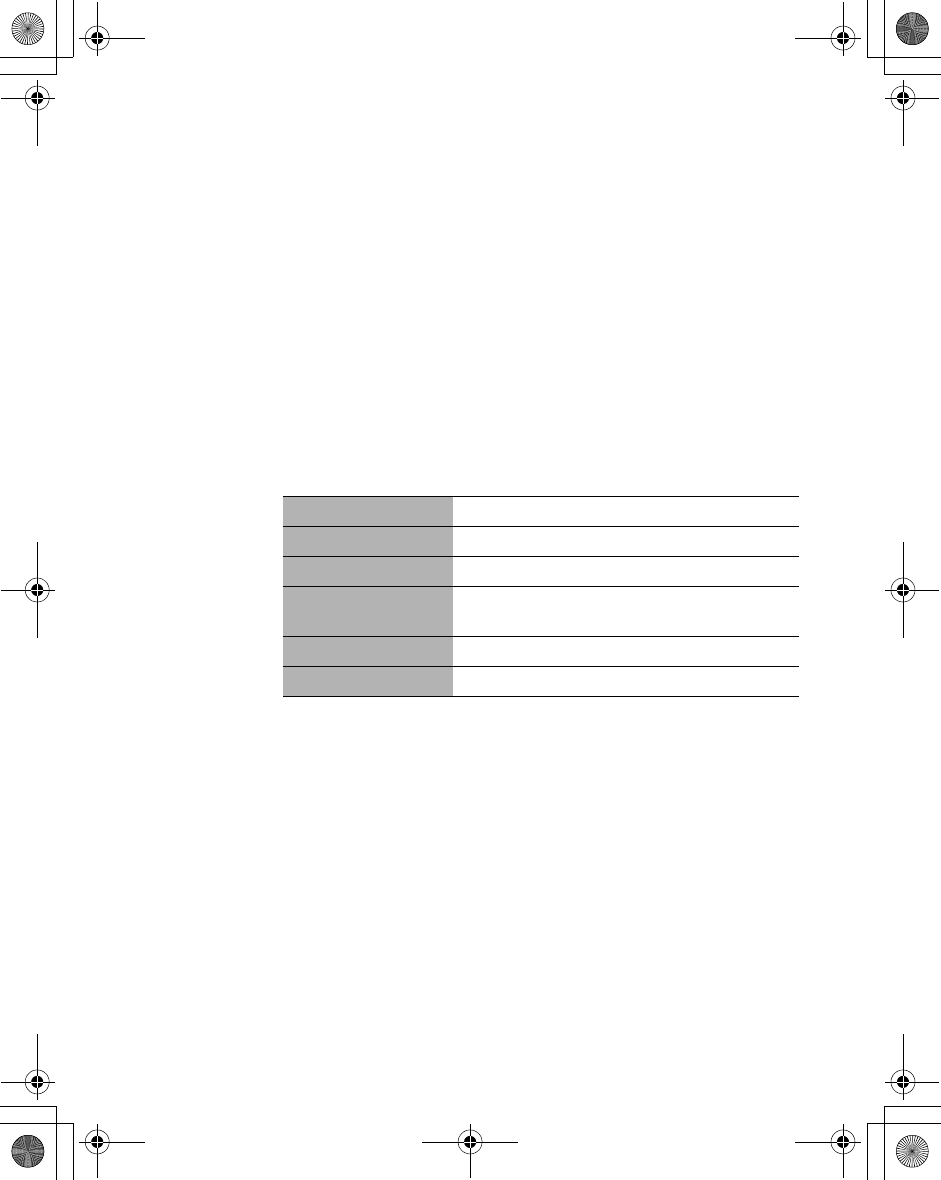
36 My Phone Menu
Profiles
Activating a profile
You can switch between 6 different profiles in your phone, each
with a distinct combination of alert method, ringtone, etc. Profiles
are set up for use in different environments.
From My Phone
1. 4Profiles A(Select)
2. 4 required profile A(Options)
3. 4Activate A(Select)
The following profiles are available:
Normal Suitable for everyday settings.
Quiet Ringtone for formal occasions.
Outdoors For noisy environments.
Headset Ringing with vibration when it is difficult to hear
the ringtone.
Meeting For meetings.
Customer For business settings.
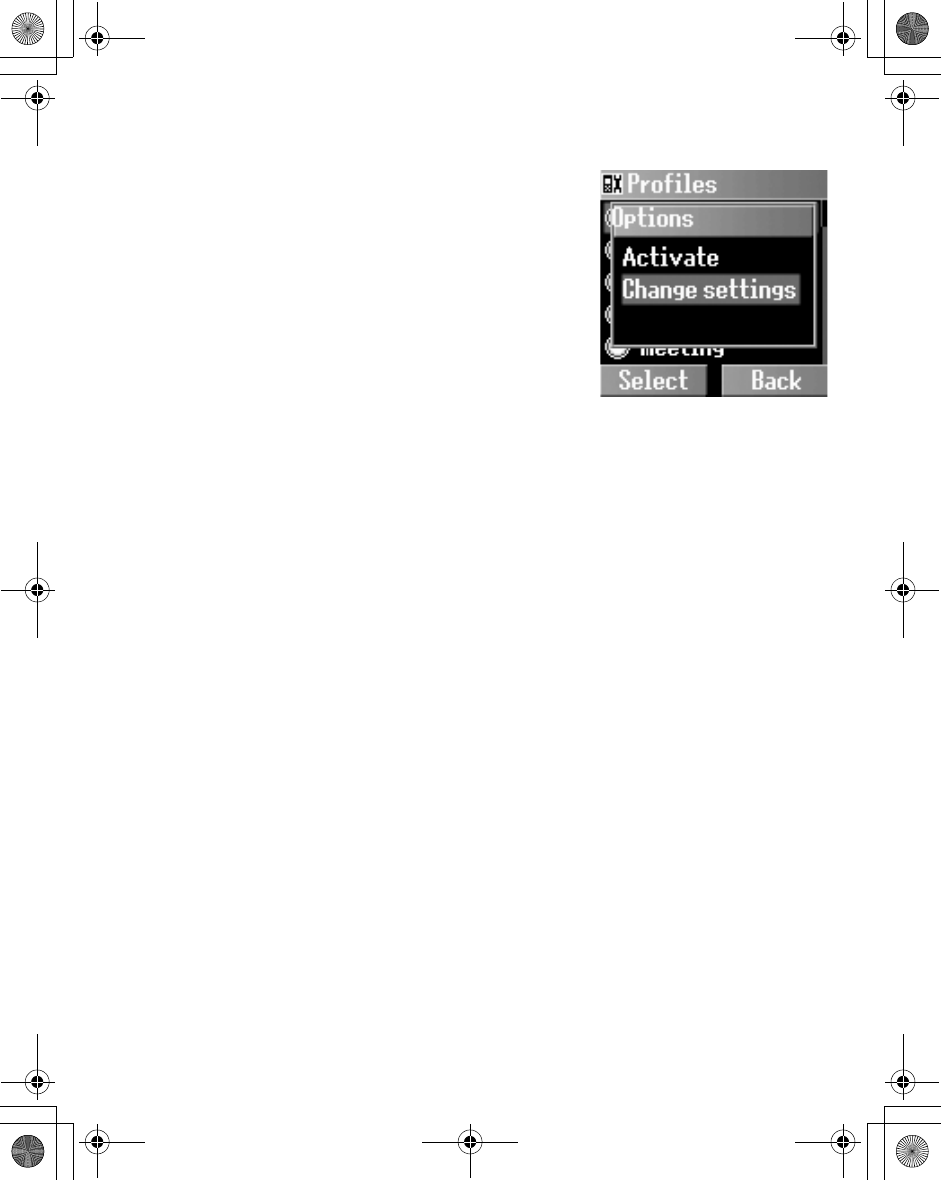
My Phone Menu 37
Setting a profile
You can customise a profile by
changing the alerts, ring volume,
warning tone, key tone, and/or
brightness.
Alerts:
From My Phone
1. 4Profiles A(Select)
2. 4 required profile A(Options)
3. 4Change settings A(Select)
4. 4Alerts A(Select)
5. 4 required alert A(Select)
The following options are available when a call or message is
received:
- Ring only
- None
- Ring & Vibrate
- Vibrate only
-Ring once
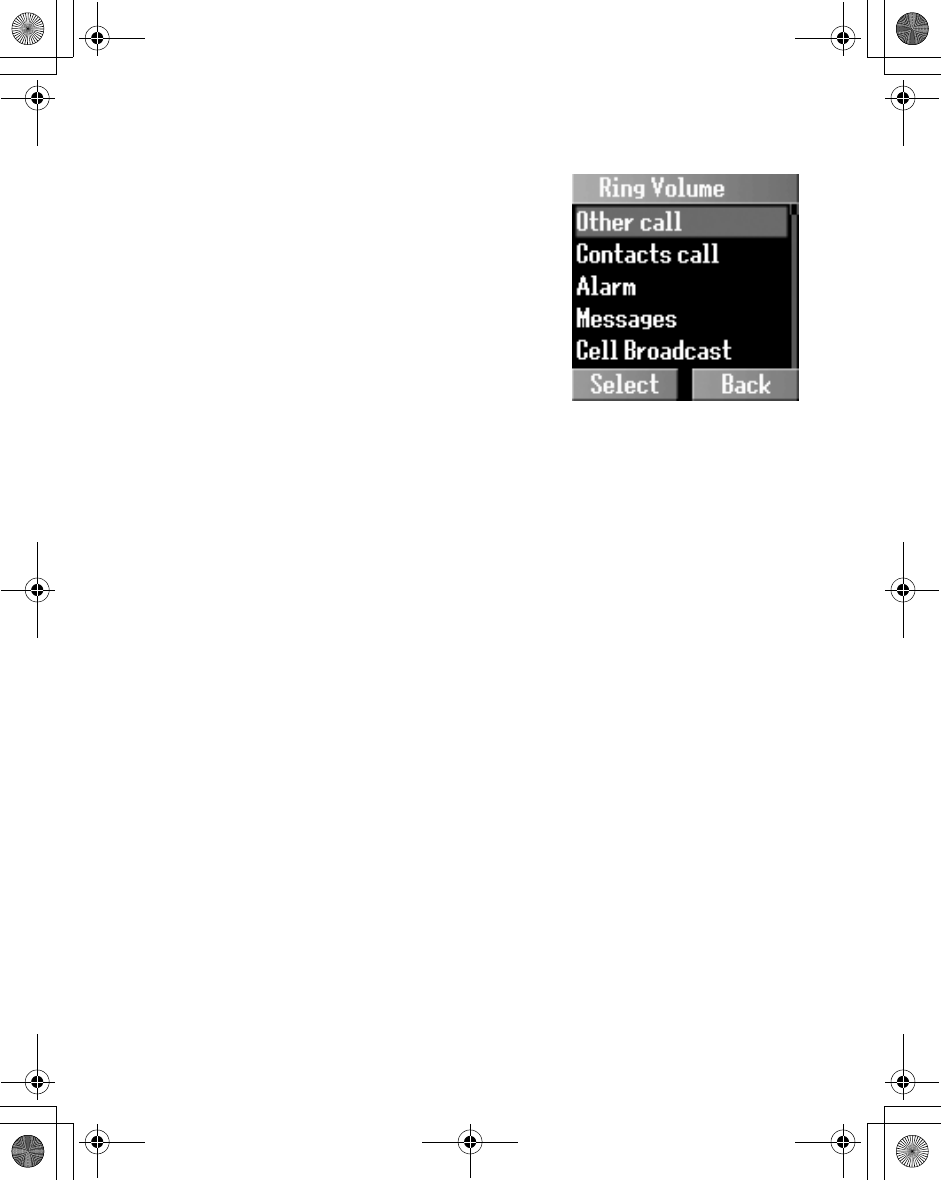
38 My Phone Menu
Ring volume:
From My Phone
1. 4Profiles A(Select)
2. 4 required profile
A(Options)
3. 4Change settings
A(Select)
4. 4Ring volume A(Select)
5. 4 required event A(Select)
6. 4 Adjust the volume level
A(OK)
You can change the ring volume of the following events:
(See "Sounds" on page 30 for details.)
- Other call
- Contacts call
-Alarm
- Messages
- Cell Broadcast
- Group 1~10
Warning tone:
From My Phone
1. 4Profiles A(Select)
2. 4 required profile A(Options)
3. 4Change settings A(Select)
4. 4Warning tone A(Select) > On/Off
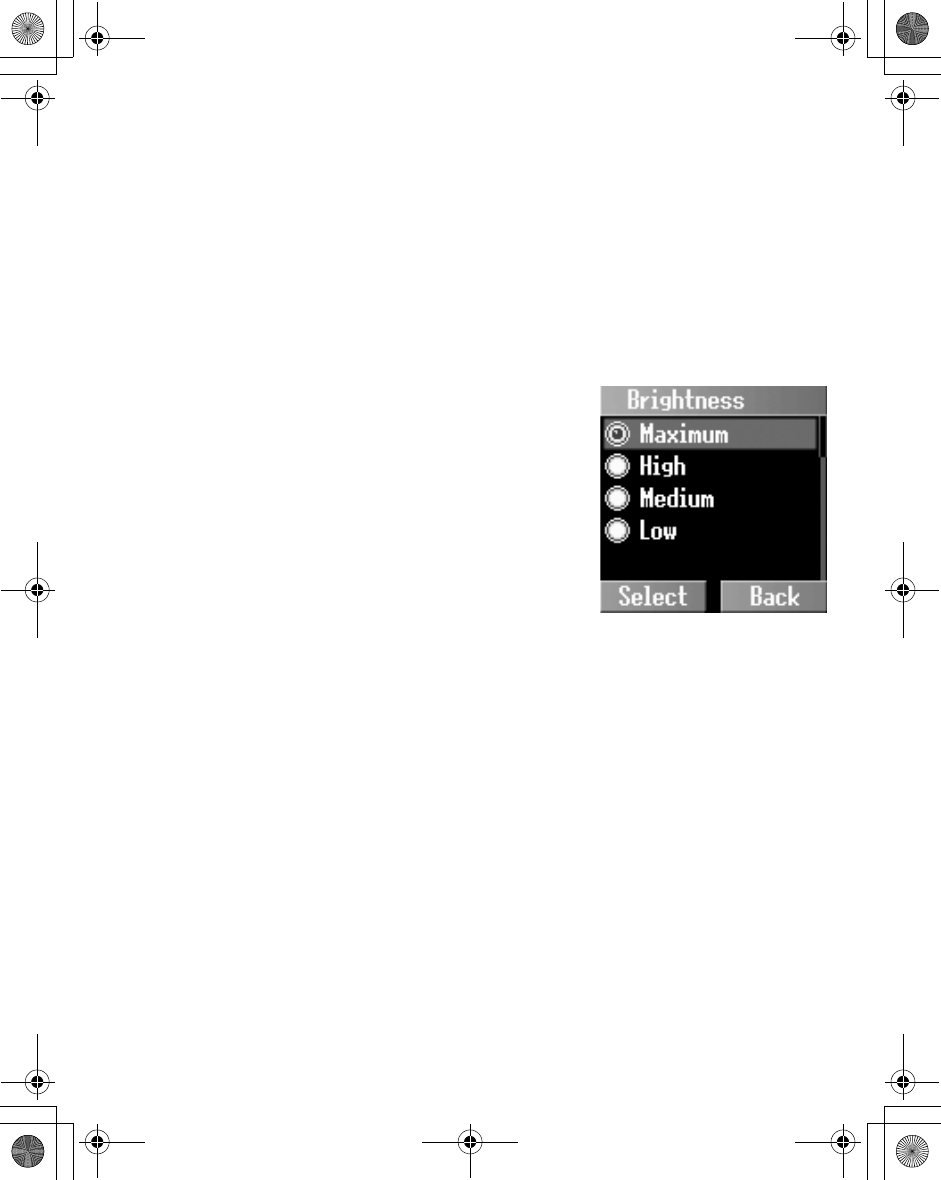
My Phone Menu 39
Key tone:
From My Phone
1. 4Profiles A(Select)
2. 4 required profile A(Options)
3. 4Change settings A(Select)
4. 4Key tone A(Select)
5. 4Off, Tone 1, Tone 2 or Tone 3 A(Select)
Brightness:
From My Phone
1. 4Profiles A(Select)
2. 4 required profile
A(Options)
3. 4Change settings
A(Select)
4. 4Brightness A(Select)
5. 4Maximum,High,Medium,
or Low A(Select)
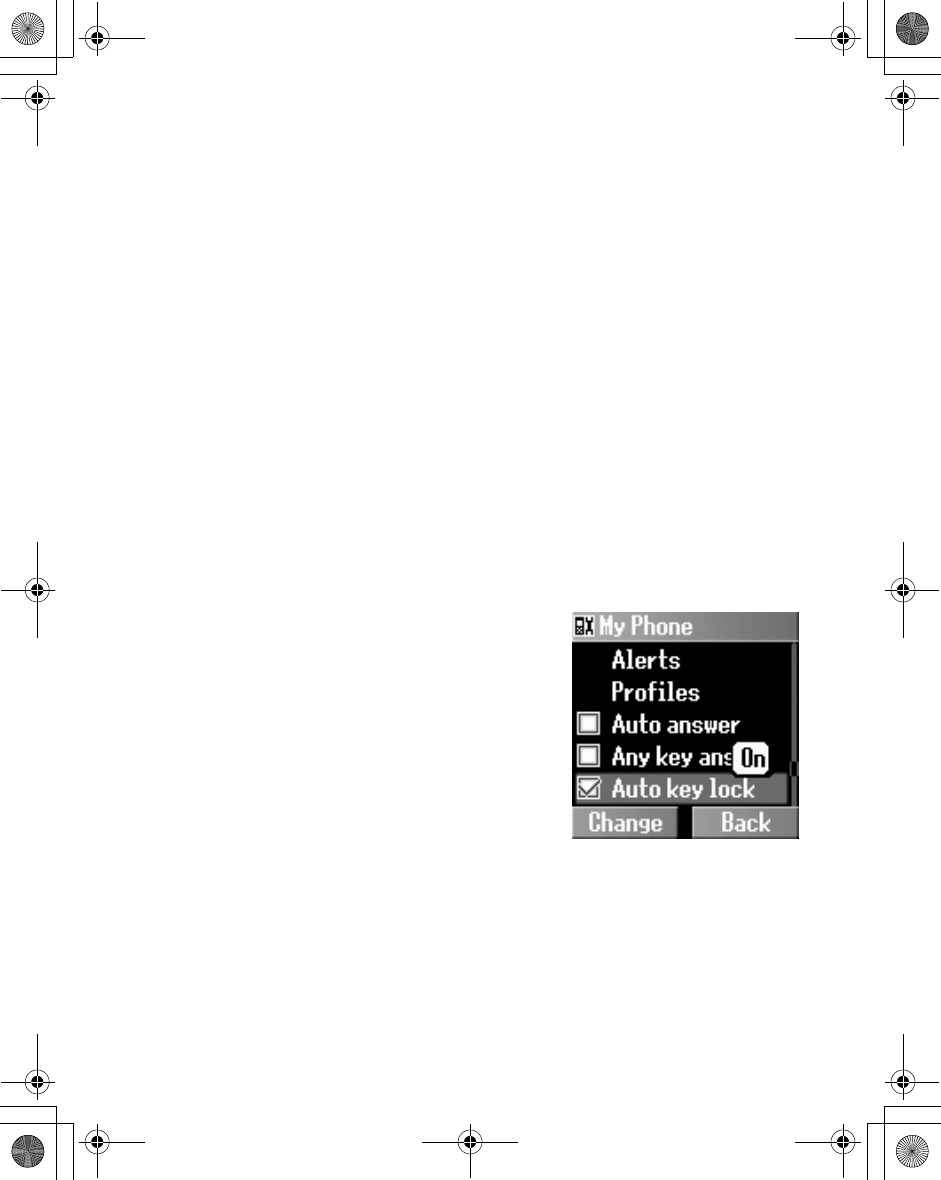
40 My Phone Menu
Auto answer
When you use the optional personal hands free earpiece, you can
answer a call automatically.
From My Phone
4Auto answer A(Change) > On/Off
Any key answer
Calls can be answered by pressing any key (except D).
From My Phone
4Any key answer A(Change) > On/Off
Auto key lock
The Auto key lock is used to prevent any keys from being pressed
accidentally e.g. when the phone is being carried. This function
automatically turns on shortly after the phone returns to Idle
mode.
From My Phone
4Auto key lock A(Change) >
On/Off
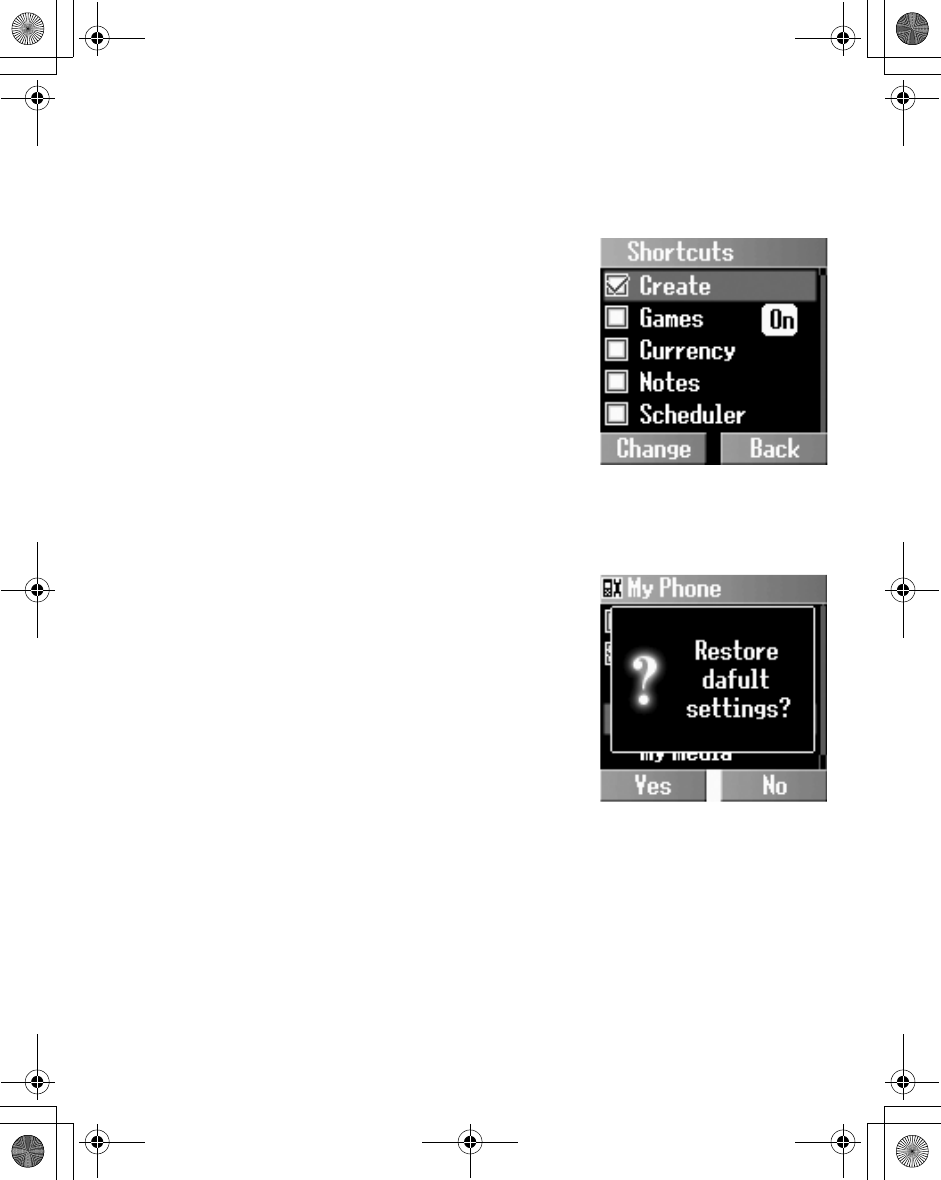
My Phone Menu 41
Shortcuts
It is possible to make the shortcut for the specific menu so that you
can access the menu directly from Idle mode.
From My Phone
1. 4Shortcuts A(Select)
2. 4 required menu
A(Change) > On/Off
Defaults
All personal settings are returned to their factory default settings.
From My Phone
1. 4Defaults A(Select)
2. “Restore default settings?”
A(Yes) or @(No)
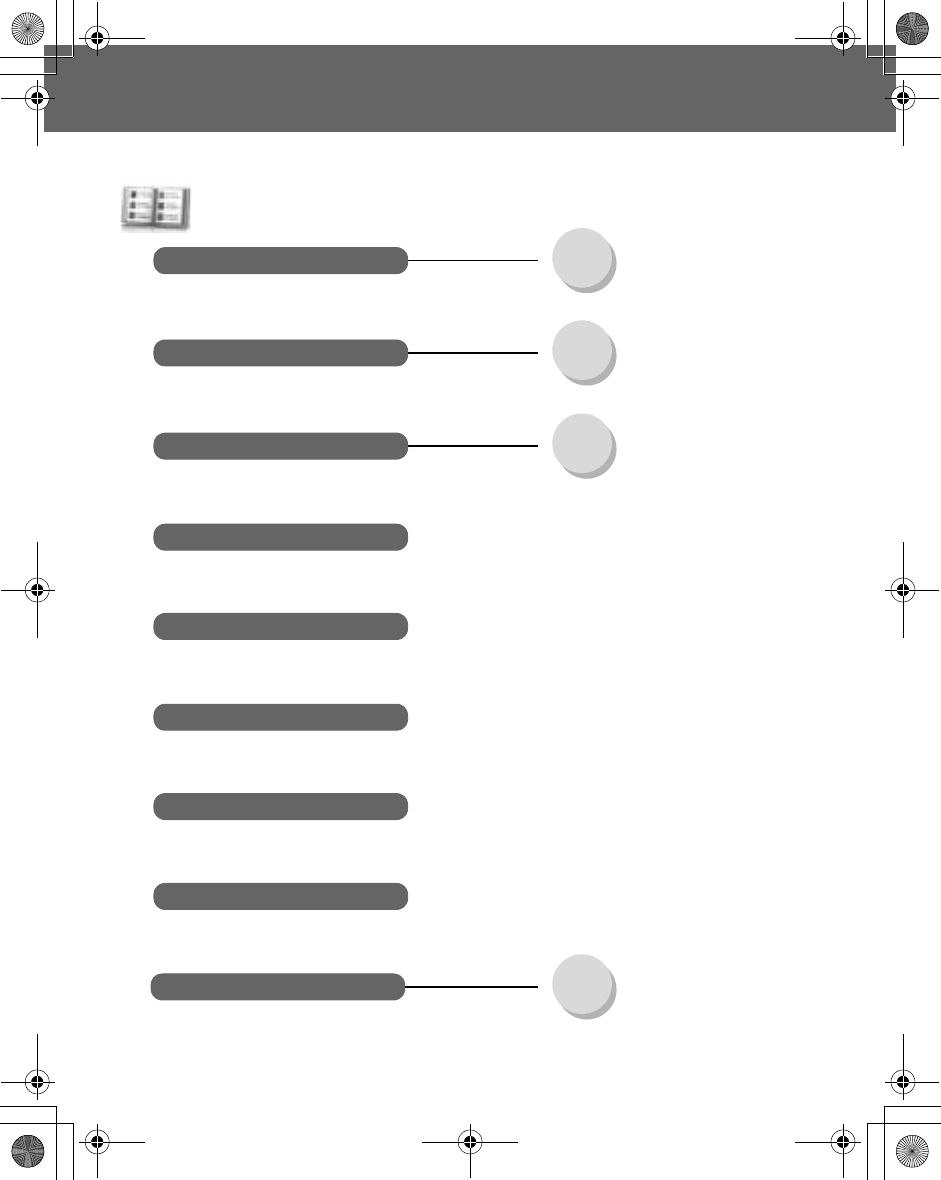
42 Contacts Menu
Contacts Menu
My Numbers
My Contacts
Contacts
SDN
Hotkey dial
SIM ............................................43
Phone ........................................43
SIM ............................................46
Phone ........................................47
Group 1~10 ...............................49
Memory status
Information number
Groups
SIM ............................................52
Phone ........................................52
Create
Browse
.......................................................................................49
.......................................................................................50
.......................................................................................50
.......................................................................................51
.......................................................................................52
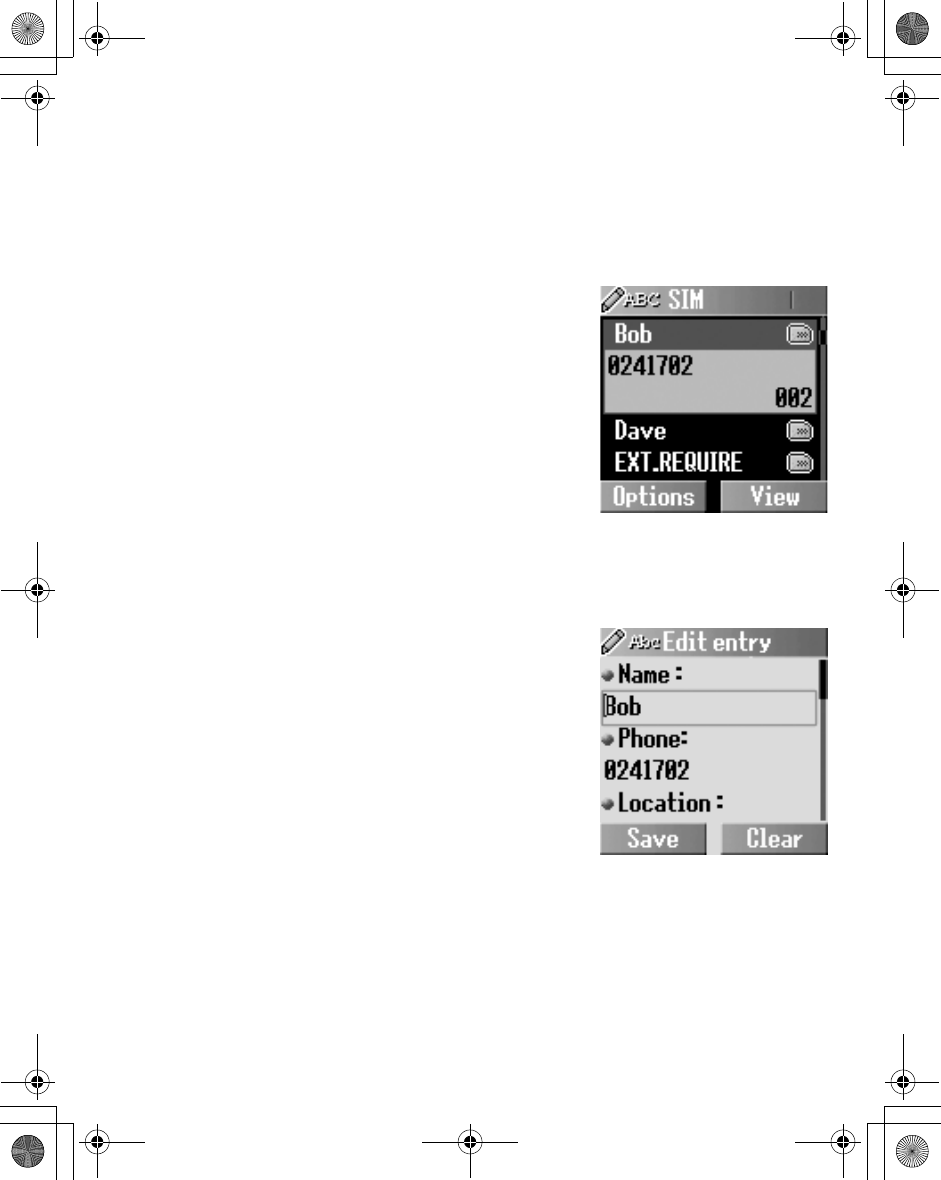
Contacts Menu 43
Browsing the Contacts list
Viewing the Contacts list in your SIM/Phone
You can search for a number in the Contacts list.
From Contacts
1. 4Browse > SIM or Phone
A(Select)
2. 4 required contact entry
@(View)
OR
Enter a letter to find a contact
beginning with the specific letter
3. A(Options)
4. 4View A(Select)
Editing the Contacts list
From Contacts
1. 4Browse > SIM or Phone
A(Select)
2. 4 required contact entry
A(Options)
3. 4Edit A(Select)
4. Enter the name 5
5. Enter the phone number 5
6. @(Change) required
location 5
7. @(Change) required record number A(Save)
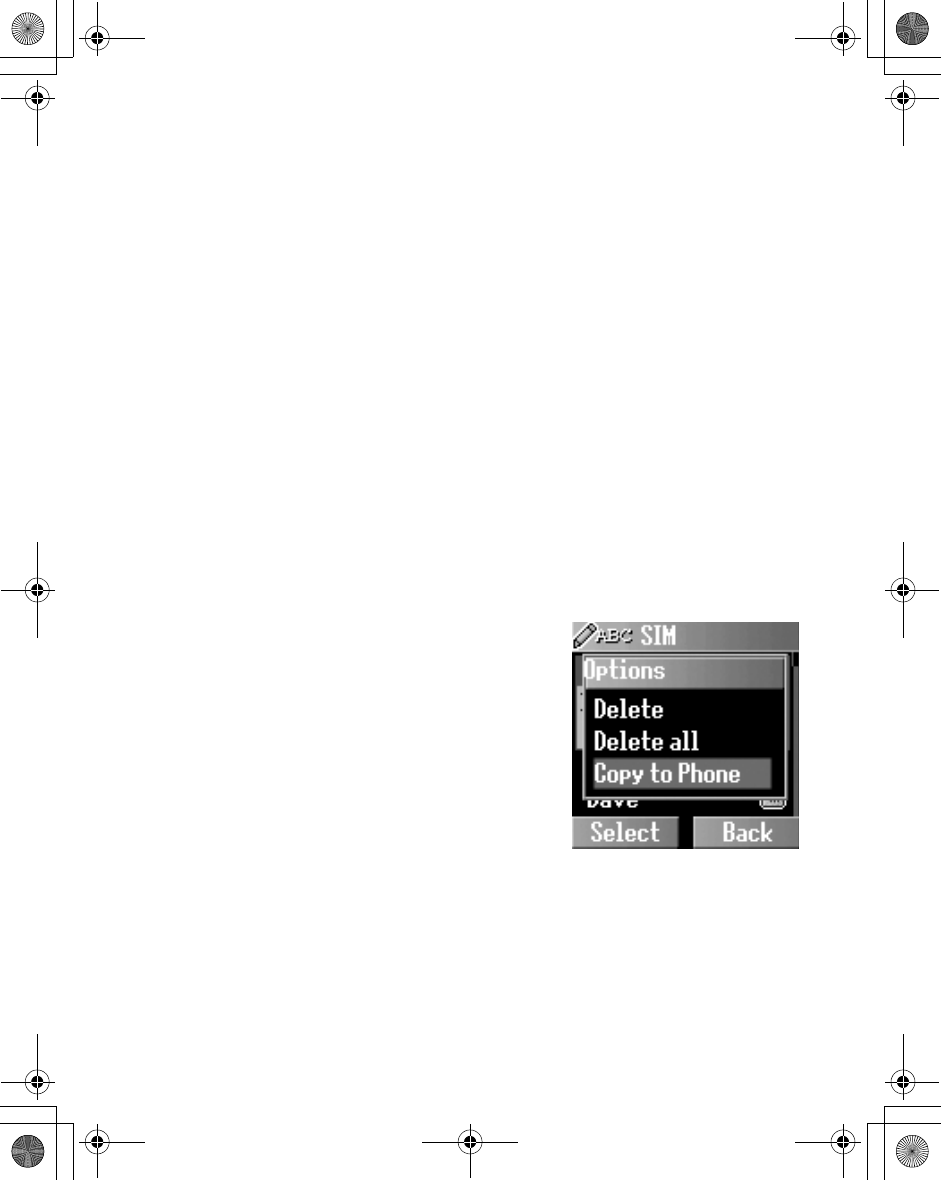
44 Contacts Menu
Deleting a Contacts entry
From Contacts
1. 4Browse > SIM or Phone A(Select)
2. 4 required contact entry A(Options)
3. 4Delete A(Select)
4. “Delete this entry?”
A(Yes) or @(No)
Deleting all Contacts entries
From Contacts
1. 4Browse > SIM or Phone A(Select)
2. A(Options)
3. 4Delete all A(Select)
4. “Delete all entries?”A(Yes) or @(No)
Copying the Contacts entries to your SIM/Phone
From Contacts
1. 4Browse > SIM or Phone
A(Select)
2. 4 required contact entry
A(Options)
3. 4Copy to SIM or Copy to
Phone A(Select)
4. “Copy entry to phone?” or
“Copy entry to SIM card?”
A(Yes) or @(No)
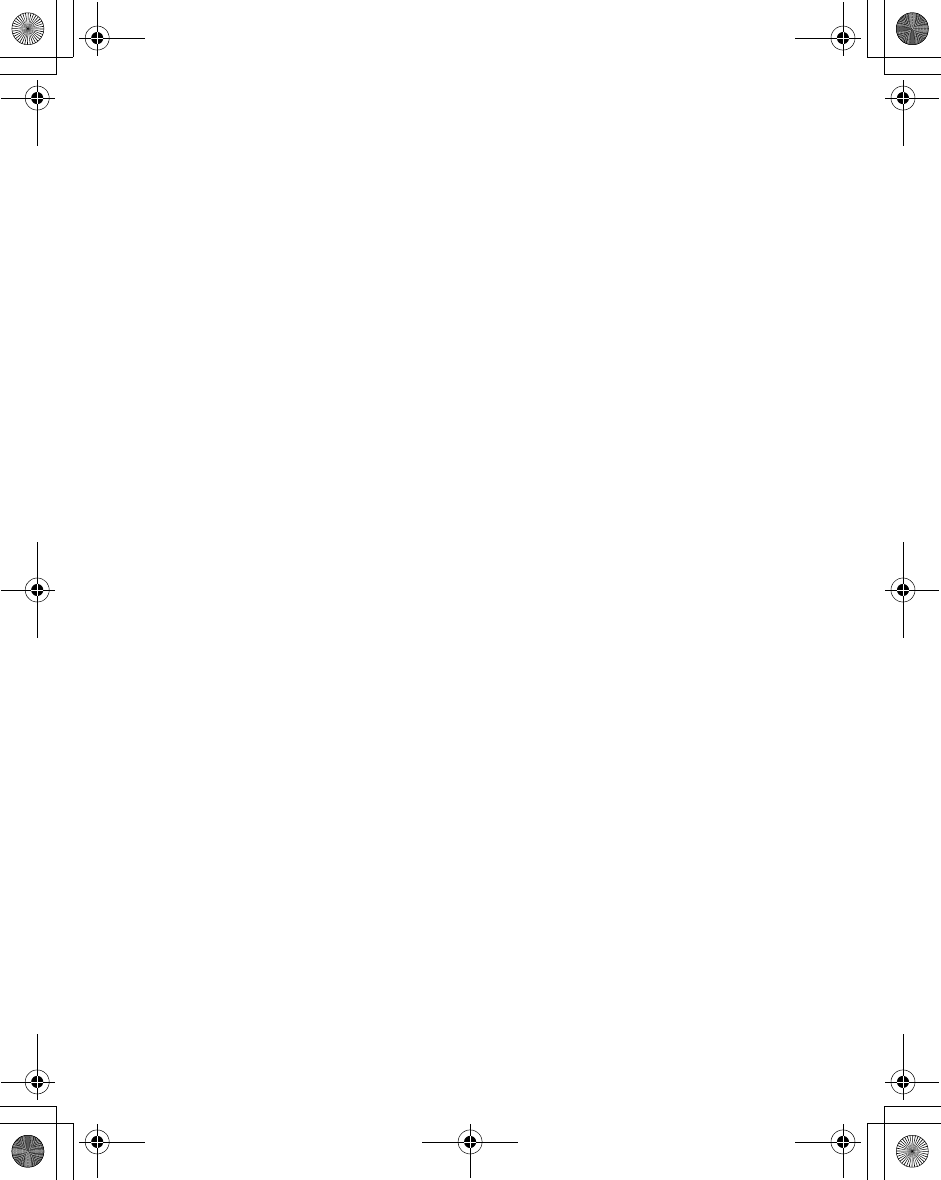
Contacts Menu 45
Copying all Contacts entries to your SIM/Phone
From Contacts
1. 4Browse > SIM or Phone A(Select)
2. 4 required contact entry A(Options)
3. 4Copy all to SIM or Copy all to Phone A(Select)
4. “Copy all entries to phone?” or “Copy all entries to SIM
card?”A(Yes) or @(No)
Sending as SMS
From Contacts
1. 4Browse > SIM or Phone A(Select)
2. 4 required contact entry A(Options)
3. 4Send SMS A(Select)
4. Enter text A(Options)
5. 4 required option A(Select)
The following options are available:
- Send
- Save
- Save & send
- Picture & sound
-Format
- User Messages
ãPlease see “Creating an SMS message” on page 82 for details.
Sending as MMS
From Contacts
1. 4Browse > SIM or Phone A(Select)
2. 4 required contact entry A(Options)
3. 4Send MMS A(Select)
4. @(Insert)
5. 4 required media to insert A(Select)
6. A(Options)
7. 4 required option A(Select)
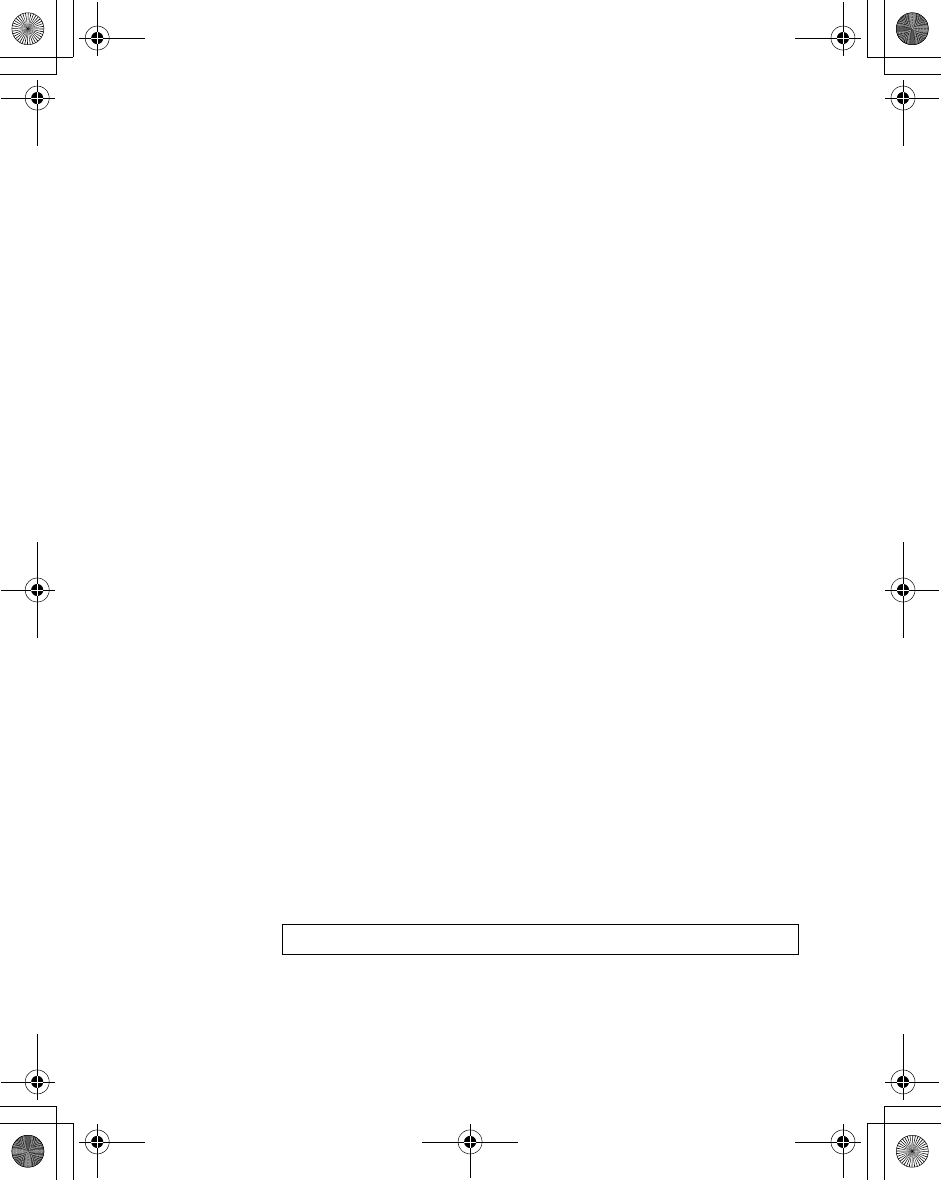
46 Contacts Menu
The following options are available when adding a required item
to your MMS message:
- Insert picture
- Insert text
- Insert video
- Insert sound
- Insert page
The following options are available after completing your MMS
message:
- Send
-Store
- Delete object
-Info
- Page timing
- Preview page
- Preview MMS
ãPlease see “MMS Options” on page 77 for details.
Creating a Contacts list
Storing a Contacts entry in your SIM
From Contacts
1. 4Create A(Select)
2. 4SIM A(Select)
3. Enter the name 5
4. Enter the phone number 5
5. @(Change) required location 5
6. @(Change) required record number A(Save)
ã"Saved in SIM card" is displayed.
ãYou can select the country code by pressing @(+List) in step 4.
NOTE: The length and amount of data are SIM dependent.
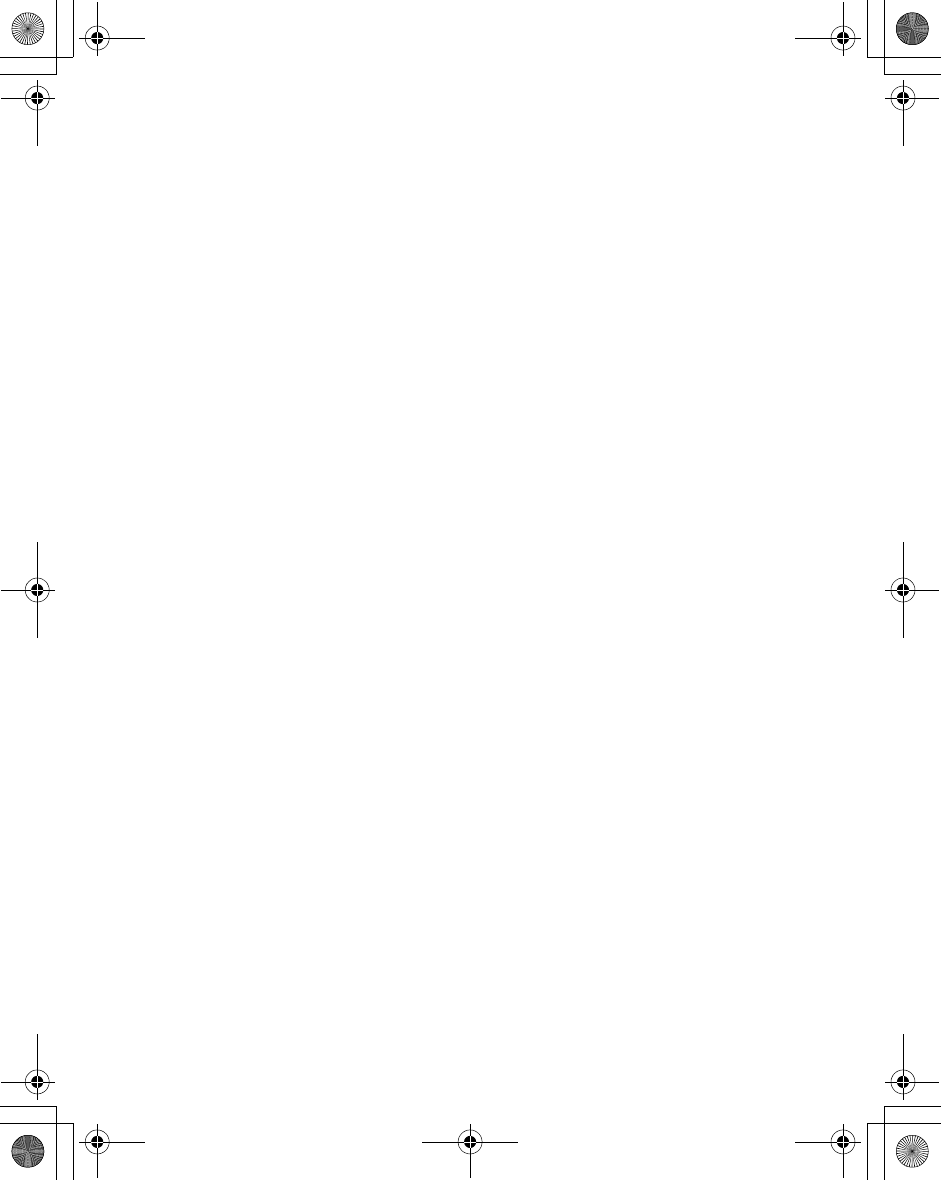
Contacts Menu 47
Storing a Contacts entry in your phone
From Contacts
1. 4Create A(Select)
2. 4Phone A(Select)
3. Enter the name 5
4. Enter the phone number 5
5. Enter the E-mail address 5
6. Enter notes 5
7. @(Change) required group 5
8. A(Options) > 4Change A(Select) >
4 required caller ID 5
9. A(Options) > 4Change A(Select) >
4 required melody A(Select)
10. When entries are completed, A(Options)
11. 4Save A(Select)
ã“Saved in phone” is displayed.
ãYou can select the country code by pressing @(+List) in step 4.
ãYou can also enter or select an office phone number and mobile
phone number under the phone number box following the same
procedure as in step 4.
ãThe entries are grouped together and are retained even if you damage
your SIM.
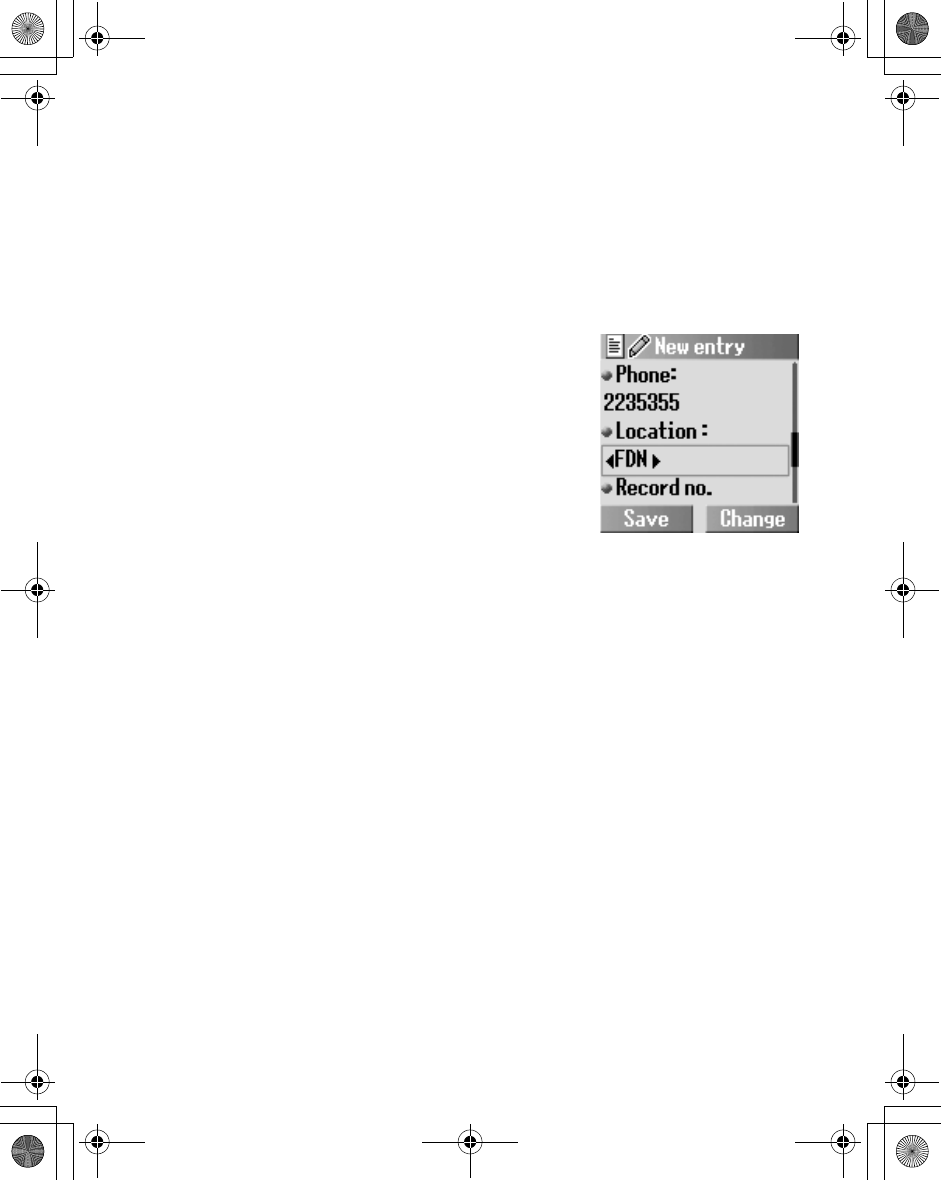
48 Contacts Menu
FDN
Storing a Contacts entry in FDN:
To store a fixed dial number, you need to enter your PIN2 code.
The Fixed dial feature allows you to limit your outgoing calls to a
certain set of numbers saved in FDN, which is located in your SIM.
When this function is on, only the Fixed dial numbers can be
dialled, and any attempt to call any other number will fail.
From Contacts
1. 4Create A(Select)
2. 4SIM A(Select)
3. Enter the name 5
4. Enter the phone number 5
5. @(Change) FDN 5
6. @(Change) required record
number A(Save)
7. Enter your PIN2 A(OK)
ãTo activate this function, you need to set Fixed dial on. See page 97.
ãYou can select the country code by pressing @(+List) in step 4.
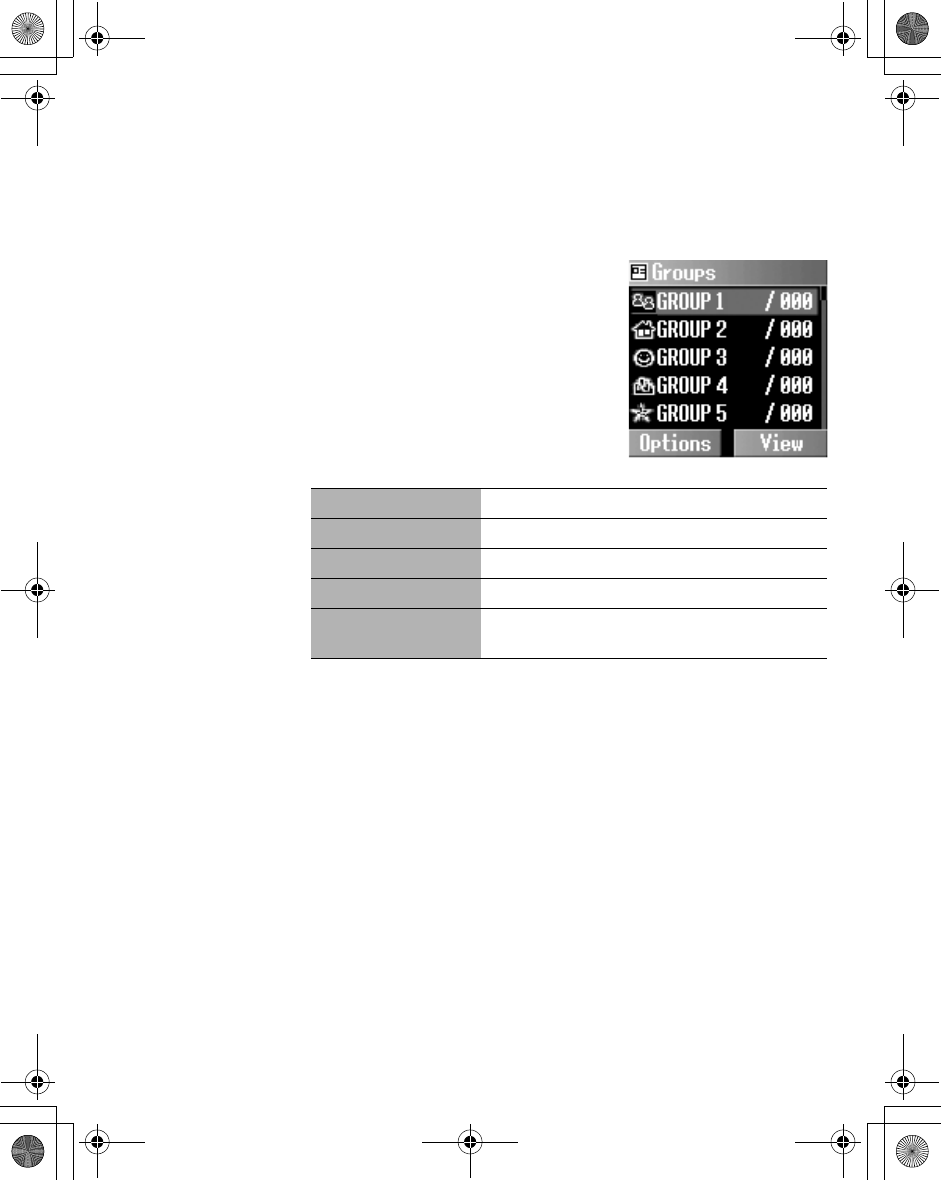
Contacts Menu 49
Groups
You can categorise the Contacts list stored in your phone into 10
groups. You can select a particular ringtone for each group to
identify the incoming call.
From Contacts
1. 4Groups A(Select)
2. 4 required group A(Options)
3. 4 required option A(Select)
The following options are available:
SDN
The SDN is a number provided by your network operator. These
numbers are stored in the GSM-based SIM. You can view the list
of SDNs or call the required SDN.
From Contacts
1. 4SDN A(Select)
2. 4 required SDN A(Select) to call the number
OR
@(View) to view the details
View View the Contacts entries in the selected group.
Set ringtone Set the required ringtone.
Set image Set the required icon to identify the group.
Rename Rename the group.
Remove entries Delete all Contacts entries in the selected
group.
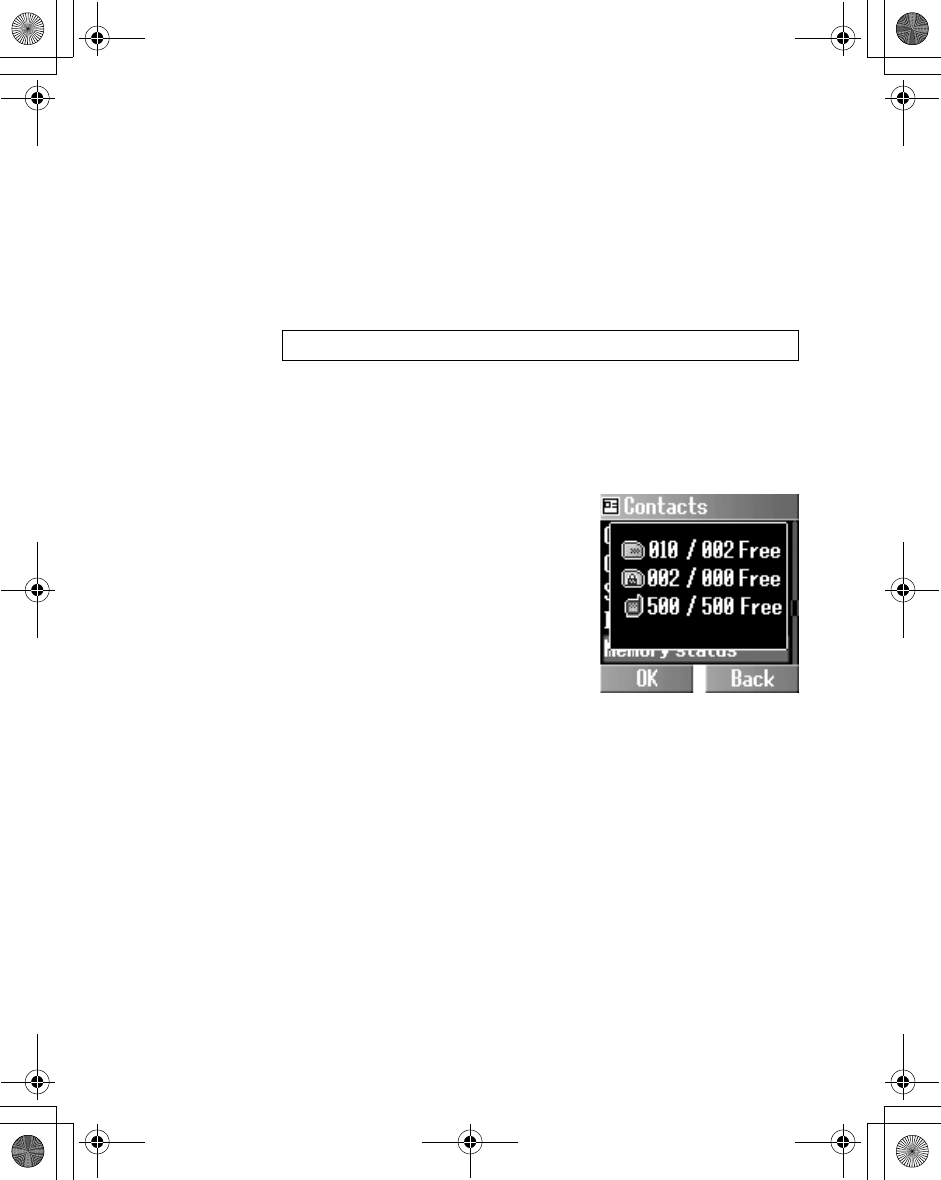
50 Contacts Menu
Information number
The Information number is sometimes included in a SIM which
supports CPHS.
From Contacts
1. 4Information number A(Select)
2. 4 required information number A(Select)
Memory status
Memory status shows how many locations are available in the
Contacts list.
From Contacts
4Memory status A(Select)
Maximum memory capacity:
- ADN: 255 locations
(SIM dependent)
- FDN: 50 locations (SIM dependent)
- Phone: 500 locations
ãADN (Abbreviated Dialling Number) is
used for quick access to frequently
dialled numbers.
NOTE: Information number is SIM dependent.
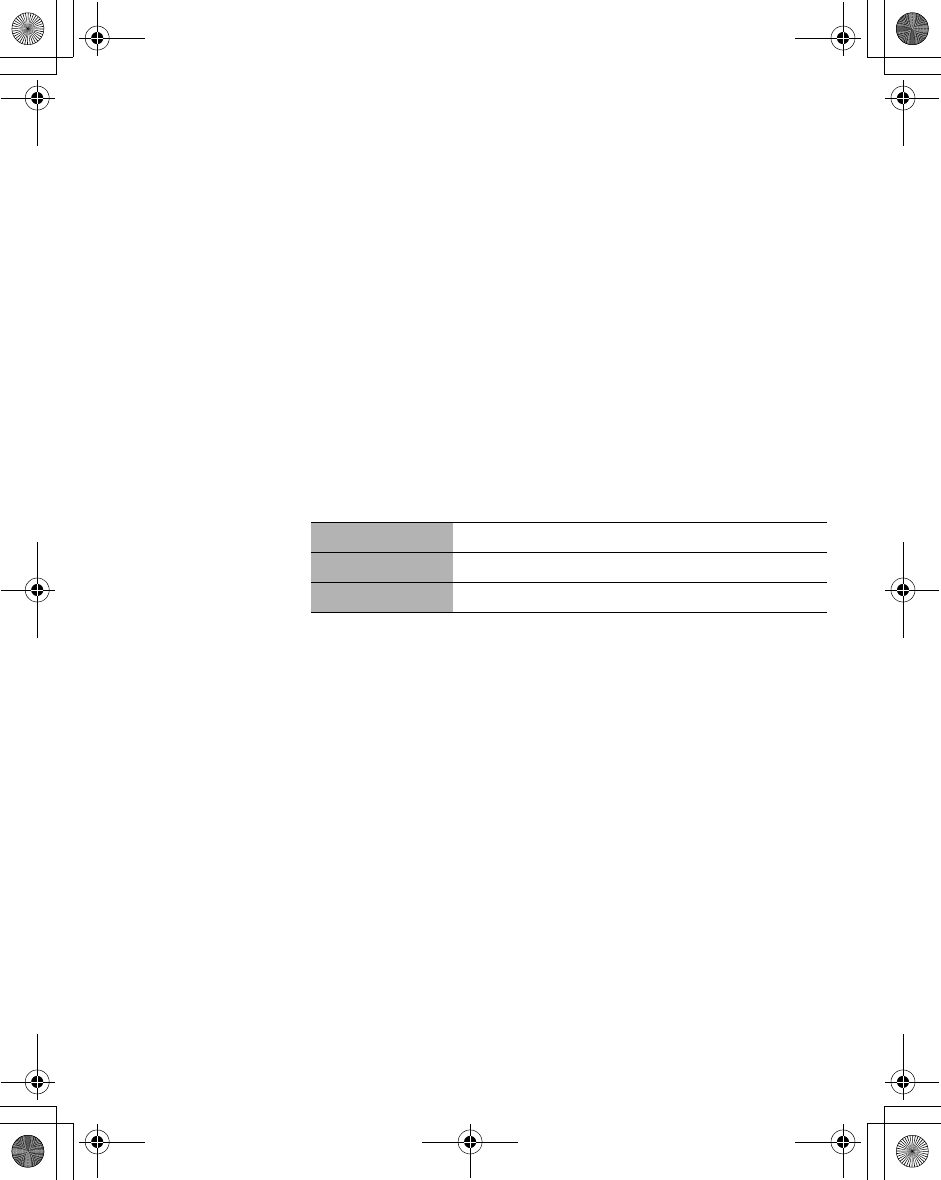
Contacts Menu 51
My Numbers
My Number is a handy phone book where names and phone
numbers can be stored and viewed.
From Contacts
1. 4My Numbers A(Select)
2. 4 required entry A(Options)
3. 4Edit A(Select)
4. Enter the phone number 5
5. Enter the name A(Save)
After selecting the required entry in step 2, you can view My
Numbers entries by pressing @(View).
The following options are available by pressing A(Options) in
step 2:
View View the selected My Numbers entry.
Edit Edit the selected My Numbers entry.
Delete Delete the selected My Numbers entry.
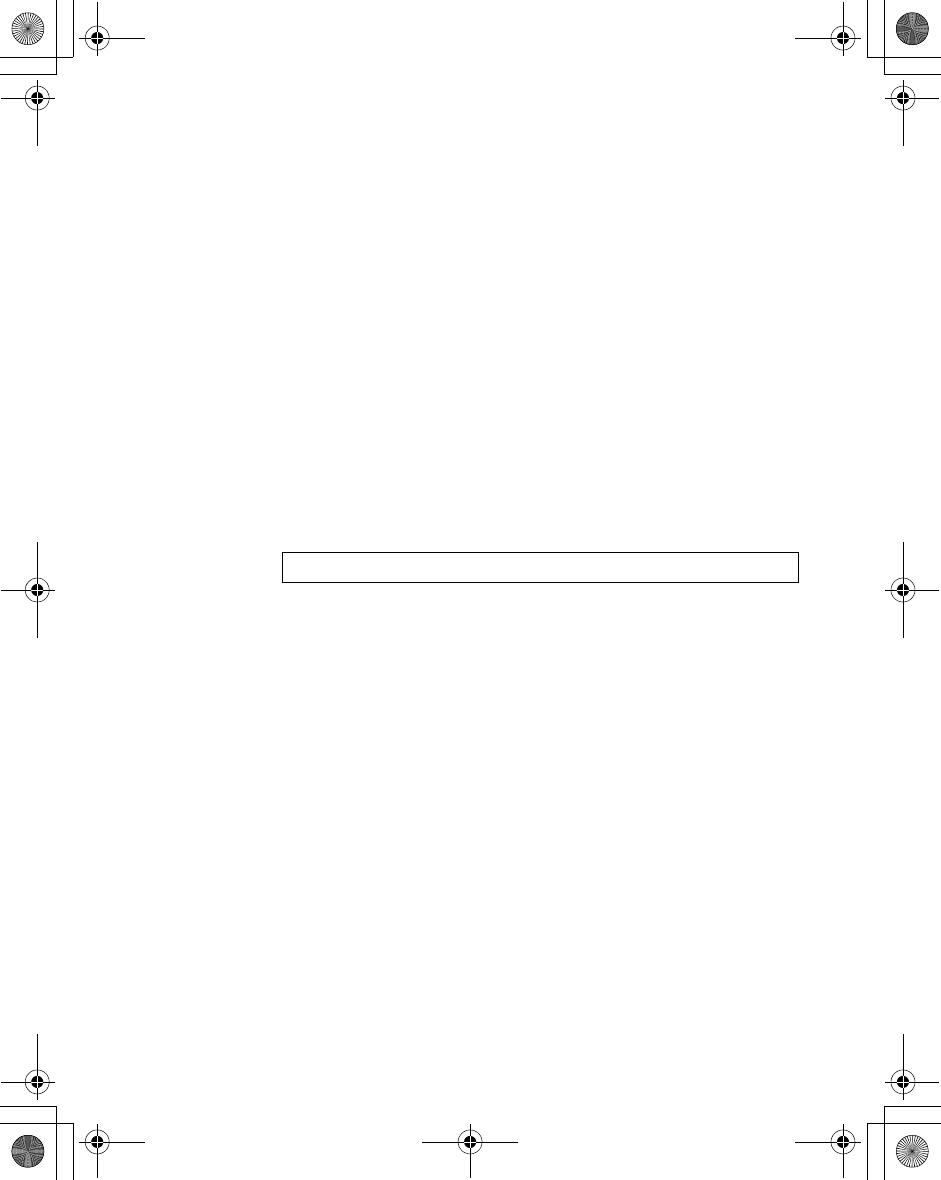
52 Contacts Menu
Hotkey dial
Setting the Hotkey dial
You can quickly dial phone numbers stored at locations 002~009
in the Contacts list.
From Contacts
1. 4Hotkey dial A(Select)
2. 4 required Hotkey @(Edit)
3. 4 required Contacts entry A(Select)
4. 4 required phone number A(Select)
5. “Switch on hotkey setting”A(Yes) or @(No)
6. 4 required Hotkey A(On/Off)
ãYou must assign a required Contacts entry a Hotkey before switching
the Hotkey on/off.
Using the Hotkey dial
In idle mode
Press and hold a numeric key (% ~ ,)
My Contacts
You can select SIM or Phone so that the Contacts list directly
accessed from Idle mode is set to the SIM or Phone Contacts list.
From Contacts
1. 4My Contacts A(Select)
2. 4SIM or Phone A(Select)
NOTE: This function is SIM dependent.
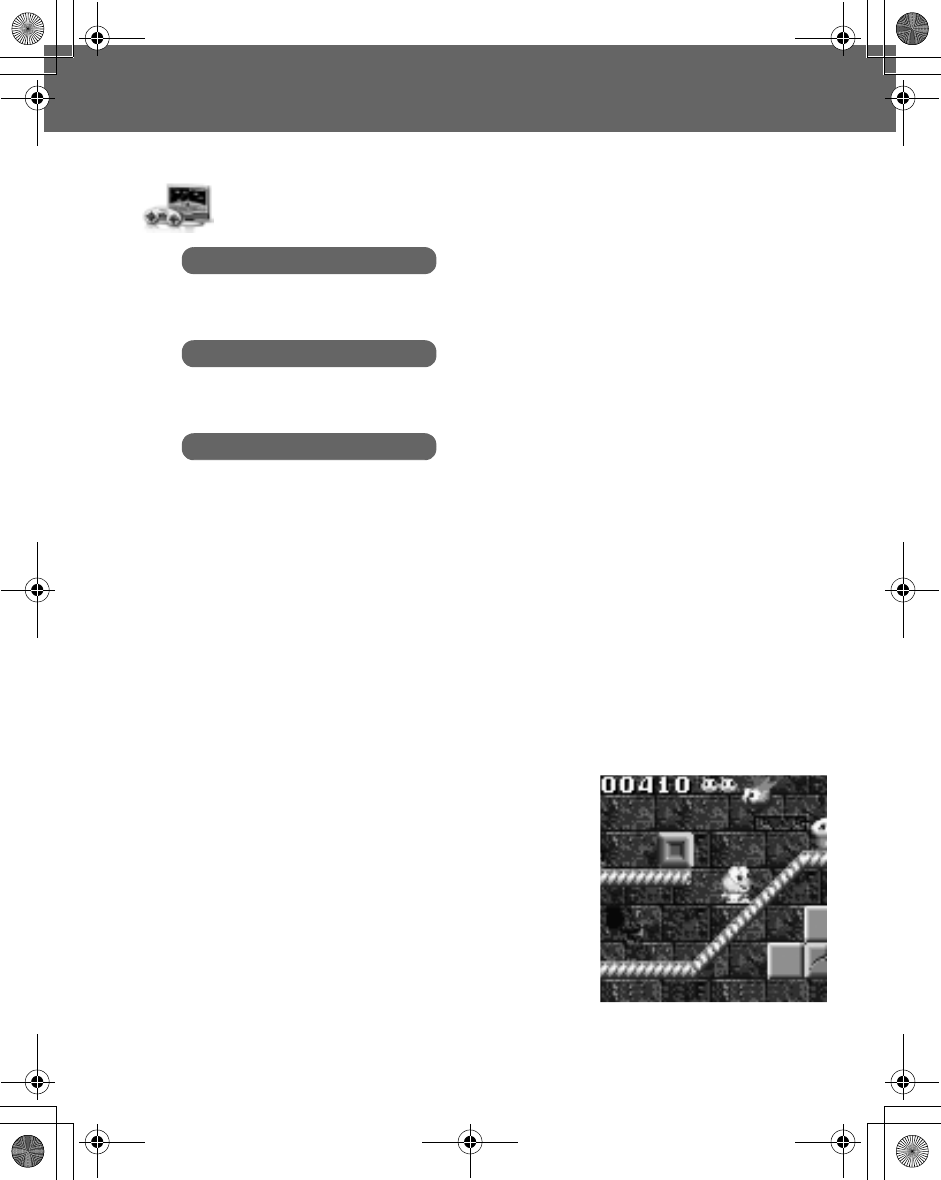
Games Menu 53
Games Menu
To select the game:
From Games
4Puddleland,Quadball or Exode A(Select).
Puddleland
You cannot help falling in love with the cute little frog making his
way by swallowing his enemies and spitting them out. Even the
monsters are adorable. But don’t be mistaken by the brilliant and
lovable characters. This is a challenging platform game, where
you need to keep on your toes if you want to stay ahead.
To start the game:
Press 4 to select Start, then
press A.
Key operation:
' or C (move left),
) or D (move right),
5,& or + (down),
1,$ or # (jump),
A (swallow and spit out),
@ (Quit), " or ! (pause).
Games
Puddleland
Exode
Quadball
.......................................................................................53
.......................................................................................54
.......................................................................................54
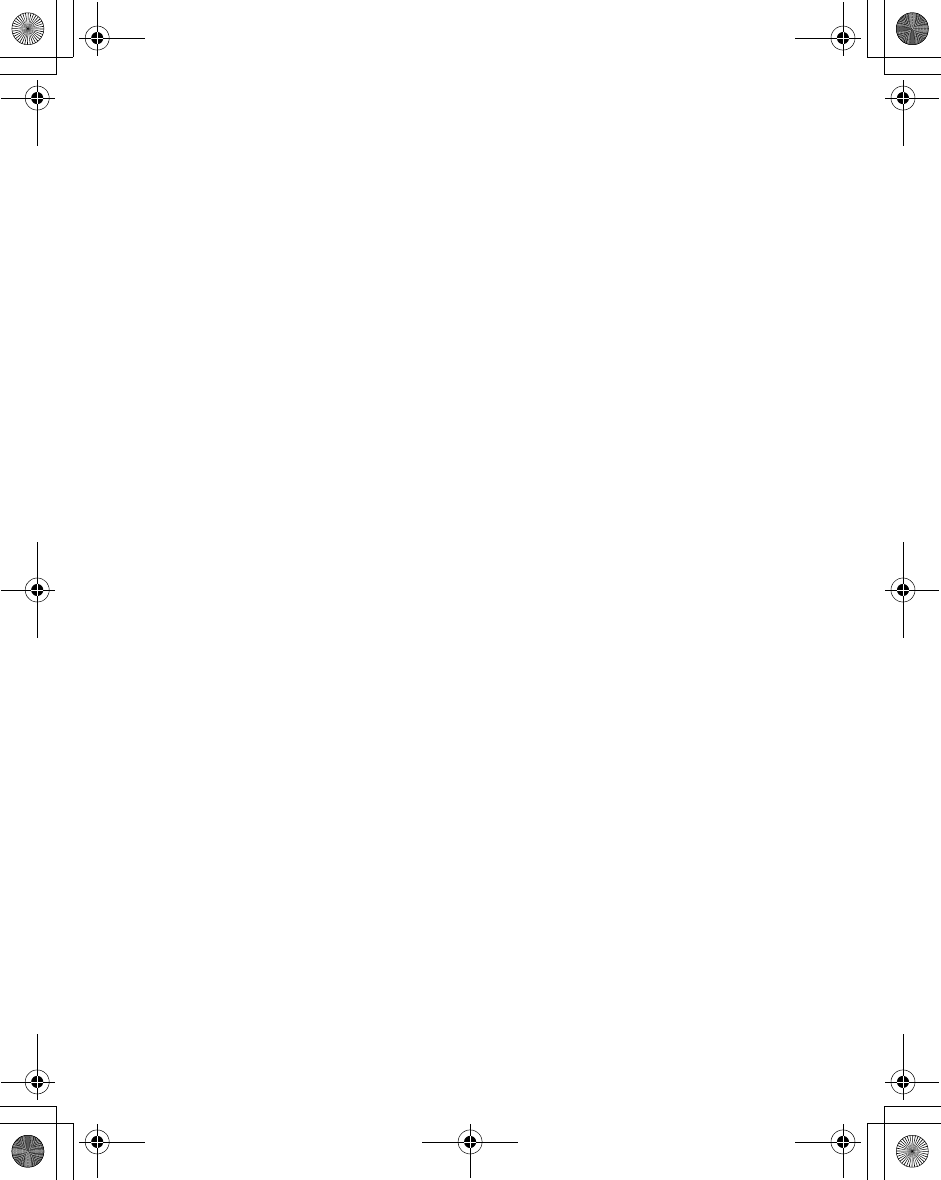
54 Games Menu
Quadball
You direct the differently coloured bubbles, and they merge with
bubbles of the same shape.
To start the game:
Press A to start the game.
Key operation:
' or C (left),
)or D (right),
% or 1 (rotate left),
+ or 5 (rotate right),
A or ( (quickly down),
@ or ! (paused).
Exode
The ball bounces off the walls and the bar that you control.
You pick up different objects that fall down when you destroy the
“bricks”.
To start the game:
Press A or ( to start the game.
Key operation:
C or ' (left),
D or ) (right),
A (start),
@ or ! (paused).
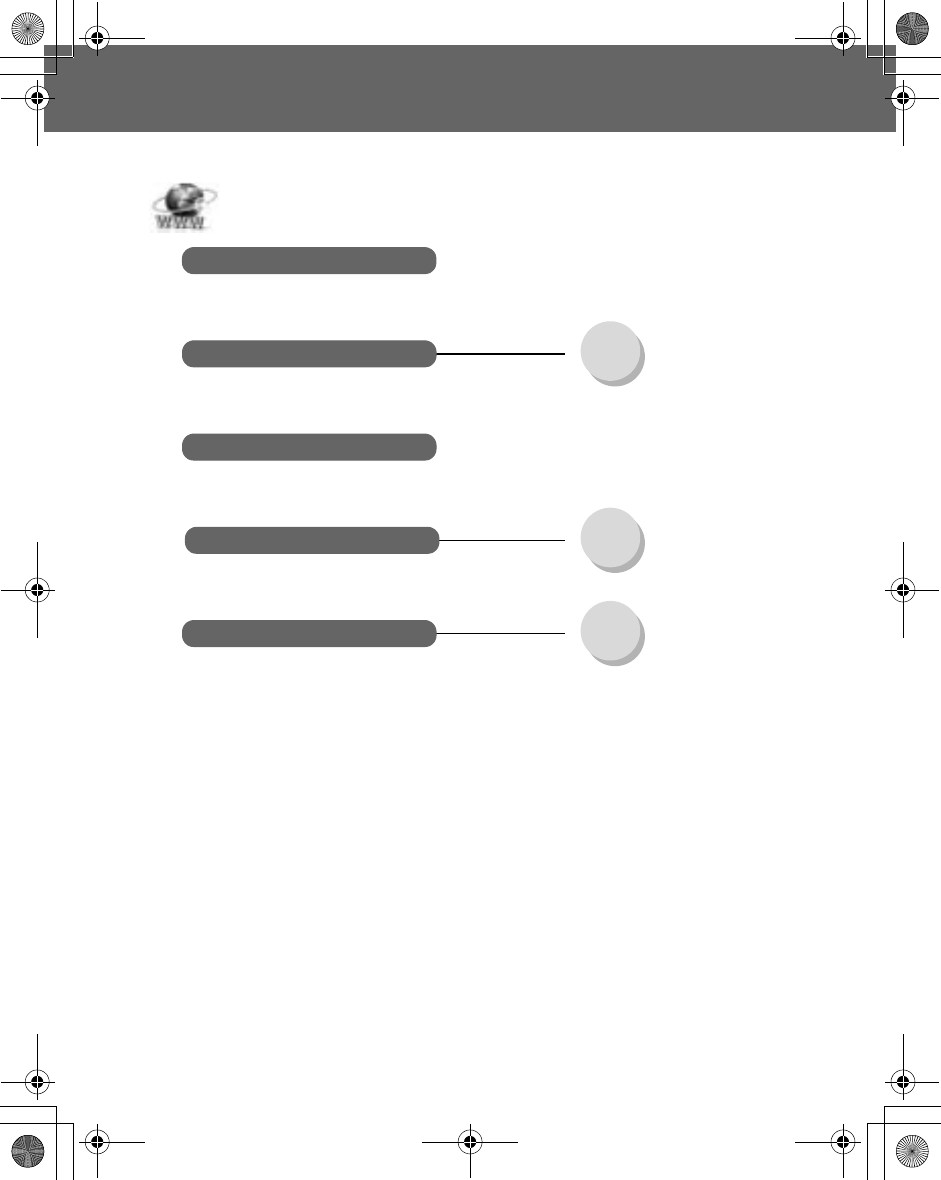
Browser Menu 55
Browser Menu
Start browser
Browser
Bookmark 1~10 ......................... 58
Bookmarks
Settings
Connectivity
CSD settings .............................60
GPRS settings........................... 60
GPRS Info ................................. 60
Push setting
Always all ..................................59
Always none .............................. 59
Always this specific SMS centre
..59
.......................................................................................57
.......................................................................................56
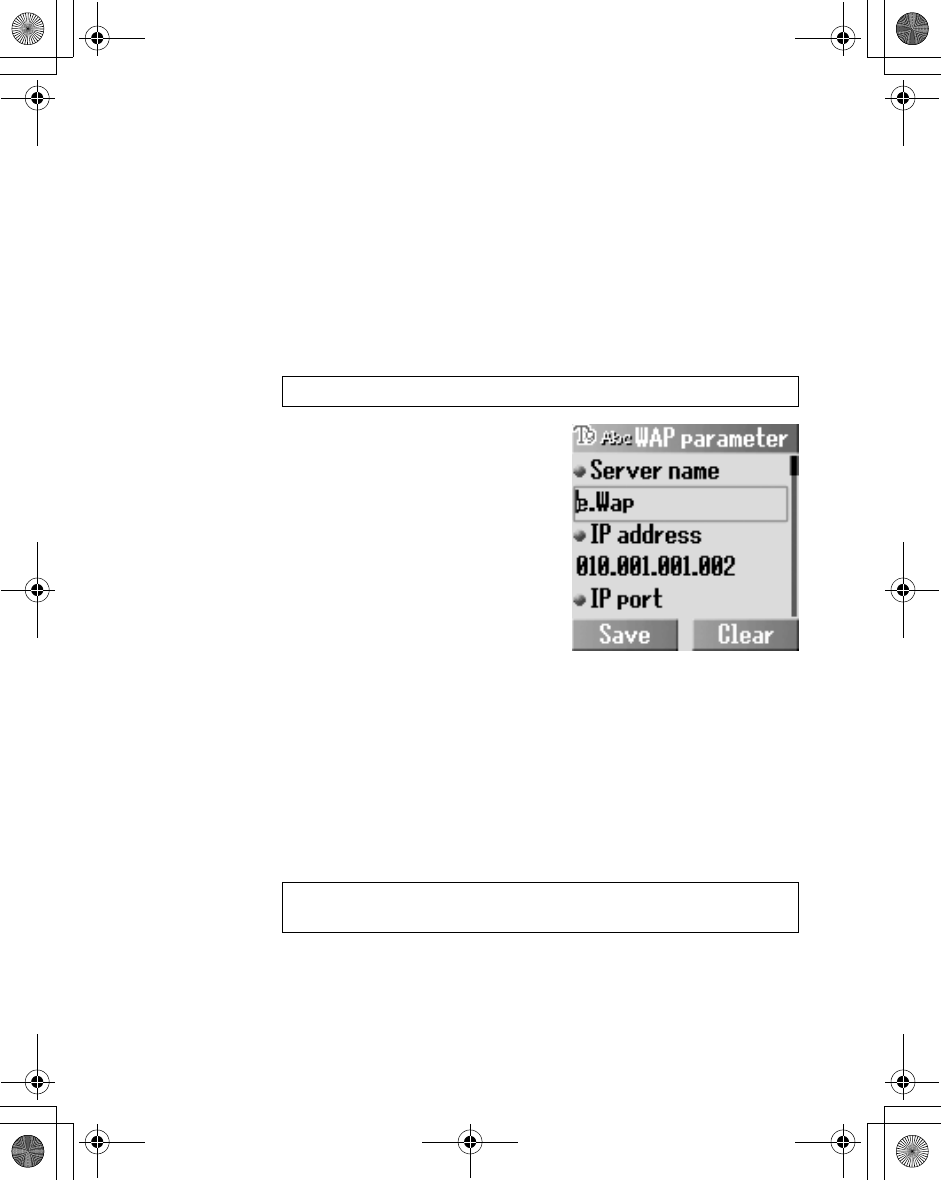
56 Browser Menu
Server settings
The phone’s WAP (Wireless Application Protocol) Browser
enables you to access Internet services supported by the network,
such as news, weather reports, sport etc.
Before Internet services can be accessed, you need to subscribe
to your network operator or Internet service provider (ISP) to
enable the relevant configuration information. Please contact your
network service provider if you have problems with your network
settings.
From Browser
1. 4Settings A(Select)
2. 4 required server @(Edit)
Five server settings can be set up in
the phone. If you find your server's
name under the settings option,
select the server and @(Edit).
If no settings are present, contact
your network service provider for
these settings.
You can edit the following settings:
- Server name
- IP address
-IP port
- Homepage
-Linger time
- Connection (Auto, CSD or GPRS setting)
- CSD settings
- GPRS settings
NOTE: Modifying the default settings may cause failure of the Browser.
NOTE: You need to set CSD settings or GPRS settings before setting
the server information. See “Connectivity” on page 60.
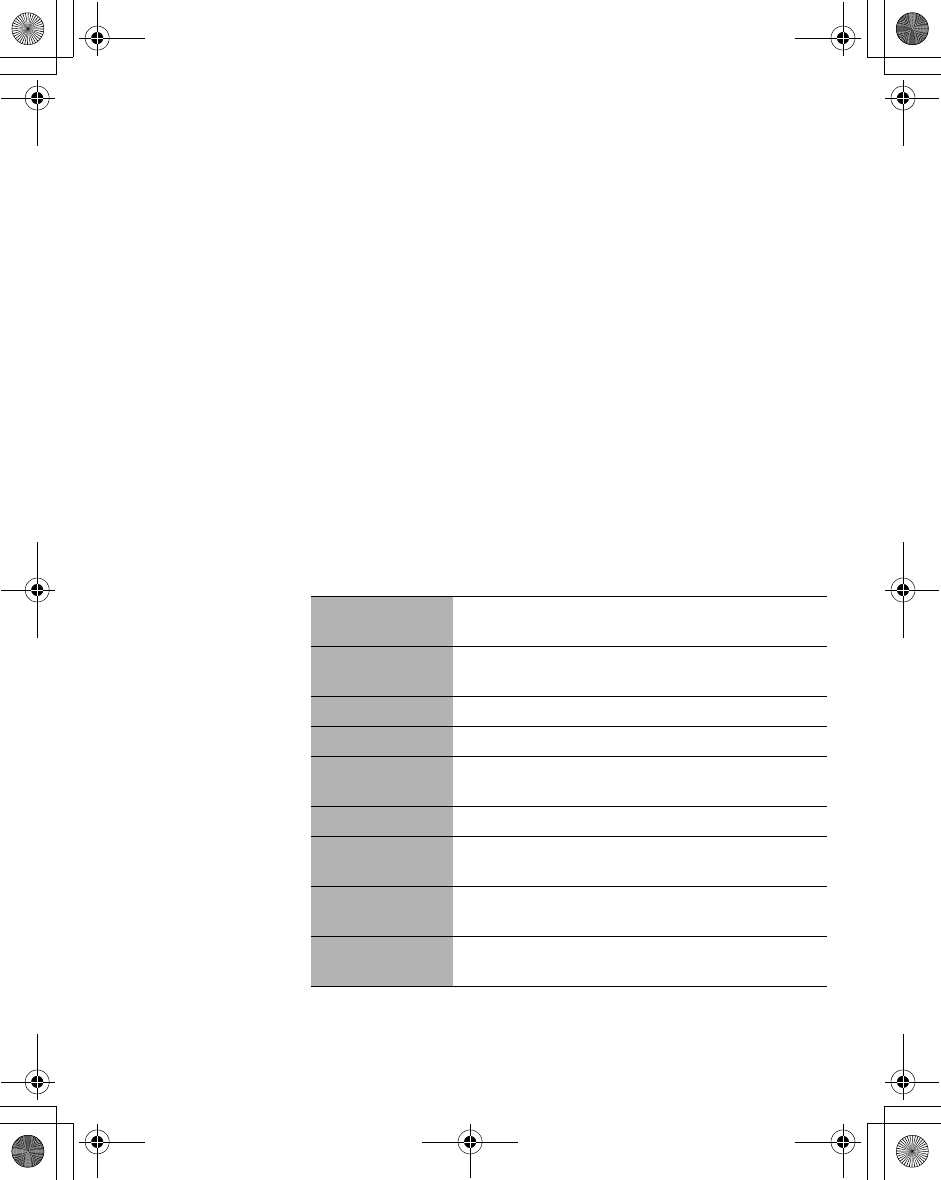
Browser Menu 57
Those configuration options will be given by your network service
provider.
After completing the entry, press A(Save), then press
A(Launch).
The first time that the Browser is activated there will be no content
stored so the Home URL content will be displayed (as defined by
the network operator). The Home URL will be recalled from the
cache each time the Browser is activated (the cache is the
phone's memory that stores content downloaded in the past).
Starting the Browser
From Browser
1. 4Start browser A(Select)
2. Follow the instructions on the display
ãWhile browsing a home page, press C.The menus below will be
displayed.
ãTo end the Browser, press and hold D.
Home Jump to the home page which is pre-defined in
Settings.
Bookmarks Select one of your bookmarks and jump to the page,
or bookmark the page.
Save Items Save items in the currently displayed page.
Reload Reload and update the currently displayed page.
Go To URL Enter a URL and jump to the currently displayed
page.
Show URL Display the URL of the currently displayed page.
SnapShots Capture the screen image of the currently displayed
page.
Advanced Inbox,Restart Browser and About can be
selected.
Settings Scroll Mode,Downloads,Security,View Title
Region and Send Referrer can be selected.
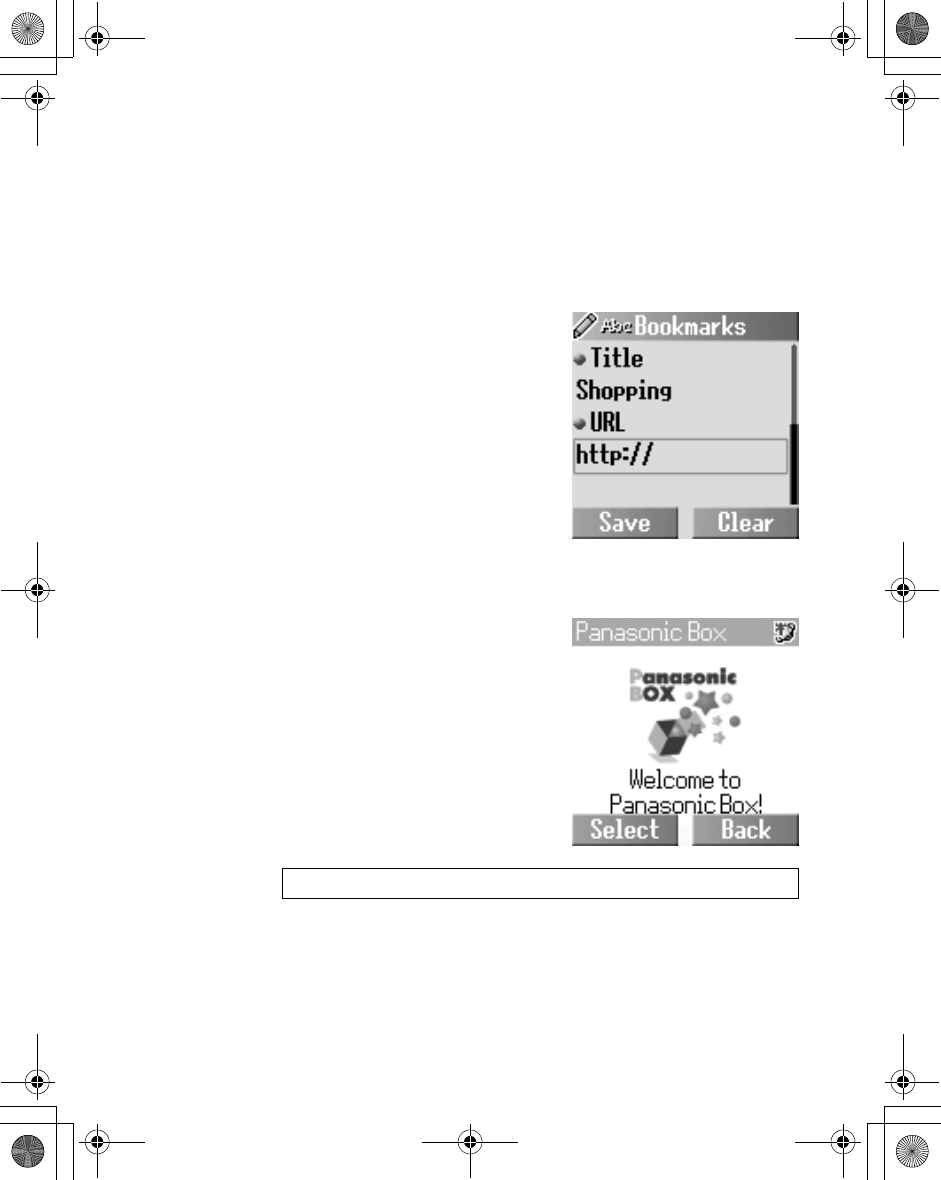
58 Browser Menu
Bookmarks
Once you set your favourite page as a bookmark, you can quickly
jump to the page.
Adding the Bookmark from the Browser menu
From Browser
1. 4Bookmarks A(Select)
2. 4 required empty bookmark
A(Options)
3. 4Edit A(Select)
4. Enter the title and URL
A(Save)
Adding the Bookmark to the home page
1. 4Start browser A(Select)
2. 4Bookmarks A(Select)
3. 4Mark Site A
4. Enter the URL A(Save)
To bookmark Panasonic Box:
Enter
http://wap.panasonicbox.com
in step 4, then press A to save.
NOTE: Panasonic Box is network dependent.
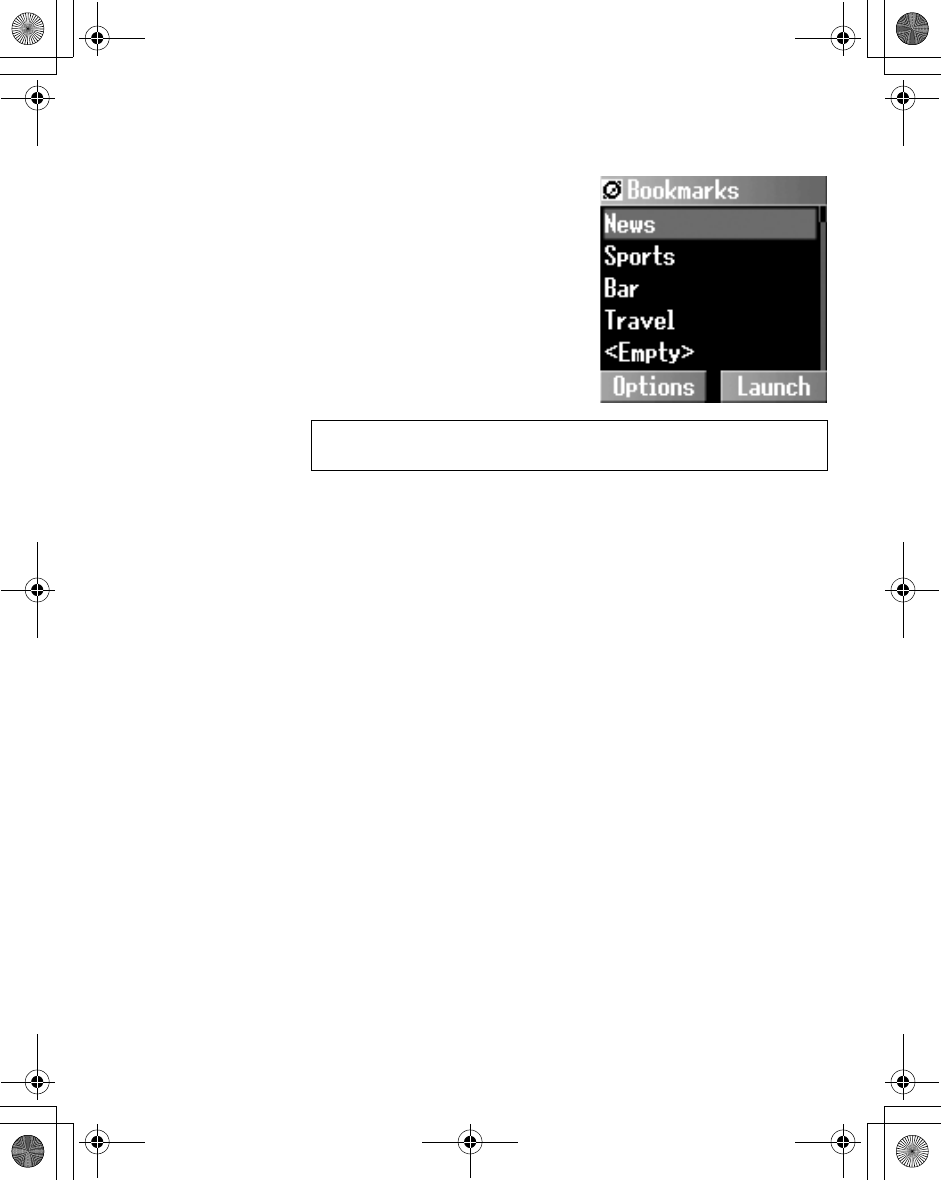
Browser Menu 59
Viewing the Bookmark
From Browser
1. 4Bookmarks A(Select)
2. 4 required bookmark
A(Options)
3. 4Launch A(Select)
OR
@(Launch) after selecting the
required bookmark
Push setting
You can set the push setting to decide how you want to receive
push messages sent by your service provider.
From Browser
1. 4Push setting A(Select)
2. 4Always all,Always none or Always this specific SMS
centre A(Select)
NOTE: This service is network dependent or may only be available on a
subscription basis.
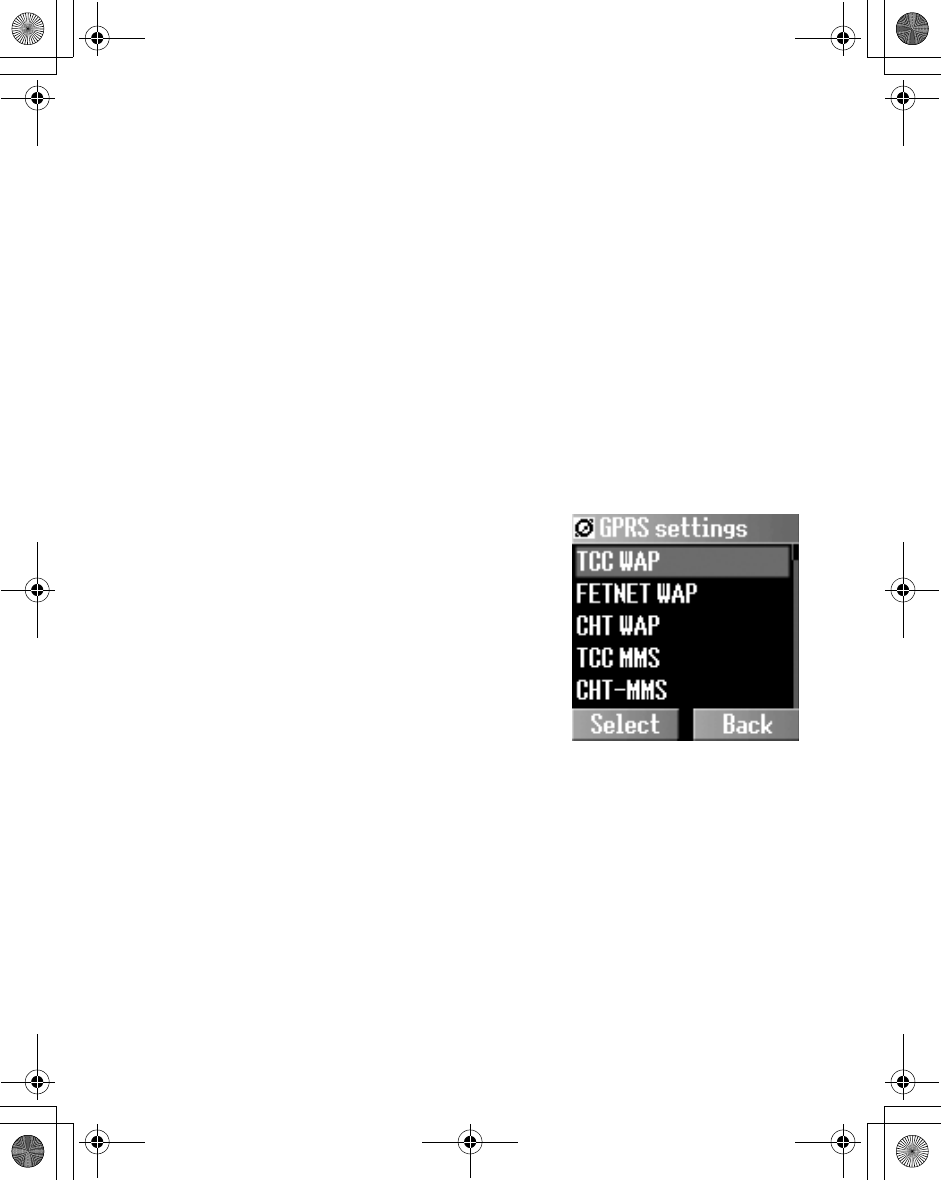
60 Browser Menu
Connectivity
You must set the data connections (GPRS and CSD settings)
before setting the server information.
From Browser
1. 4Connectivity A(Select)
2. 4CSD settings,GPRS settings or GPRS Info
A(Select)
3. 4 required setting A(Select)
4. Edit the required information A(Save)
You can edit the following after selecting the required connection
setting:
CSD settings:
- Server name
- Call type (ISDN/Analogue)
- Dial number
- Login name
- Password
GPRS settings:
- Server name
- GPRS APN
- Login name
- Password
- Authentication (Activate/
Deactivate)
GPRS Info:
You can also select the GPRS info in step 2 to view the memory
and duration of the GPRS service used.
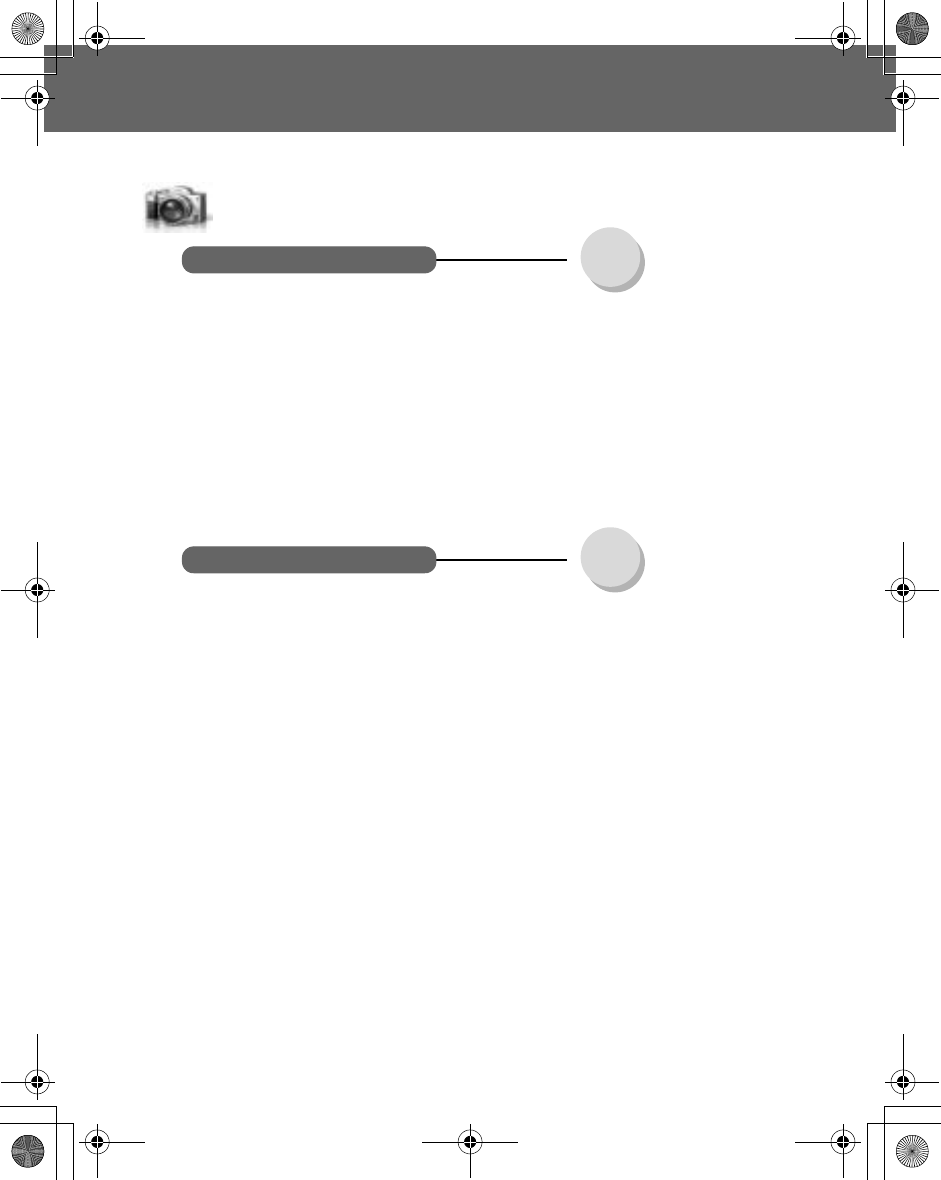
Camera Menu 61
Camera Menu
Camera
Video
Video Preview mode
Quality .................................... 70
Default settings.......................70
Still Picture mode
Play......................................... 71
Viewfinder...............................71
Send via MMS ........................71
View videos ............................ 72
Camera
Camera Preview mode
Self timer ................................ 66
Frame ..................................... 66
Image size .............................. 67
Quality .................................... 67
Brightness...............................68
Special effects ........................68
Twilight ................................... 68
Close up mode ....................... 69
Anti flicker...............................69
Default settings.......................69
Still Picture mode
Viewfinder...............................64
Send via MMS ........................64
Set as wallpaper..................... 65
View pictures ..........................65
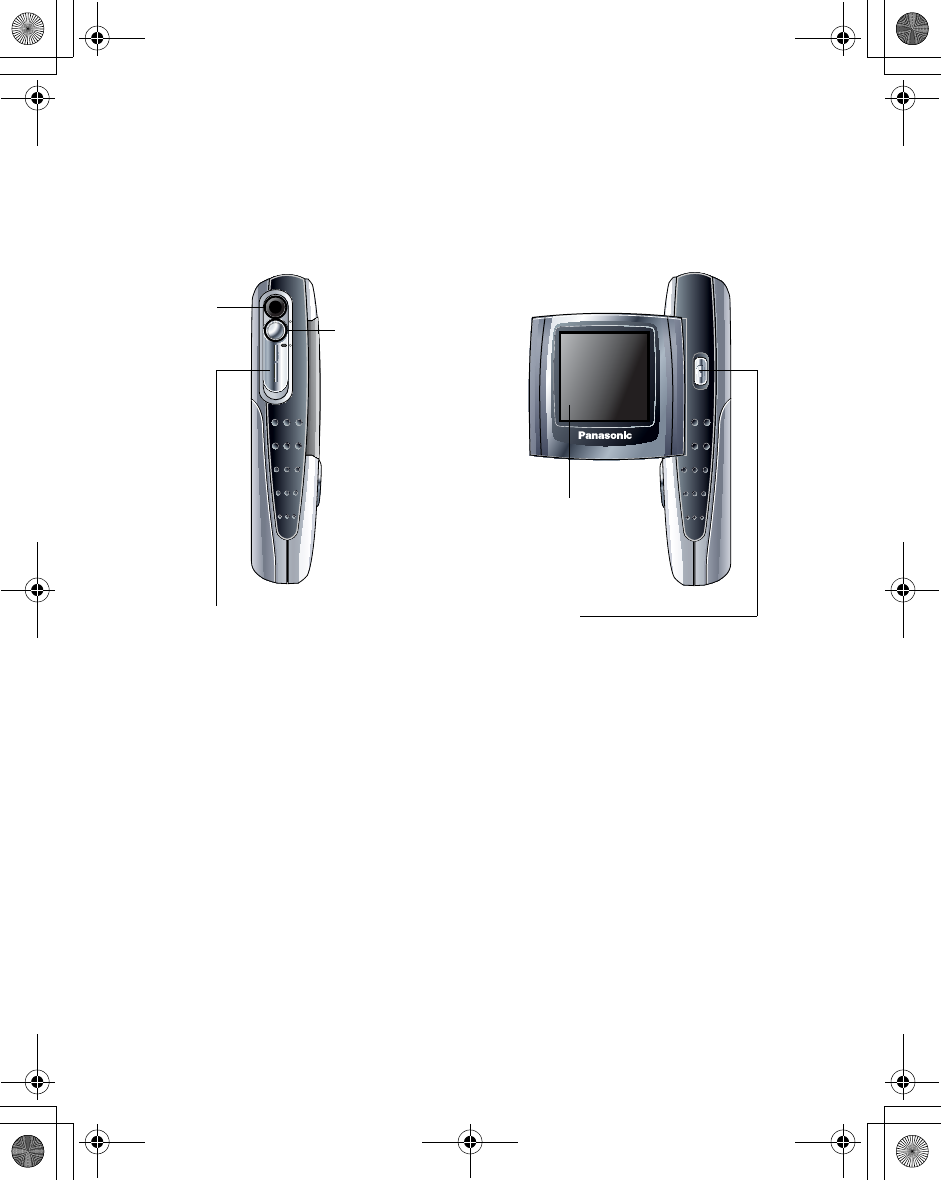
62 Camera Menu
Your camera
(Left side view) (Right side view: LCD Open)
Shutter Key:
Press to take a picture or record a video clip.
If the Camera Preview mode is not on even with
the Lens Cover open, press to turn the Camera
Preview mode on.
LCD
Lens Cover:
Slide the cover halfway down to turn the Camera
Preview mode on. When the cover is in the
uppermost position, the Camera Preview mode
is off. When the cover is slid all the way down,
the LCD pops open.
Camera Lens
Self-portrait Mirror
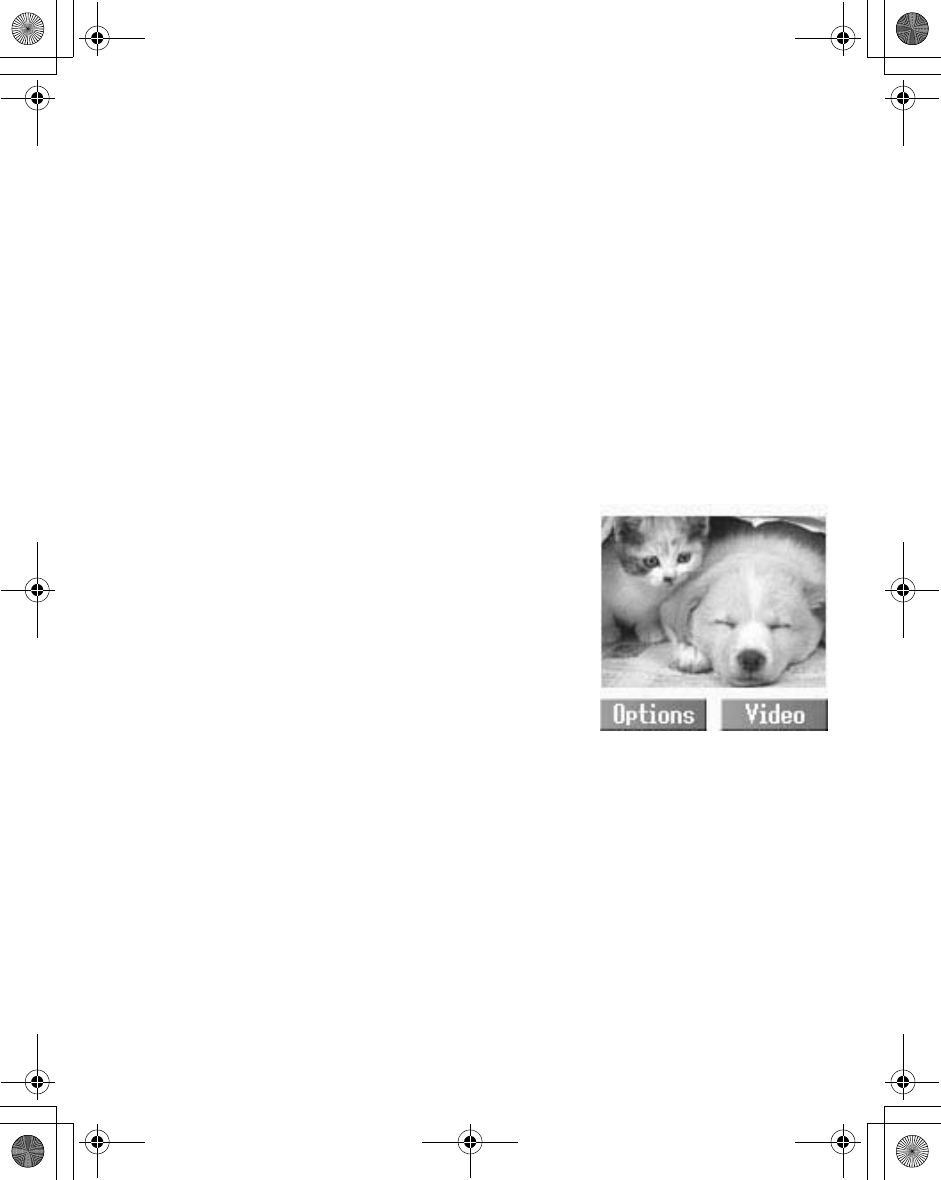
Camera Menu 63
Taking a picture
You can take pictures with the built-in camera and send them in
multimedia (MMS) e-mail messages. You can also use them as
wallpaper.
Camera Preview mode:
In Idle mode or from the Camera menu, slide the Lens Cover
halfway down to launch the Camera Preview mode. You can also
turn the Camera Preview mode on by pressing the Shutter Key if
the Camera Preview mode is not on even with the Lens Cover
open.
Still Picture mode:
In Camera Preview mode, press the Shutter Key to take a picture.
The display then turns into the Still Picture mode.
In Camera Preview mode
Press the Shutter Key to take a
picture
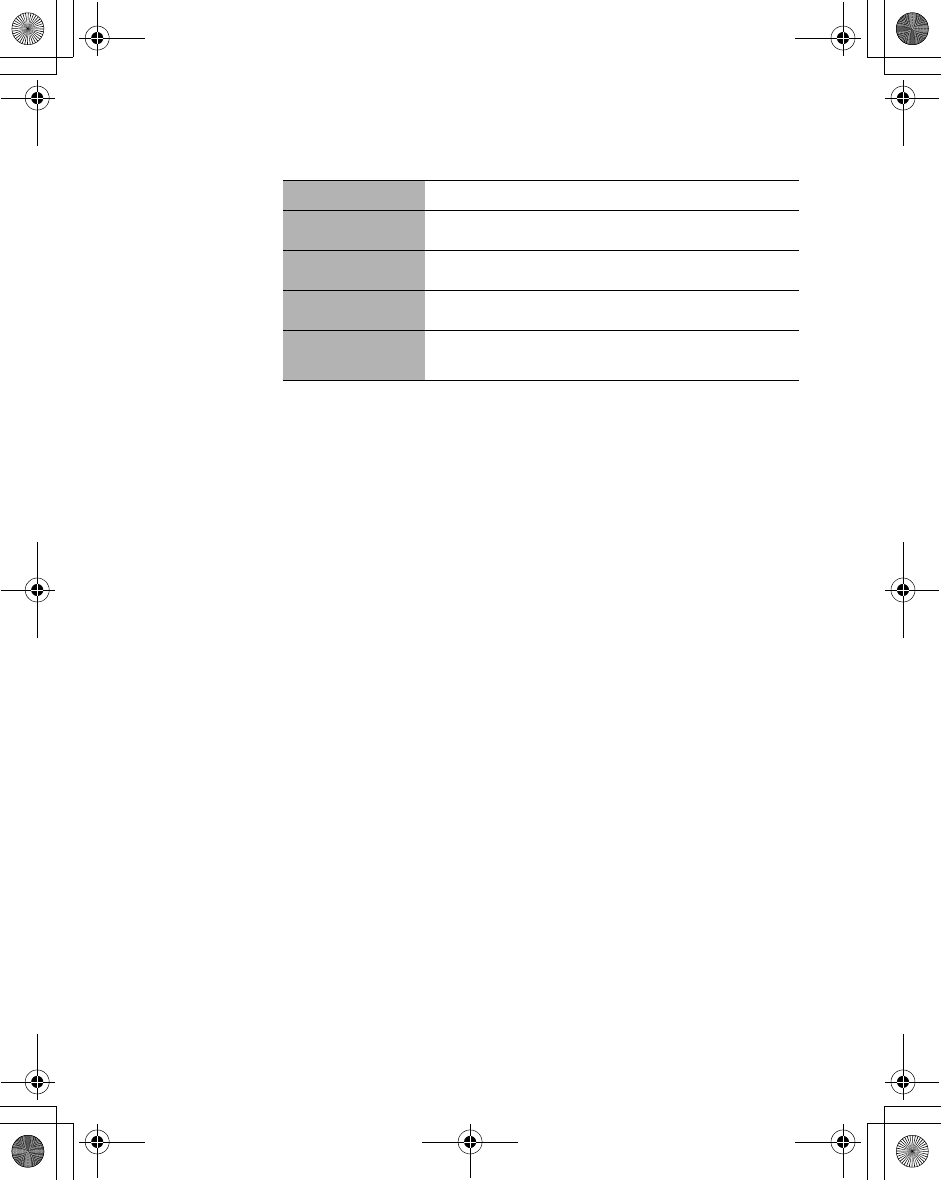
64 Camera Menu
Key functions in Camera Preview mode
Zoom
In Camera Preview mode
Press 1 to zoom in or 5 to zoom out.
Viewfinder
In Still Picture mode
1. A(Options)
2. 4Viewfinder A(Select)
ãThe viewfinder brings you back to the Camera Preview mode.
Sending the picture via MMS
In Still Picture mode
1. A(Options)
2. 4Send via MMS A(Select)
3. @(Insert) to add multimedia files
4. A(Options)
5. 4Send via MMS A(Select)
6. Enter the required information A(Options)
7. 4Send A(Select)
Key Function
1Press to zoom in.
5Press to zoom out.
!Press to activate the camera function menu.
"Press to display the camera function icons.
To activate one of the functions, press $ ~ ).
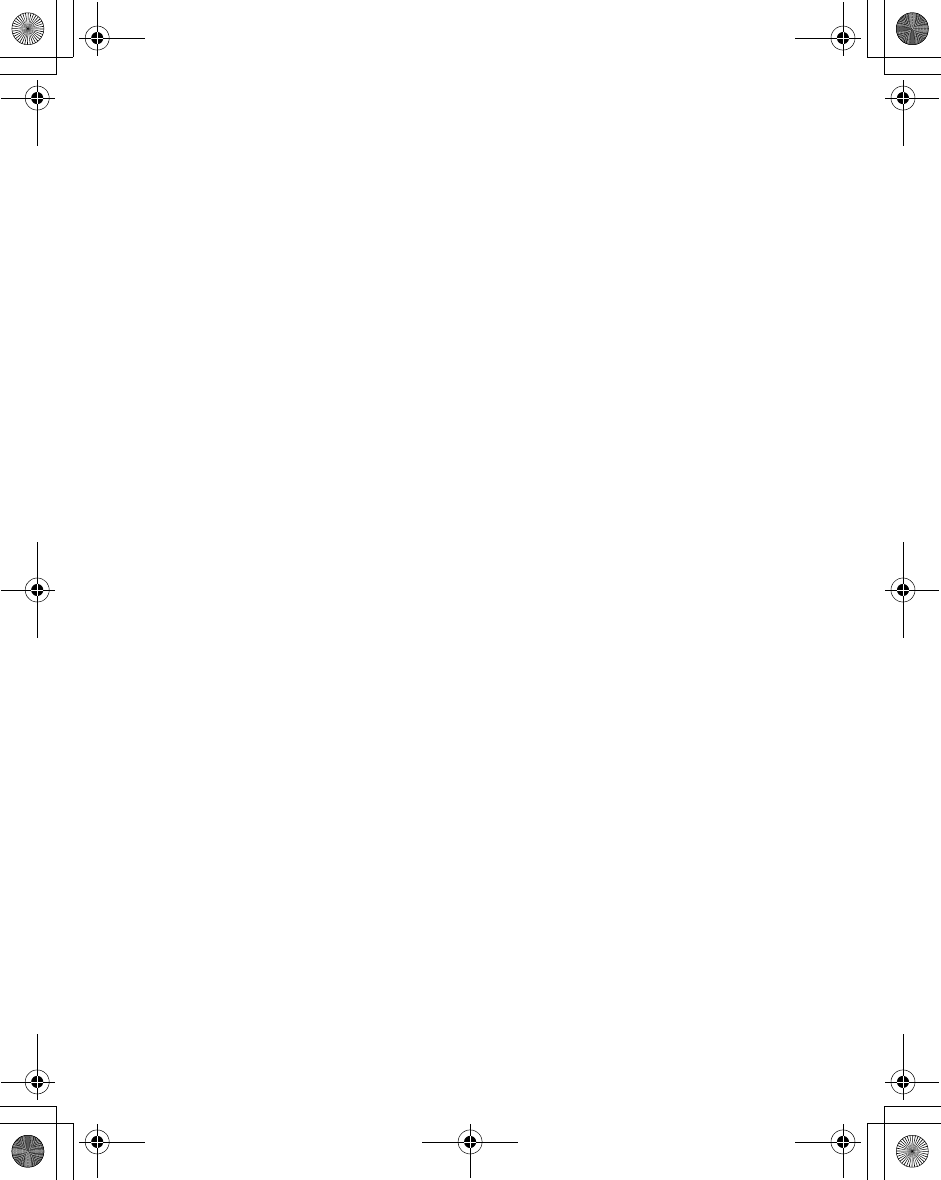
Camera Menu 65
Setting the picture as Wallpaper
In Still Picture mode
1. A(Options)
2. 4Set as wallpaper A(Select)
Viewing the stored picture
In Still Picture mode
1. A(Options)
2. 4View pictures A(Select)
3. 4 required picture A(Select)
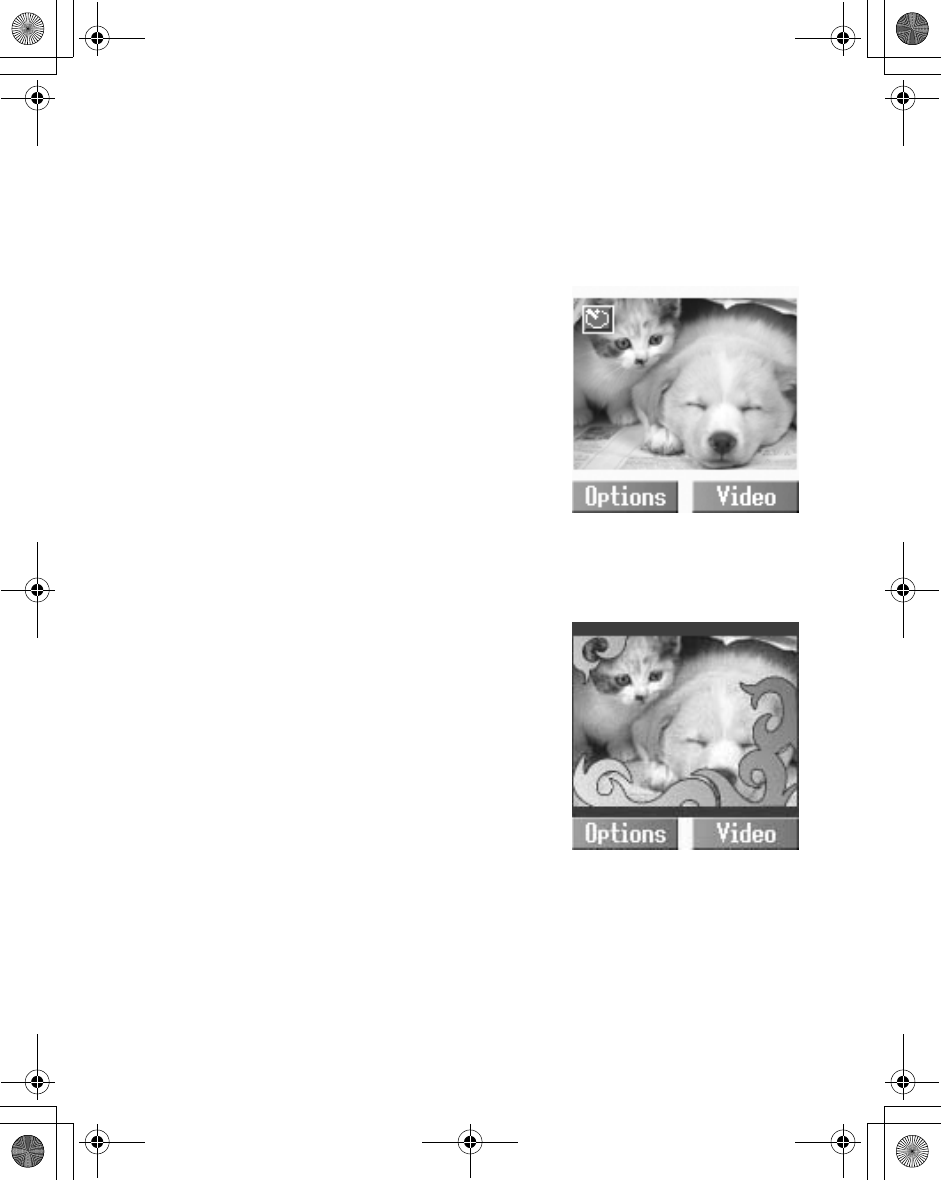
66 Camera Menu
Camera settings
Self timer
The self timer delays shooting for 10 seconds.
In Camera Preview mode
1. A(Options)
2. 4Self timer A(Select)
3. 4On or Off A(Select)
Frame
You can take a picture with a frame of your choice.
In Camera Preview mode
1. A(Options)
2. 4Frame A(Select)
3. 4Off or Frame 1~10
A(Select)
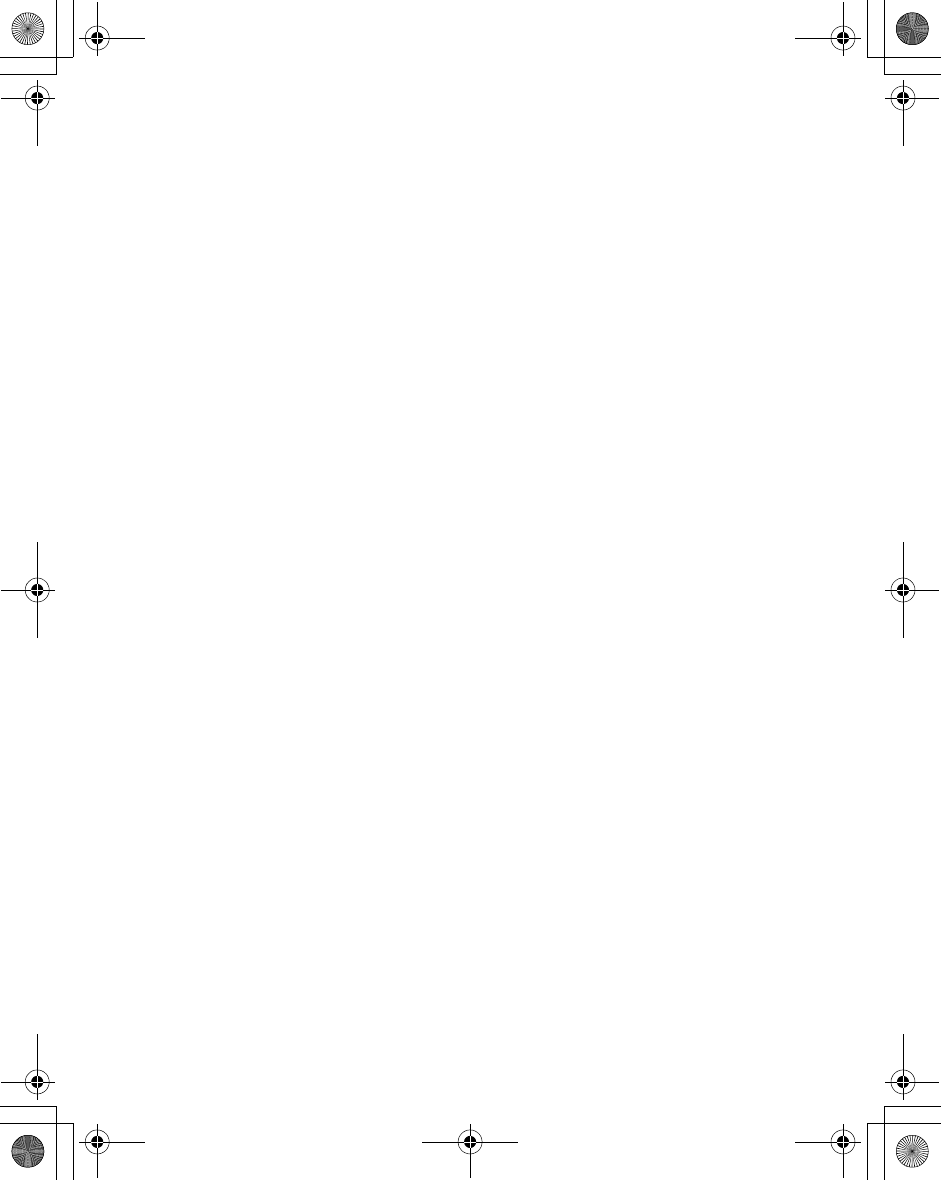
Camera Menu 67
Image size
You can make your picture larger or smaller.
In Camera Preview mode
1. A(Options)
2. 4Image size A(Select)
3. 4 required image size A(Select)
The following image sizes are available:
- VGA (640 x 480 pixels)
- CIF (352 x 288 pixels)
- QVGA (320 x 240 pixels)
- QCIF (176 x 144 pixels)
- QQVGA (160 x 120 pixels)
- Sub-QCIF (128 x 96 pixels)
Quality
You can choose the image quality of your picture.
In Camera Preview mode
1. A(Options)
2. 4Quality A(Select)
3. 4Fine (90%), Normal (80%) or Economy (50%)
A(Select)
ãFine produces a large file with a high resolution, while Economy
produces a small file with a low resolution.
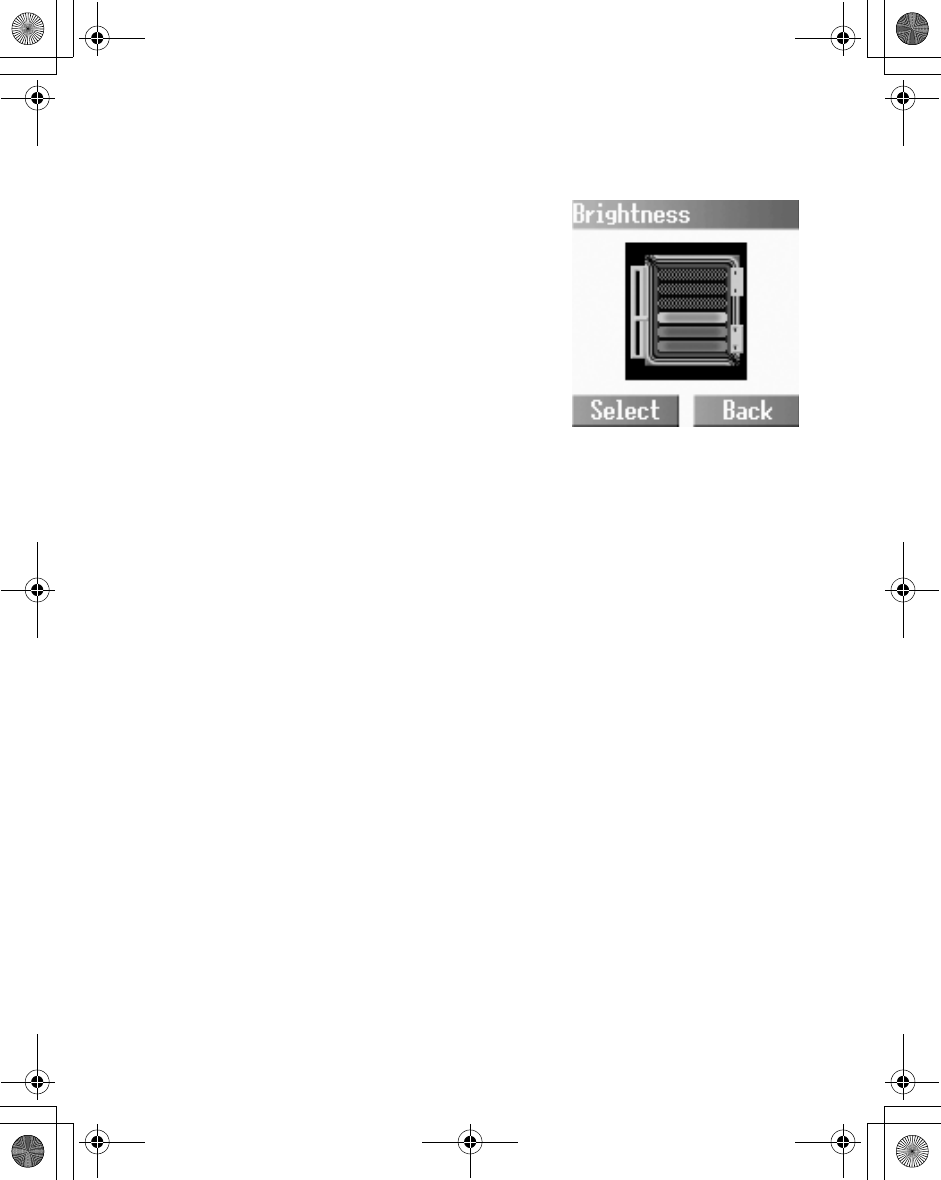
68 Camera Menu
Brightness
You can adjust the brightness in 5 steps.
In Camera Preview mode
1. A(Options)
2. 4Brightness A(Select)
3. 4 Adjust the brightness
A(Select)
Special effects
You can change your picture’s colours.
In Camera Preview mode
1. A(Options)
2. 4Special effects A(Select)
3. 4Normal,Mono,Sepia or Bluish A(Select)
Twilight
You can turn the Twilight mode on when taking a picture in low
light conditions.
In Camera Preview mode
1. A(Options)
2. 4Twilight A(Select)
3. 4On or Off A(Select)
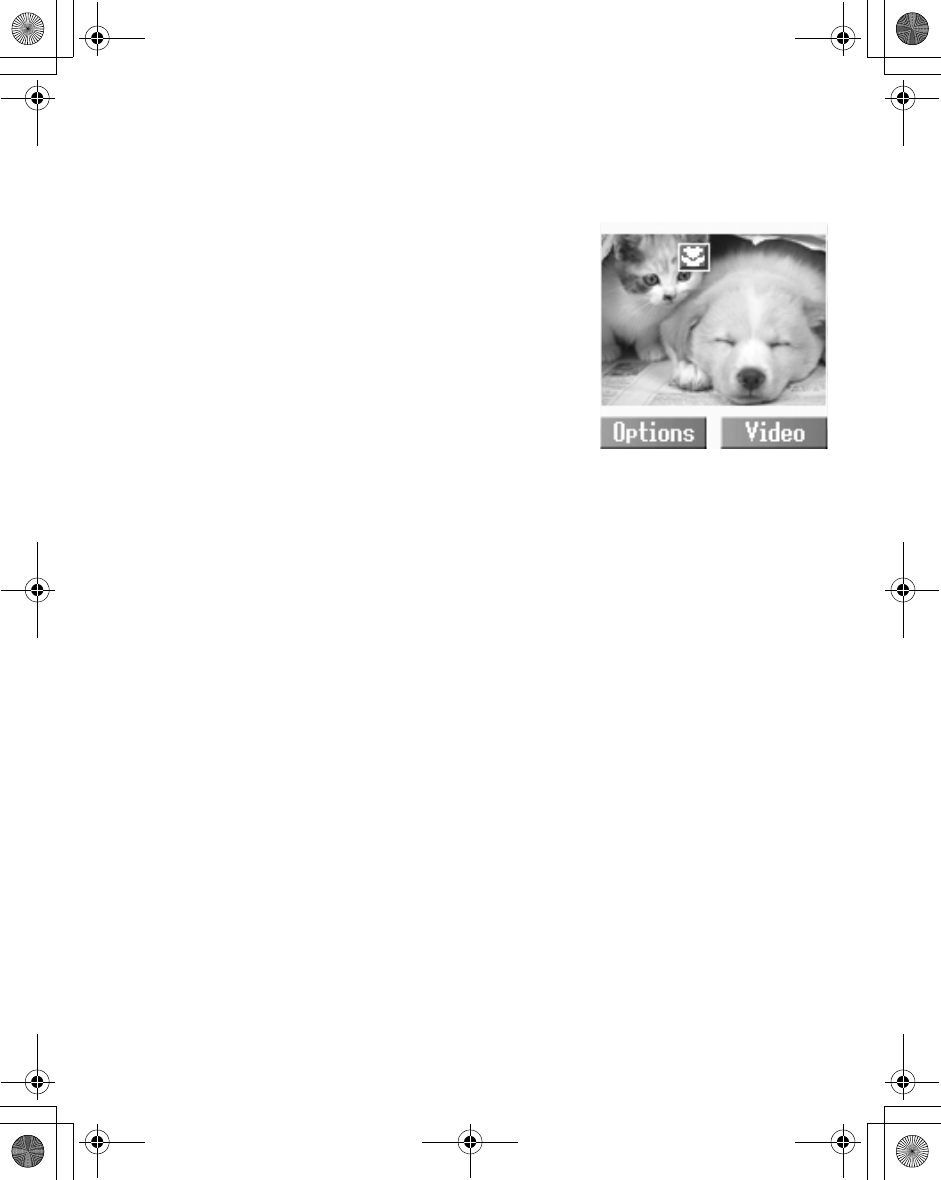
Camera Menu 69
Close up mode
You can turn the close up mode on when taking a picture at a
close range.
In Camera Preview mode
1. A(Options)
2. 4Close up mode
A(Select)
3. 4On or Off A(Select)
Anti flicker
The anti flicker indicates how many times an image appears on a
display per second. The higher the anti flicker, the less obvious
the screen flicker is.
In Camera Preview mode
1. A(Options)
2. 4Anti flicker A(Select)
3. 450 (Hz) or 60 (Hz) A(Select)
Default settings
All personal settings can be returned to their factory default
settings.
In Camera Preview mode
1. A(Options)
2. 4Default settings A(Select)
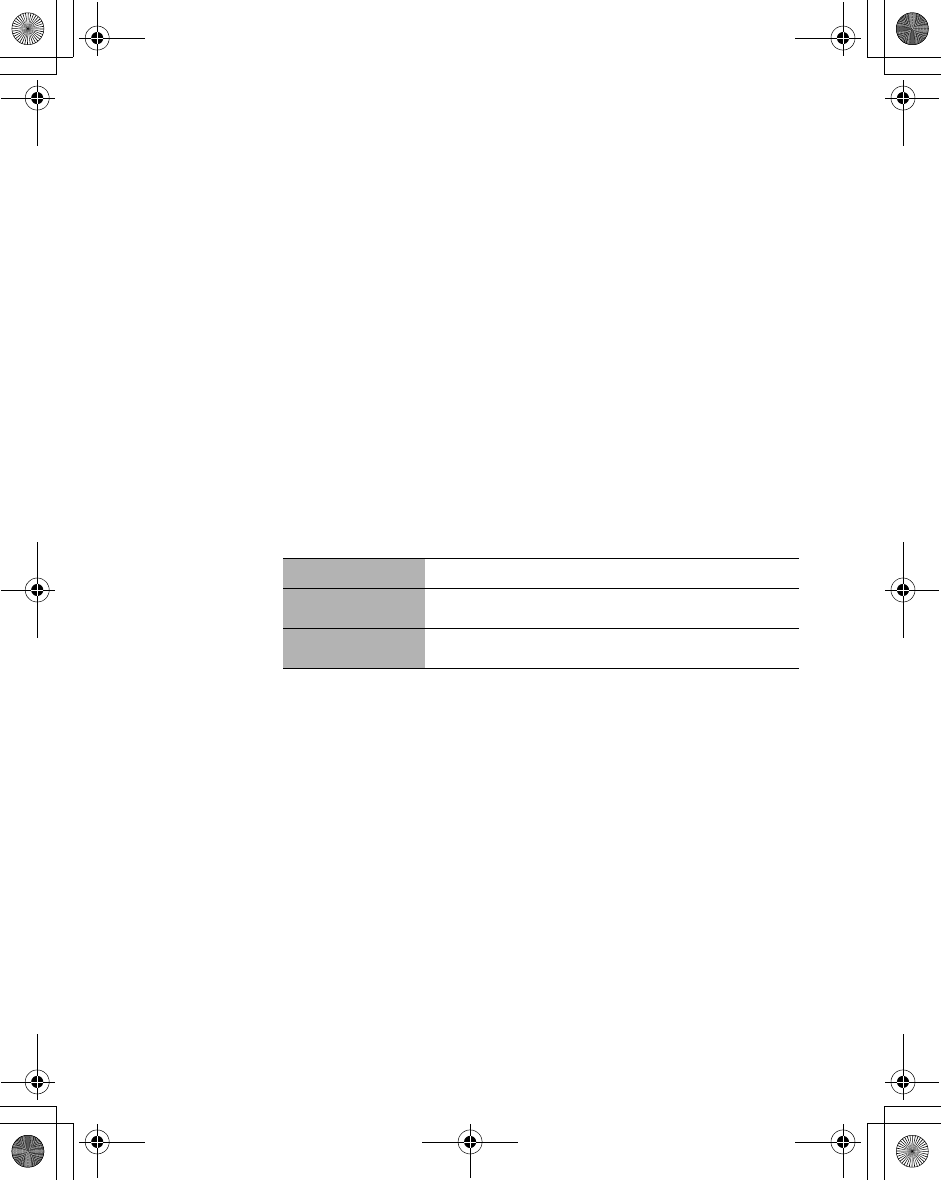
70 Camera Menu
Recording a video clip
While the Camera Preview mode is active, the camera can be
switched to a video recorder.
Video Preview mode:
In Idle mode or from the Camera menu, slide the Lens Cover
halfway down and press the Right Soft Key to launch the Video
Preview mode. You can also turn the Video Preview mode on by
pressing the Shutter Key followed by the Right Soft Key.
Still Picture mode:
In Video Preview mode, press the Shutter Key to record a video
clip. The display then turns into the Still Picture mode.
To switch the Camera Preview mode to the Video Preview mode:
press @.
Key functions in Video Preview mode
Quality
In Video Preview mode
1. A(Options)
2. 4Quality A(Select)
3. 4Fine,Normal or Economy A(Select)
Default settings
In Video Preview mode
1. A(Options)
2. 4Default settings A(Select)
Key Function
!Press to activate the video function menu.
"Press to display the video function icon.
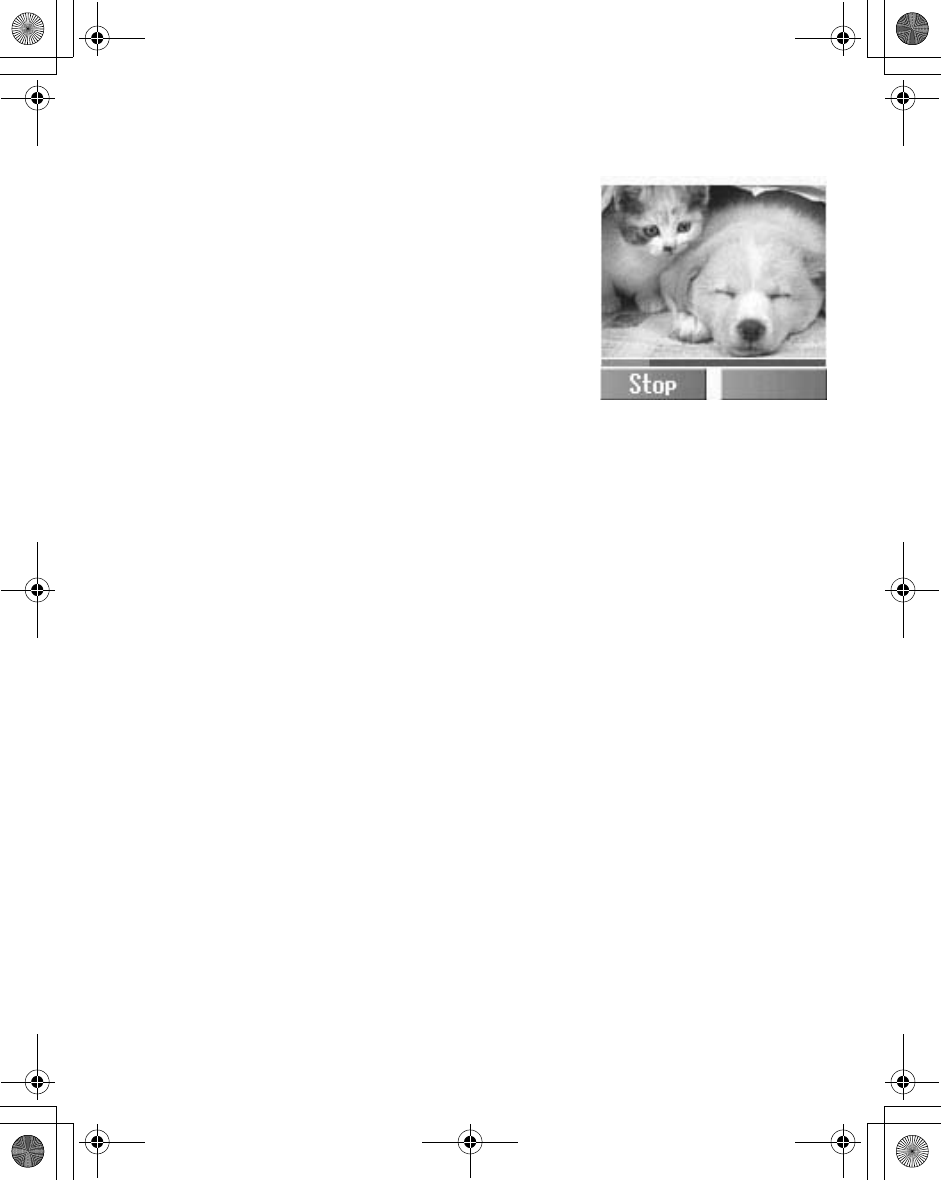
Camera Menu 71
Recording
In Video Preview mode
Press the Shutter Key to start
recording a video clip
Press the Shutter Key once more to
stop recording a video clip.
Playing the video clip
In Still Picture mode
1. A(Options)
2. 4Play A(Select)
Viewfinder
In Still Picture mode
1. A(Options)
2. 4Viewfinder A(Select)
Sending the video clip via MMS
In Still Picture mode
1. A(Options)
2. 4Send via MMS A(Select)
3. @(Insert) to add multimedia files
4. A(Options)
5. 4Send via MMS A(Select)
6. Enter the required information A(Option)
7. 4Send A(Select)
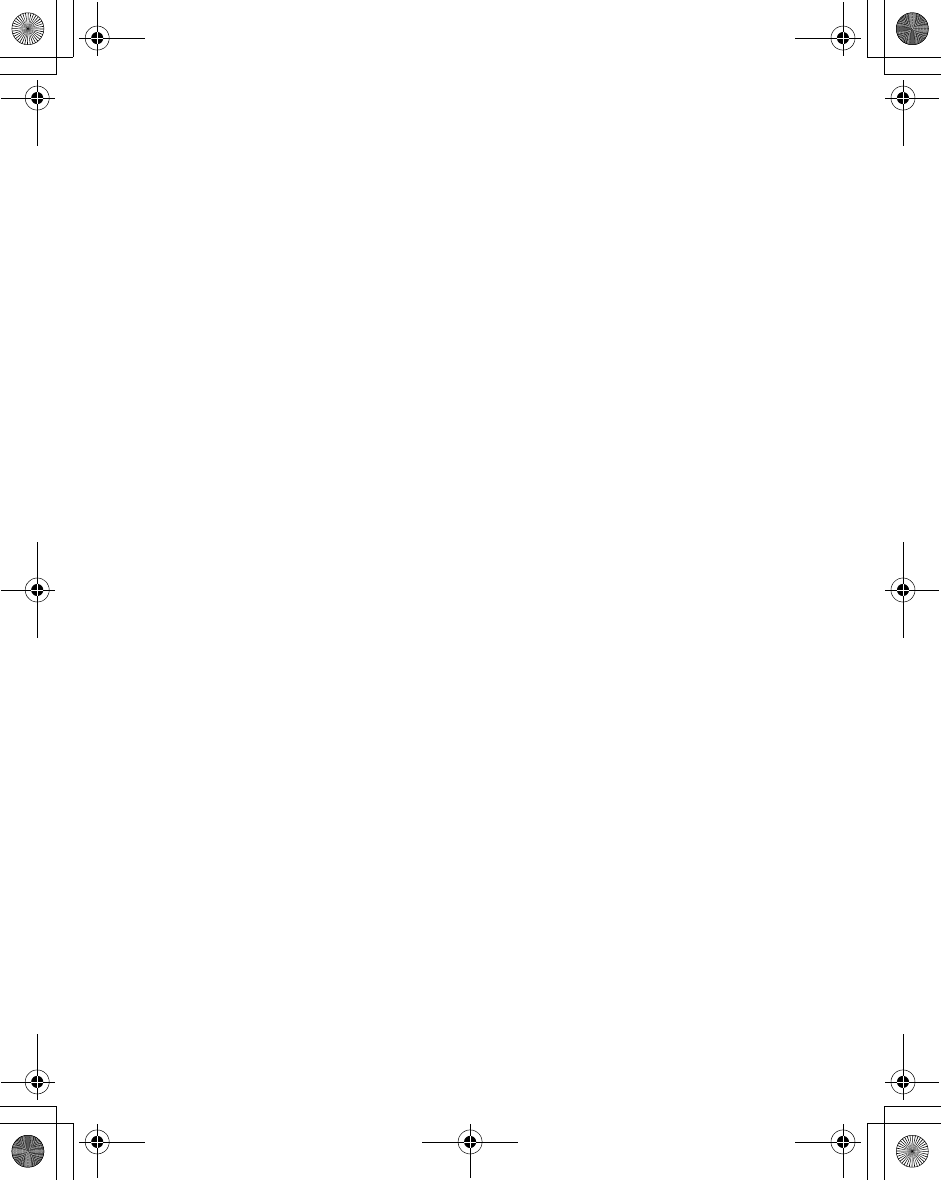
72 Camera Menu
Viewing the stored video clips
In Still Picture mode
1. A(Options)
2. 4View videos A(Select)
3. 4 required video clip A(Select)
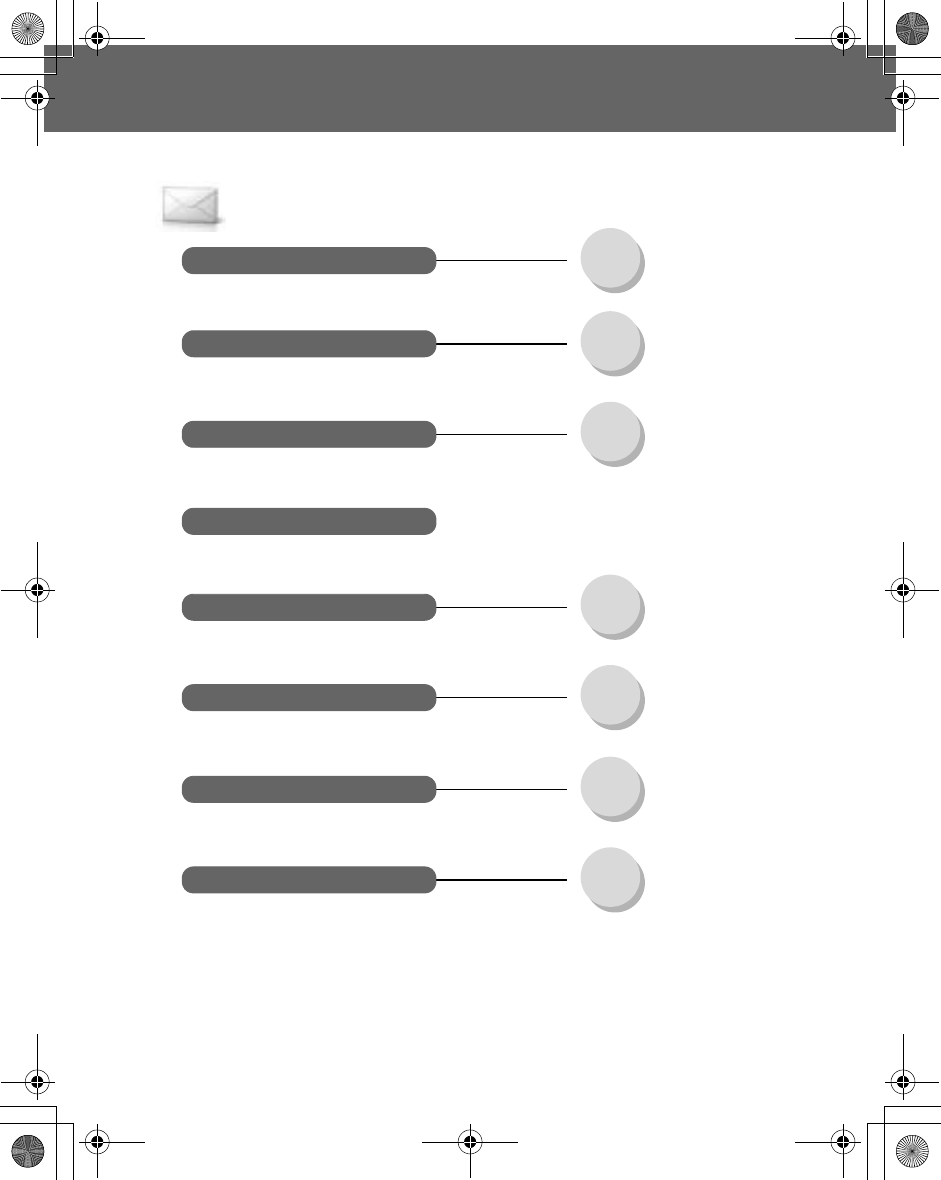
Messages Menu 73
Messages Menu
Messages
User Messages
Cell Broadcast
Create MMS.......................................... 76
SMS........................................... 82
Outbox
Memory status
Settings
Inbox MMS ..........................................78
SMS........................................... 83
MMS..........................................80
SMS........................................... 84
MMS..........................................85
SMS........................................... 85
Auto display............................... 85
Read Messages ........................ 86
Message List ............................. 86
Topic list .................................... 86
Languages.................................87
MMS..........................................74
SMS........................................... 81
.......................................................................................84
Connectivity CSD settings ............................. 85
GPRS settings........................... 85
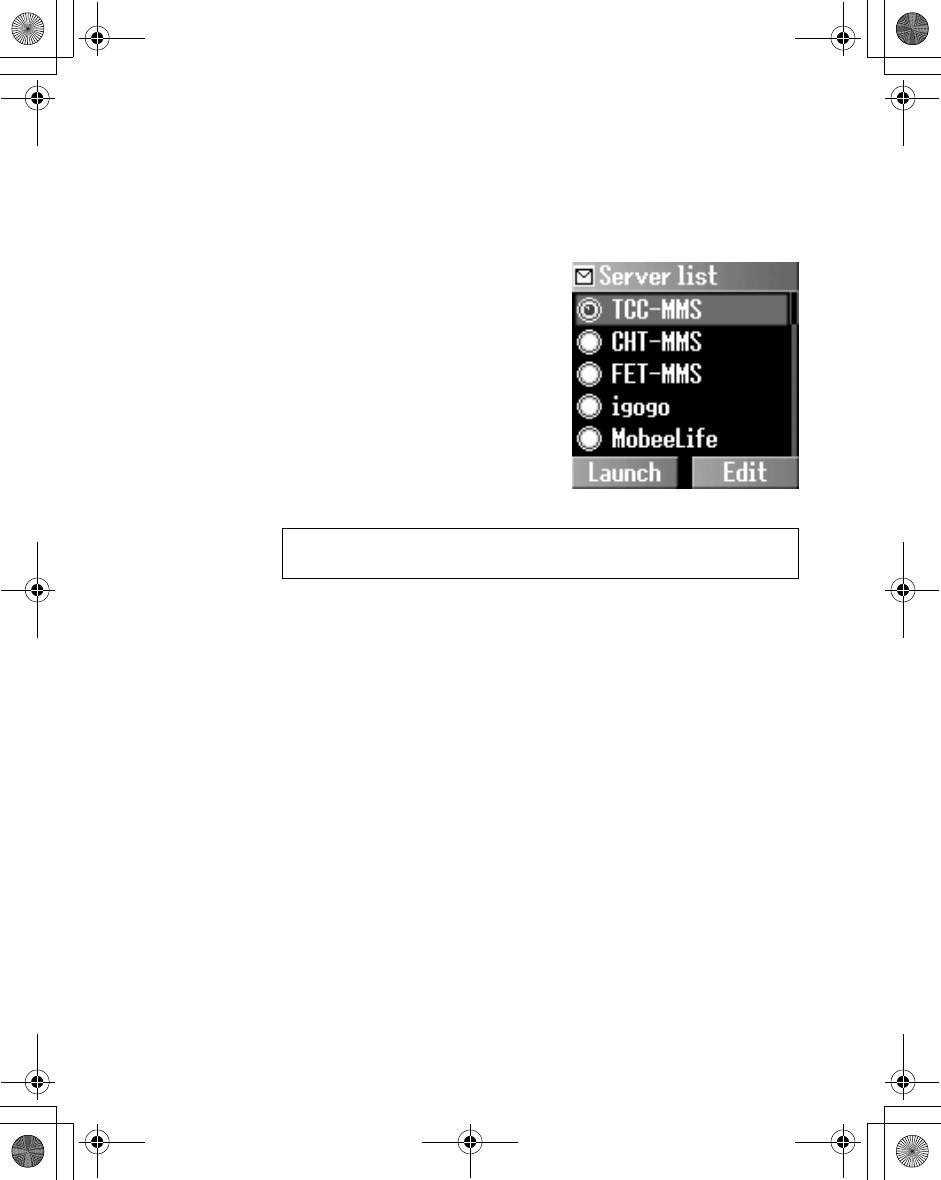
74 Messages Menu
MMS settings
Configuring MMS
From Messages
1. 4Settings A(Select)
2. 4MMS A(Select)
3. 4Server list A(Select)
4. 4 required server @(Edit)
Five server settings can be set up in the phone. If you find your
server’s name under the settings option, select the server and
@(Edit). If no settings are present, contact your network service
provider for these settings.
You can edit the following settings:
- Server name
- IP address
-IP port
- Homepage
-Linger time
- Connection (Auto, CSD or GPRS setting)
- CSD settings
- GPRS settings
NOTE: Your network operator may have pre-installed this number. Do
not change this number as it may cause failure of MMS messaging.
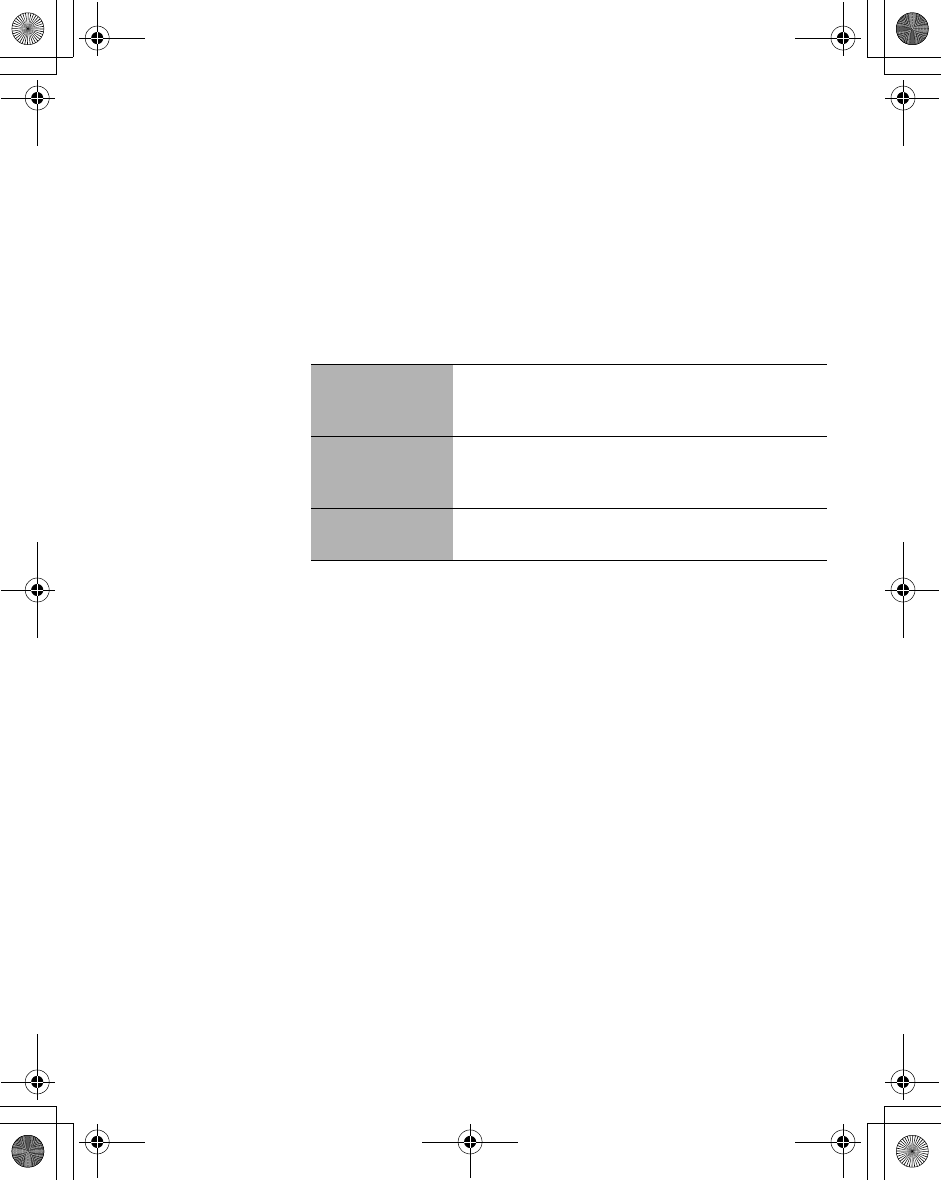
Messages Menu 75
Setting the Send Options
From Messages
1. 4Settings A(Select)
2. 4MMS A(Select)
3. 4Send Options A(Select)
4. 4 required send option A(Select)
The following Send options are available:
Setting the Receive Options
From Messages
1. 4Settings A(Select)
2. 4MMS A(Select)
3. 4Receive Options A(Select)
4. 4 required receive option A(Select)
Delivery report
Decide whether or not you want confirmation that
your message has been delivered.
Select On or Off.
Own address
Choose whether or not to let the recipient see your
address.
Select Show or Hide.
Priority Set the priority level for your sent messages.
Select High, Normal or Low.
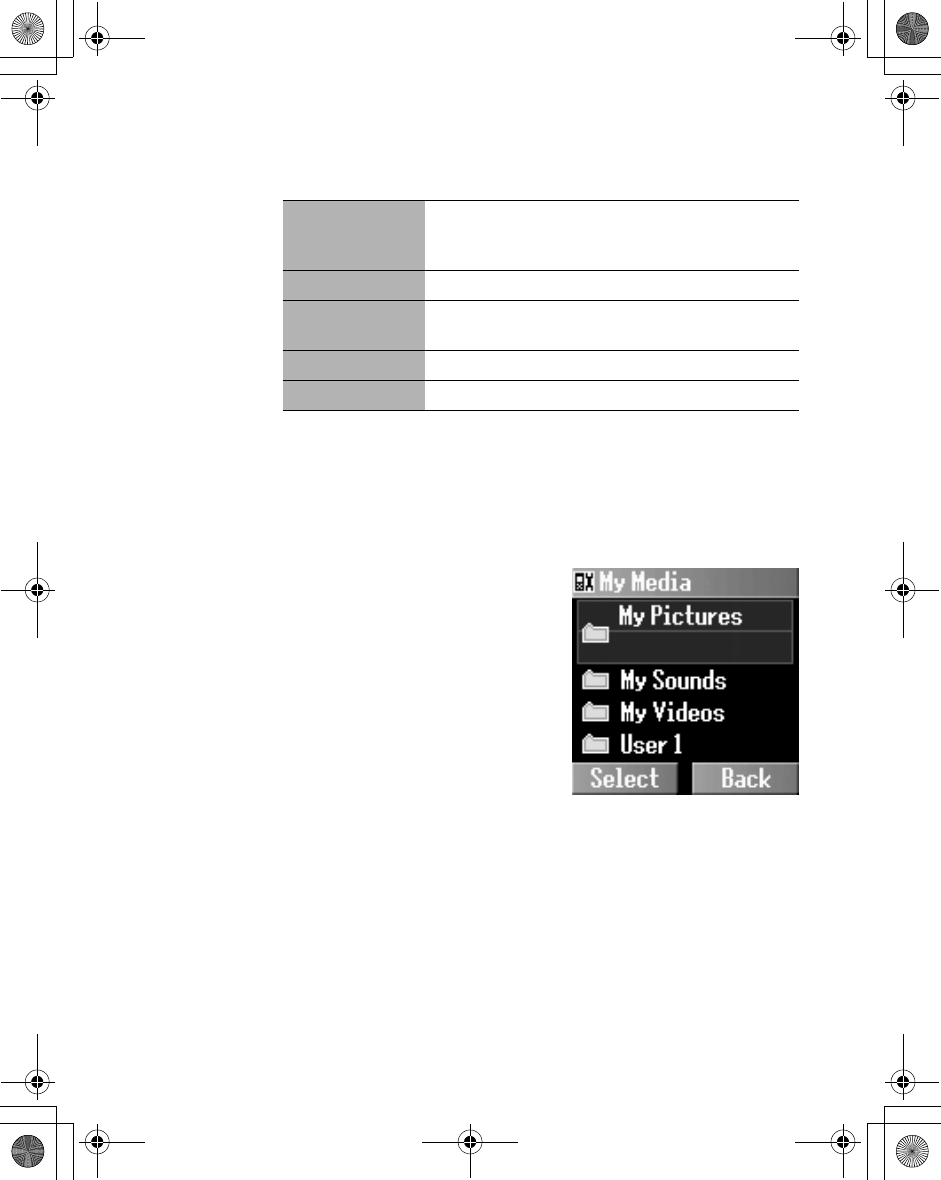
76 Messages Menu
The following receive options are available when you want to
decide how to deal with incoming MMS message:
Creating an MMS message
Inserting a multimedia file
From Messages
1. 4Create A(Select)
2. 4MMS A(Select)
3. @(Insert)
4. 4 required insert option
A(Select)
The following options are available
to select the required multimedia
file:
- Insert picture
- Insert text
- Insert video
- Insert sound
- Insert page
Validity period Set the duration that your message is stored at the
message centre. Select 1 Hour, 12 Hours, 1 Day,
1 Week or Maximum.
Normal Select Auto retrieve, Auto reject or Auto defer.
Anonymous
sender Select Auto retrieve or Auto reject.
Advertisements Select Auto retrieve or Auto reject.
Delivery report Select Permit or Reject.
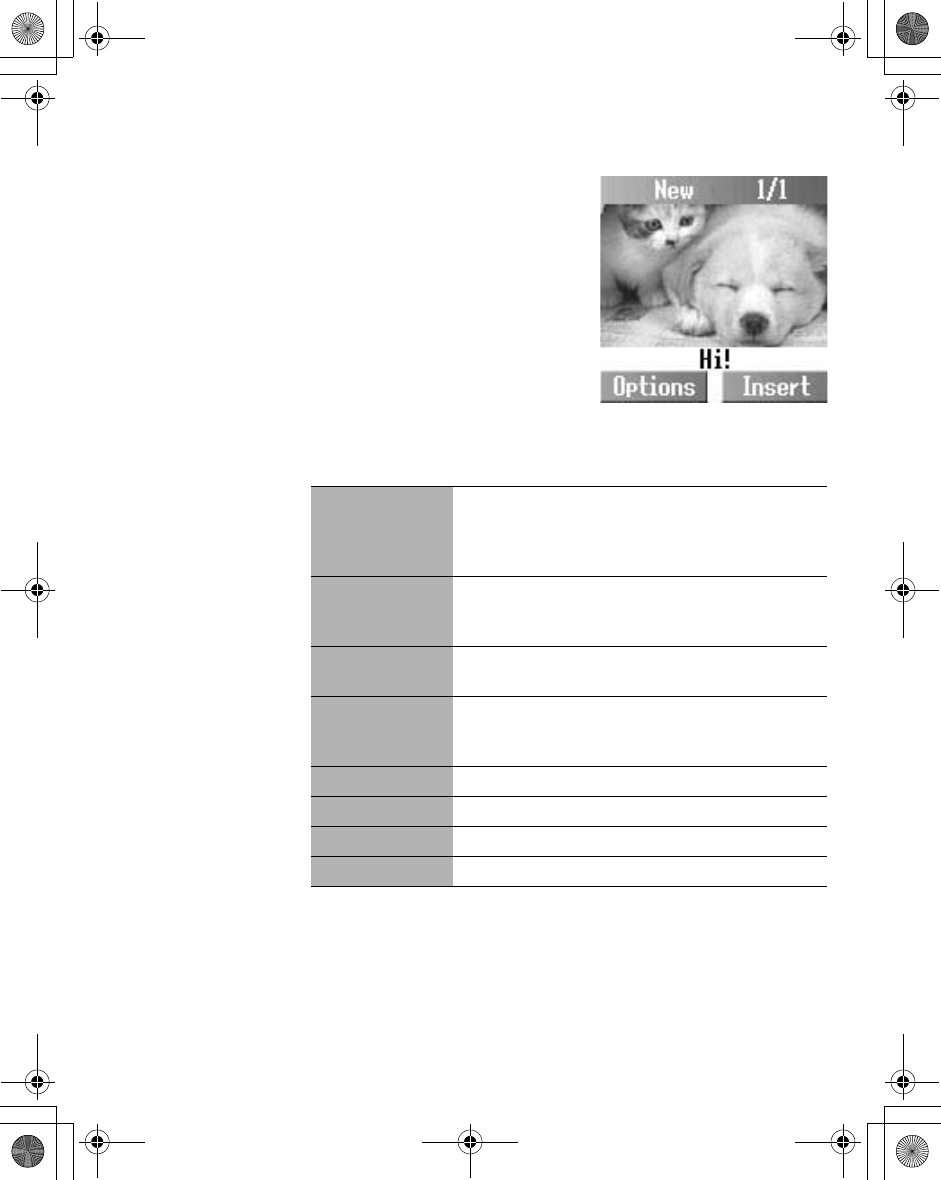
Messages Menu 77
MMS Options
From Messages
1. 4Create A(Select)
2. 4MMS A(Select)
3. @(Insert) to add the required
media A(Select)
4. A(Options)
5. 4 required option
A(Select)
After completing an MMS message, you can select one of the
following options:
.
Send MMS
Send the completed MMS message. Press
A(Options) to recall the Contacts list, then select
the recipient’s phone number. Press A(Options)
once more to send the message.
Store MMS Store the completed MMS message. Press
A(Select) to confirm that the message has been
saved.
Delete items Delete the selected text, picture, sound and/or video
clip.
Info Show the page timing, the type of image and/or
attached sound files, the message size, and the
resolution.
Page timing Set the time intervals at which each page is sent.
Delete page Delete the selected page.
Preview page Preview the selected page.
Preview MMS Preview the completed MMS message.
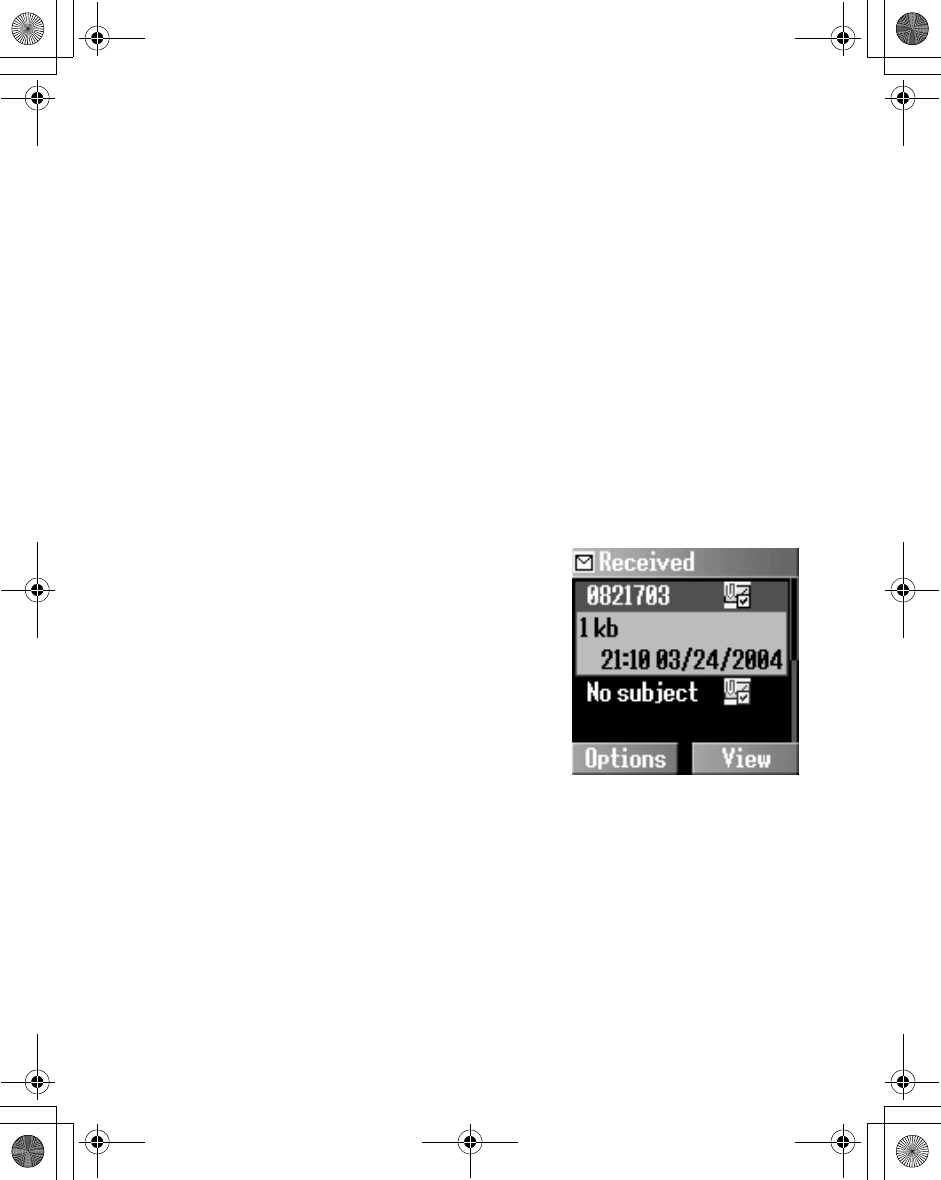
78 Messages Menu
Sending an MMS message
From Messages
1. 4Create A(Select)
2. 4MMS A(Select)
3. @(Insert) to add the required media A(Select)
4. A(Options)
5. 4Send MMS A(Select)
6. Enter the phone number
OR
A(Options) 4Contacts list A(Select) to select the
phone number
7. A(Options) Send A(Select)
Receiving an MMS message
From Messages
1. 4Inbox A(Select)
2. 4MMS A(Select)
3. 4Waiting A(Select)
4. 4 required MMS message
A(Select) > A(Receive) to
receive the remainder of the
MMS message
OR
4Received A(Select)